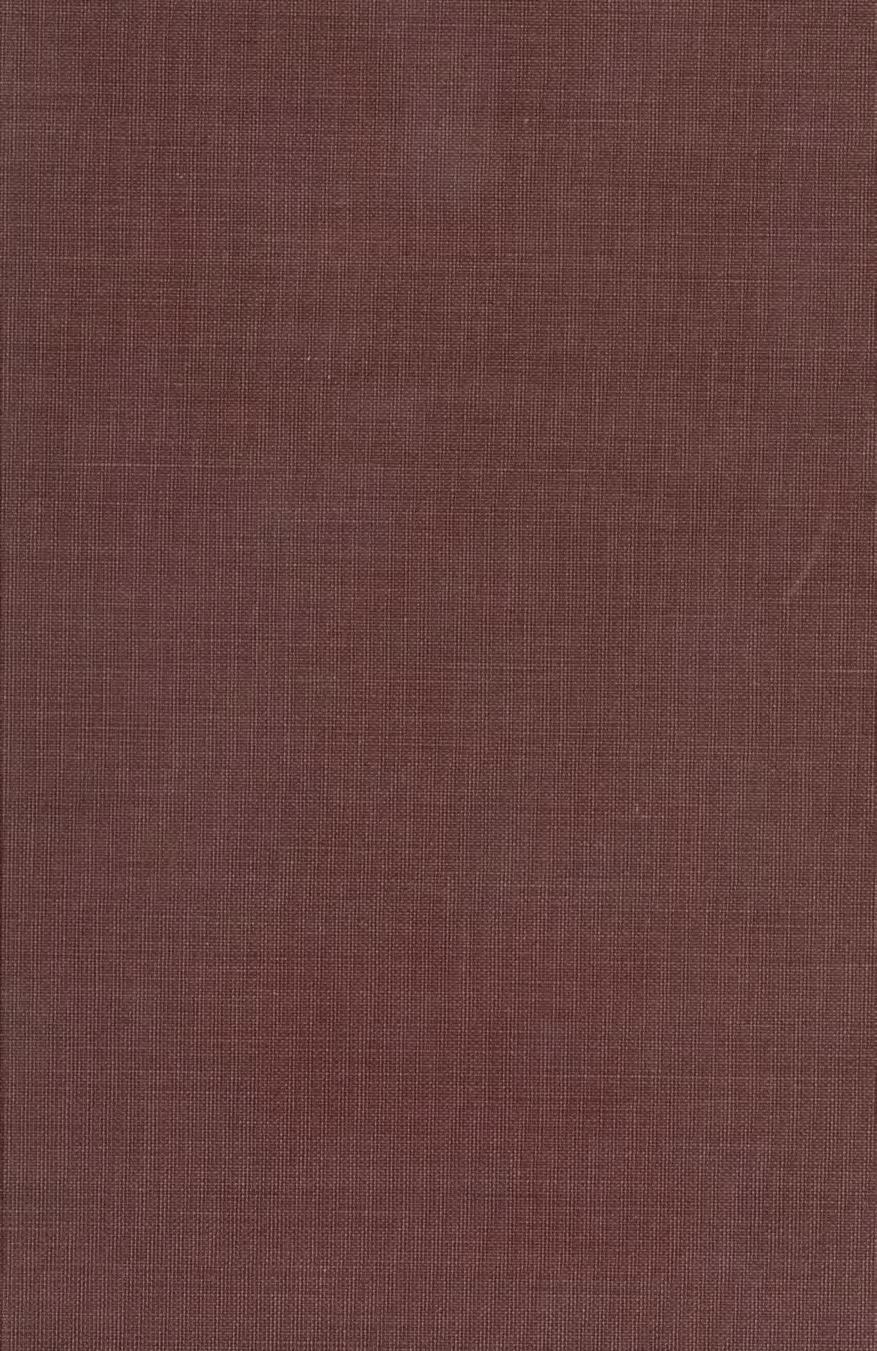


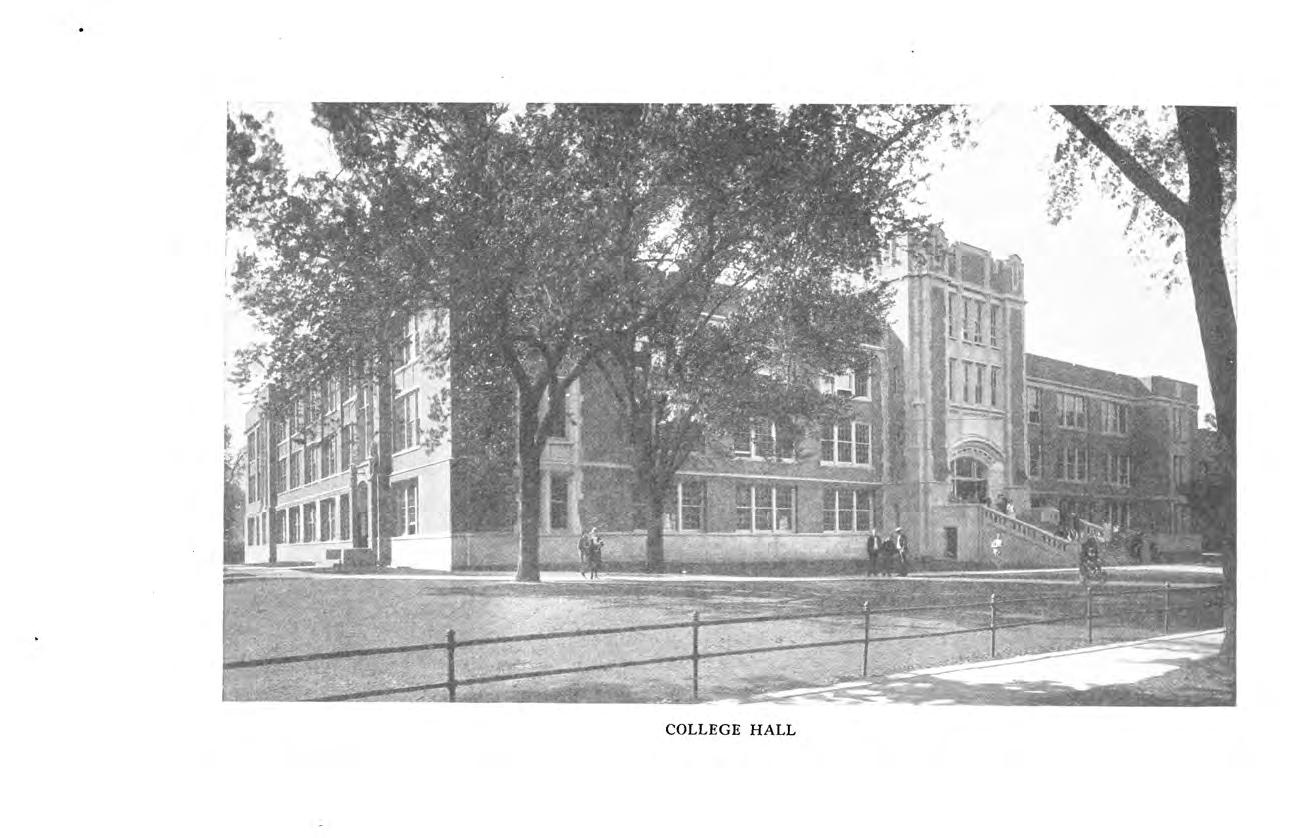





Historical Notes, 1910-1935

ERWIN S. SELLE, Editor

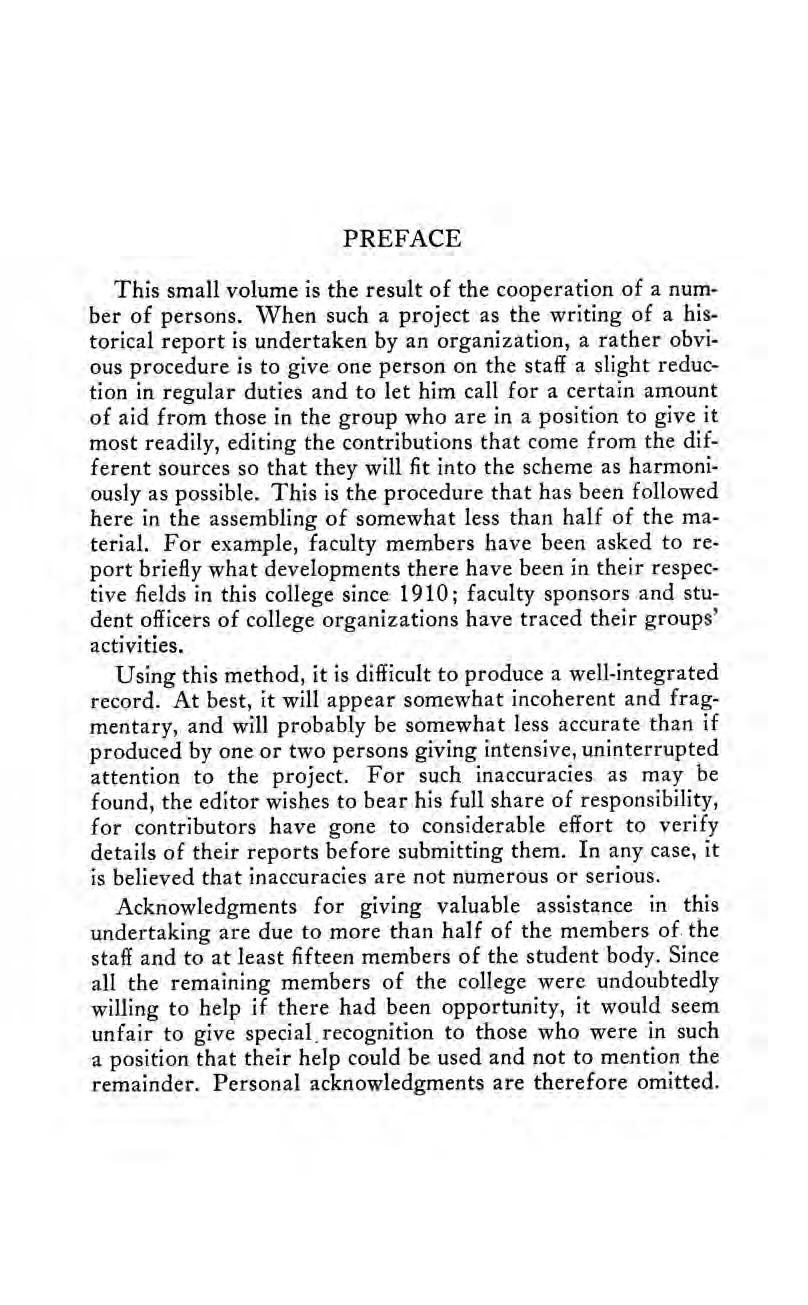
This small volume is the result of the cooperation of a number of persons. When such a project as the writing of a historical report is undertaken by an organization, a rather obvious procedureis to give one person on the staff a slight reduction in regular duties and to let him call for a certain amount of aid from those in the group who are in a position to give it most readily, editing the contributions that come from the different sources so that they will fit into the scheme as harmoniously as possible. This is the procedure that has been followed here in the assembling of somewhat less than half of the material. For example, faculty members have been asked to report briefly what developments there have been in their respective fields in this college since 1910; faculty sponsors and student officers of college organizations have traced their groups’ activities.
Using this method, it is difficult to produce a well-integrated record. At best, it will appear somewhat incoherent and fragmentary, and will probably be somewhat less accurate than if produced by one or two persons giving intensive, uninterrupted attention to the project. For such inaccuracies as may be found, the editor wishes to bear his full share of responsibility, for contributors have gone to considerable effort to verify details of their reports before submitting them. In any case, it is believed that inaccuracies are not numerous or serious.
Acknowledgments for giving valuable assistance in this undertaking are due to more than half of the members of. the staff and to at least fifteen members of the student body. Since all the remaining members of the college were undoubtedly willing to help if there had been opportunity, it would seem unfair to give special recognition to those who were in such a position that their help could be used and not to mention the remainder. Personal acknowledgments are therefore omitted.

It will be evident that this sketch concerns itself not only with the past and its interpretation for the present, but that it attempts to outline a cross-section of the current lifeof the school, its ‘contemporary history,” as a basis for comparison by later quarter-century investigators.
Winona, Minnesota, ERWIN S. SELLE, Editor. June, 1935.


Orchestra
Art Club
Wenonah Players.
Physical Education Club for Women .
Women’s Athletic Association
Athletic Teams Lo
“Ww” Club
Kappa Delta Pi
Intercollegiate Debate
International Relations Club
League of Women Voters
The Winonan
The Wenonah
The Die-No-Mo
Mu Epsilon Nu
Country Life Club
Arrowhead Range Club
Newman Club
Young Women’s Christian Association
CHAPTER VII Buildings and Grounds
CHAPTER VIII — Gifts to the College
Loan and Scholarship Funds
The Memorial Organ
The Watkins Art Collection
Garvin Heights Lo
A Play Field
An Addition to “Maxwell Field”
CHAPTER IX Periods of Stress
The World War
The Economic Depressions
The Fire
CHAPTER X— The Future
APPENDIX
The Seventy-Fifth Anniversary Celebration A Message from Governor Floyd B. Olson. An Editorialin The Winona Republican-Herald. A Partial Chronology of Important Events, 1910-1935.
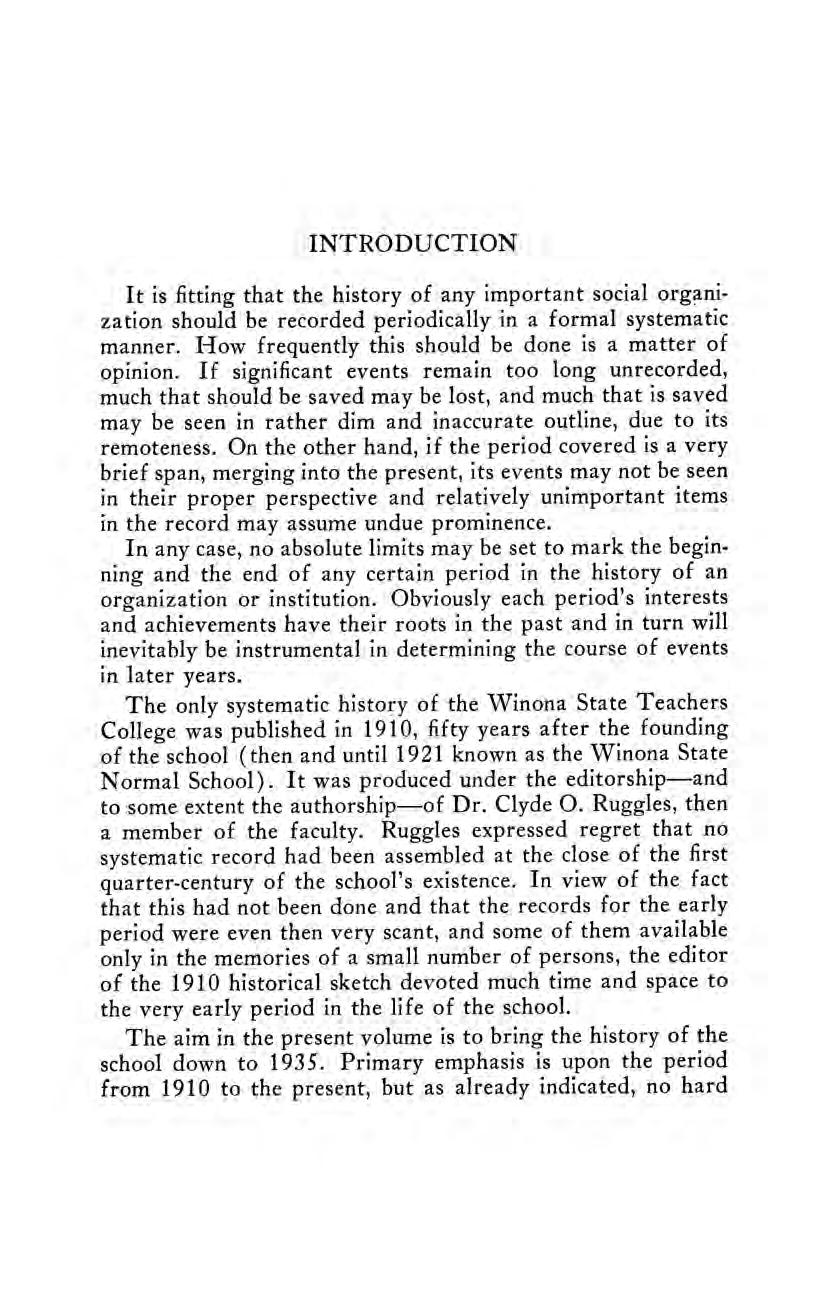
It is fitting that the history of any important social organization should be recorded periodically.in a formal systematic manner. How frequently this should be done is a matter of opinion. If significant events remain too long unrecorded, much that should be saved may be lost, and much that is saved may be seen in rather dim and inaccurate outline, due to its remoteness. Onthe other hand, if the period covered is a very brief span, merging into the present, its events may not be seen in their proper perspective and relatively unimportant items in the record may assume undue prominence.
In any case, no absolute limits may be set to mark the beginning and the end of any certain period in the history of an organization or institution. Obviously each period’s interests and achievements have their roots inthe past and in turn will inevitably be instrumental in determining the course of events in later years.
The only systematic history of the Winona State Teachers College was published in 1910, fifty years after the founding of the school (then and until 1921 known as the Winona State Normal School). It was produced under the editorship—and to some extent the authorship—of Dr. Clyde O. Ruggles, then a member of the faculty. Ruggles expressed regret that no systematic record had been assembled at the close of the first quarter-century of the school’s existence. In view of the fact that this had not been done and that the records for the early period were even then very scant, and some of them available only in the memories of a small number of persons, the editor of the 1910 historical sketch devoted much time and space to the very early period in the life of the school.
The aim in the present volume is to bring the history of the school down to 1935. Primary emphasis is upon the period from 1910 to the present, but as already indicated, no hard
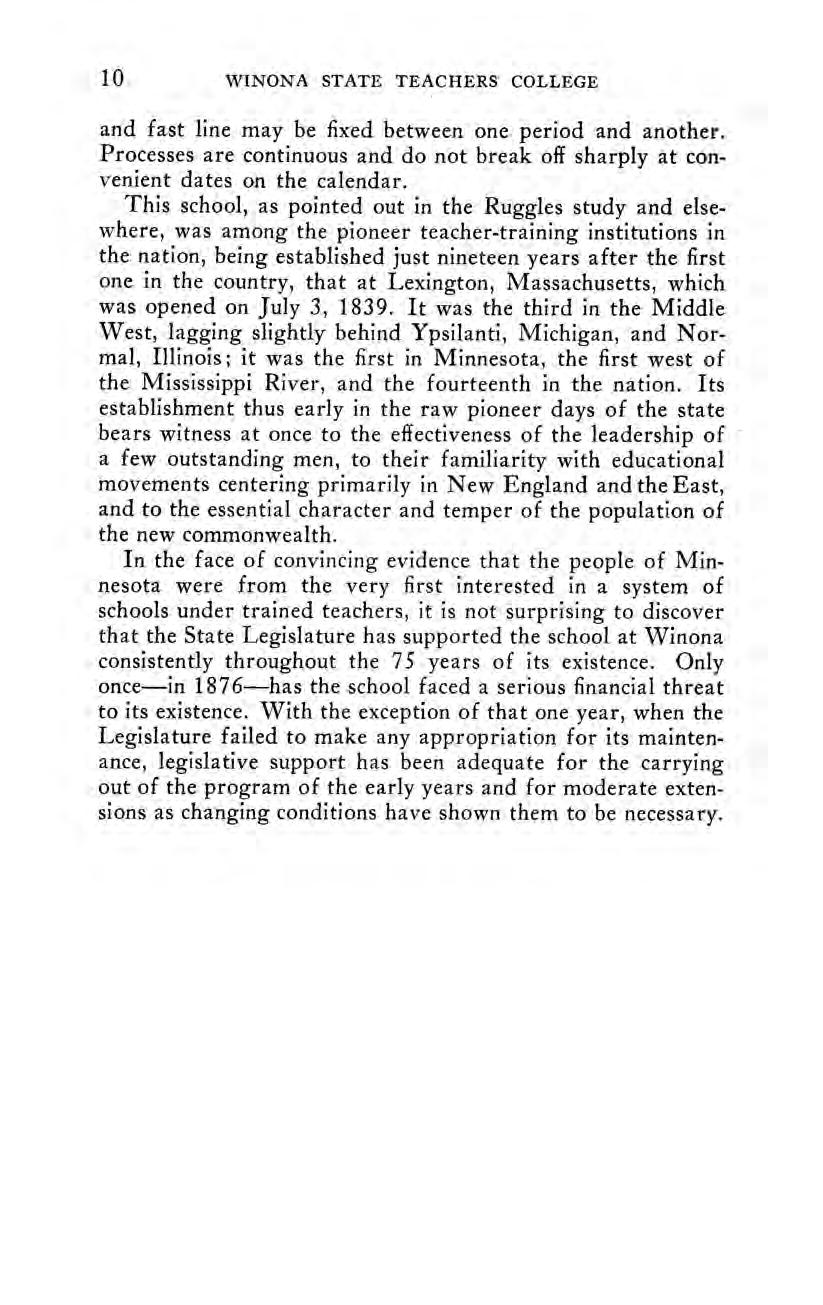
and fast line may be fixed between one period and another. Processes are continuous and do not break off sharply at convenient dates on the calendar.
This school, as pointed out in the Ruggles study and elsewhere, was among the pioneer teacher-training institutions in the nation, being established just nineteen years after the first one in the country, that at Lexington, Massachusetts, which was opened on July 3, 1839. It was the third in the Middle West, lagging slightly behind Ypsilanti, Michigan, and Normal, Illinois; it was the first in Minnesota, the first west of the Mississippi River, and the fourteenth in the nation. Its establishment thus early in the raw pioneer days of the state bears witness at once to the effectiveness of the leadership of a few outstanding men, to their familiarity with educational movements centering primarily in New England and the East, and to the essential character and temper of the population of the new commonwealth.
In the face of convincing evidence that the people ofMinnesota were from the very first interested in a system of schools under trained teachers, it is not surprising to discover that the State Legislature has supported the school at Winona consistently throughout the 75 years of its existence. Only once—in 1876—has the school faced a serious financial threat to its existence. With the exception of that one year, when the Legislature failed to make any appropriation for its maintenance, legislative support has been adequate for the carrying out of the program of the early years and for moderate extensions as changing conditions have shown them to be necessary.

In the Historical Sketch and Notes of the Winona State Normal School, published in 1910, at the close of the first fifty years of the school’s existence, the record of changes in the curriculum was introduced with this general statement: ‘The purpose of this sketch is to record the facts connected with the changes in the curriculum of the Winona State Normal School during the first fifty years of its history, without attempting to discuss, except incidentally, the causes, the importance, or the influences of these changes.
‘The development of the curriculum during this time (1860 to 1910) naturally divides into three periods of approximately seventeen years each:the first period extends from 1860 to 1877, when there was one course of two years for all students; the second period, from 1877 to 1895, when the former course was increased to three years and known as the elementary course, and an advanced course of four years was added, together with an advanced professional course of one year for high school graduates; the third period, from 1895 to 1908, when there were six courses, an additional year having been added to the advanced courses, making them two years for high school graduates and five years for others.”’*
“With the close of the period (1895-1910),” said the writer, “‘we see signs of the early introduction of courses designed to prepare teachers who desire to specialize more fully than has been heretofore or is now possible. Moreover, the Minnesota normal schools seem about to give serious and sympathetic consideration to plans for enlarging the scope of their professional training for teachers so that these schools shall become normal colleges or preferably teachers colleges, a
* For the details of these changes and for certain minor changes within each period, the reader is referred to the Ruggles volume, pages 121-137.
movement which seems now to be the clearest prophecy of what the curriculum shall become during the next fifty years.”’*
The course of study which was being followed at the beginning of the period covered by the present sketch as found in the catalog for 1908-9, was officially adopted on September 18, 1908. The complete list of offerings was as follows:
CoursE oF Stupy FoR Minnesota Norma ScHOOLS”
Algebra I, II, III
Arithmetic ..........0.. I, I, Ill
Botany I, Il
Chemistry I, Il
CIVICS I, II, HI
Drawing 1, I, I
Education
History of ..........0 I, Il
Theory of.............0 J, Il
Practice of........0 I, II, Il
School Manage’mt u%
Elementary Science .. I
English Composition I, Il
Geography I, II, III, IV
Geometry I, II, III
Grammar ....cccesseseeee I, IJ, IJ, 1V
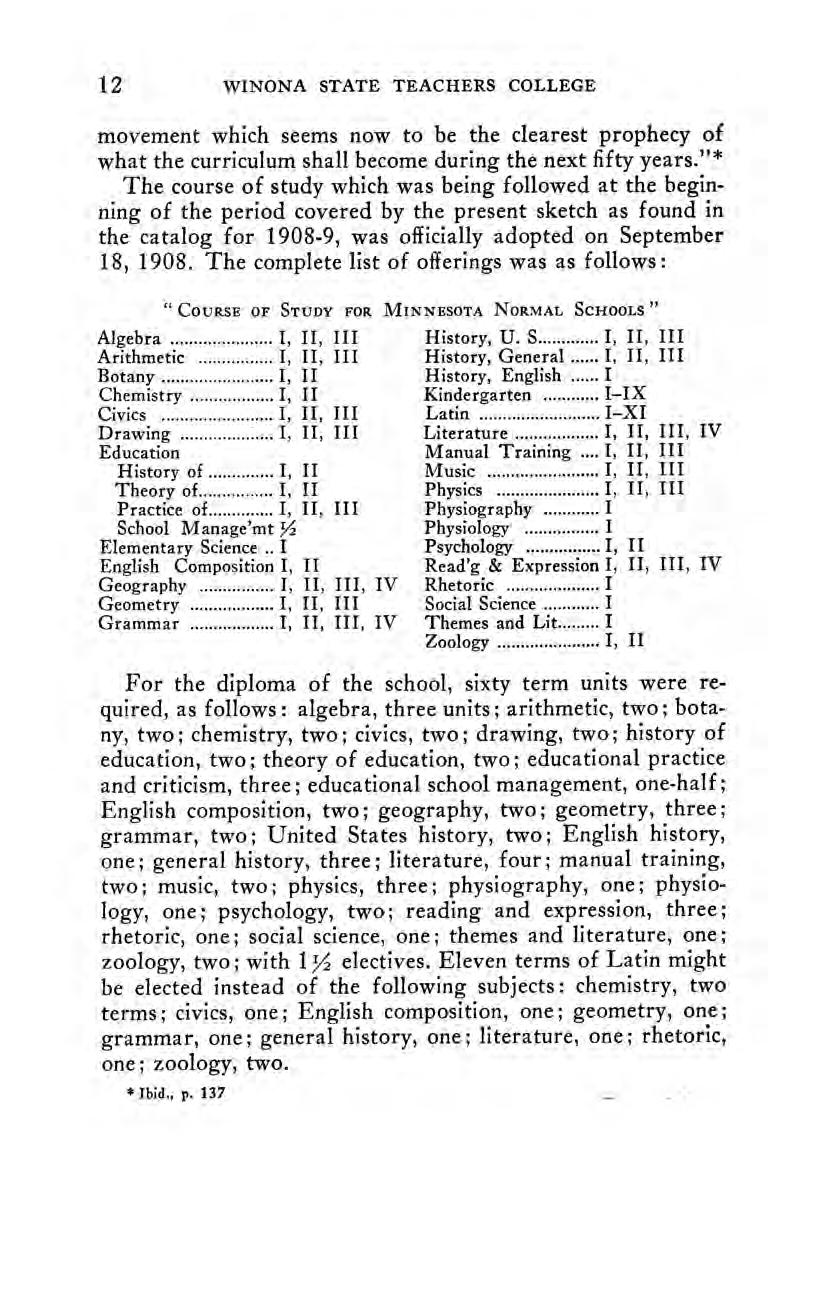
History, U. S.........0 I, II, Ill
History, General I, II, Ill
History, English I
Kindergarten I-IX
Latin vicccccsccsseseesseeees I-XI
Literature I, II, III, IV
Manual Training ....1, IH, HI
MUSIC .oeeeccsesscccesseeees I, II, Ill
Physics .csccccscccssceseeees I, II, Ill
Physiography I
Physiology ......ssceeeee I
Psychology I, Il
Read’g & ExpressionI, II, III, IV
Rhetoric I
Social Science I
Themes and Lit......... I
ZOOLOGY ..ssssesseeseeeseseeee I, Il
For the diploma of the school, sixty term units were required, as follows: algebra, three units; arithmetic, two; botany, two; chemistry, two; civics, two; drawing, two; history of education, two; theory of education, two; educational practice and criticism, three; educational school management, one-half; English composition, two; geography, two; geometry, three; grammar, two; United States history, two; English history, one; general history, three; literature, four; manual training, two; music, two; physics, three; physiography, one; physiology, one; psychology, two; reading and expression, three; rhetoric, one; social science, one; themes and literature, one; zoology, two; with 114 electives. Eleven terms of Latin might be elected instead of the following subjects: chemistry, two terms; civics, one; English composition, one; geometry, one; grammar, one; general history, one; literature, one; rhetoric, one; zoology, two.
* Ibid., p. 137

High school graduates received credit for 36 term units (three years) and might receive the diploma of the school for two years’ successful pursuit of certain prescribed subjects. The requirements in the two year kindergarten course were somewhat different from those in the regular two year elementary course.
Broader opportunities for study were provided by a rather liberal offering of electives. “As the facilities of the school permit,” runs the catalog announcement, ‘‘one or more of the following electives will be offered and may be chosen by the student, after consultation with the president, in lieu of certain subjects in the course of study: agriculture, two terms; advanced physics, one term; astronomy, one; children’s literature, one; drawing supervision, two; economics, one; English, two; home economics, three; Latin, two; library science, one; manual training, two; modern European history, two; music supervision, two; physical culture, one; primary methods, one; public speaking, one; special methods, one; writing and spelling, one-half.”
As early as May, 1911, in the catalog announcements for 1911-12, we find that the forecast as to specialization in the curriculum was in the process of realization. In addition to the special kindergarten course which had been established as early as 1880, special courses in household arts, manual training and drawing, and elementary supervision, were announced. “Anew course will be offered beginning in September,”’ reads the catalog statement concerning household arts, “‘for the preparation of special teachers and supervisors of cooking and sewing in the grades and high school. The work will prove especially attractive to graduates of the regular course who have taught temporarily as regular grade teachersand who seek the opportunity to prepare for more responsible positions in the schools... The course will require three years of work beyond the high school or one year of work beyond the advanced diploma course... .’’*
A similar statement as to length of course and its relation to high school graduation and the advanced diploma, as well *1910-11 catalog, p. 26-27

as to opportunity for entrance into more responsible positions, was made regarding a course in manual training and drawing.
The special course for elementary supervision was announced tentatively, although it had not yet been formally approved by the Normal School Board. The demand for such a course, requiring a third year of preparation, was pointed out. The need was for “special preparation for the more important positions in elementary education, such as general. supervision, departmental work in the grades and teacherships in the normal training departments ofhigh schools.”’ The need for well-trained teachers in the last-named field, high school normal training, was emphasized.
In the catalog for the following year, it was reported that the course in elementary supervision had been offered in 191112 and would be offered in 1912-13. But, ‘There is no desire on the part of the school to encourage large attendance upon. this course until facilities for instruction in this field of advanced work shall be increased through added funds.”
In this catalog, too, announcement was tentatively made, in advance of formal approval by the Board, of a proposed course for supervisors of music, to be offered in 1912-13. It was not actually offered, however, until the next year. In 191213, in addition to the special course in manual training and drawing, another special course in drawing, designed to prepare students to fill positions as art supervisors in the elementary schools of the state, was established. A year later, the “manual training and drawing” course was re-named the “‘special course for teachers of industrial arts.”
Another interesting policy was adopted in 1912-13. Until that year, the general description of the school had listed two “departments,” the “normal department proper’ and the “training department” or elementary school. The normal department, it was pointed out, “offers a course of study which by means of electives and by adjustment to credits previously earned in other schools adequately meets the needs of persons of varying preparation, experience and aims, from the beginning high school student or holder of the second grade state teachers certificate to the college graduate, and prepares teach-

ers for both graded and ungraded school work ranging from the kindergarten through the eighth grade, and under special conditions, even for high school work.” In this year, 1912-13, however, a high school department was added, the “plan of the school” including “the normal department proper, the high school and the elementary school.” Instead of the “general course of study for Minnesota Normal Schools,” which was a composite of high school subjects and education subjects to be adjusted to the needs and the training of all classes of students, a clear differentiation was made between the general course for high school graduates and the general course for high school pupils. The latter course comprised three years ‘of work such as was being carried on in the standard high schools, including, for example, eleven quarters of Latin, three quarters each of algebra and geometry, three quarters of physics, and so forth. In the high school department that year, there were 32 students in the third-year class, 49 in the secondyear, 86 in the first-year, and four classified as special students, a total of 171. Graduates of this high school department, by continuing in the normal department of the school for an additional two years, pursuing education subjects almost exclusively, were qualified for the advanced diploma. This separate provision for students on the high school level was continued on this basis until 1914-15 at which time two years of high school work were required for admission to the school, and consequently only two years of work were offered in the high school or ‘‘academic department,” as it now came to be called. Finally, in 1918-19, graduation from a high school; academy, college or school of equal rank was required for admission to any department of the normal school and there was no need to provide any courses on the high school level.
Our main interest here is in noting the great variety of courses offered at this period, a partial or a full program of high school subjects being provided as well as two years of professional training, and offerings in several special fields. Details as to eliminations and additions and substitutions of courses will be noted in some of the sections of the next chapter.
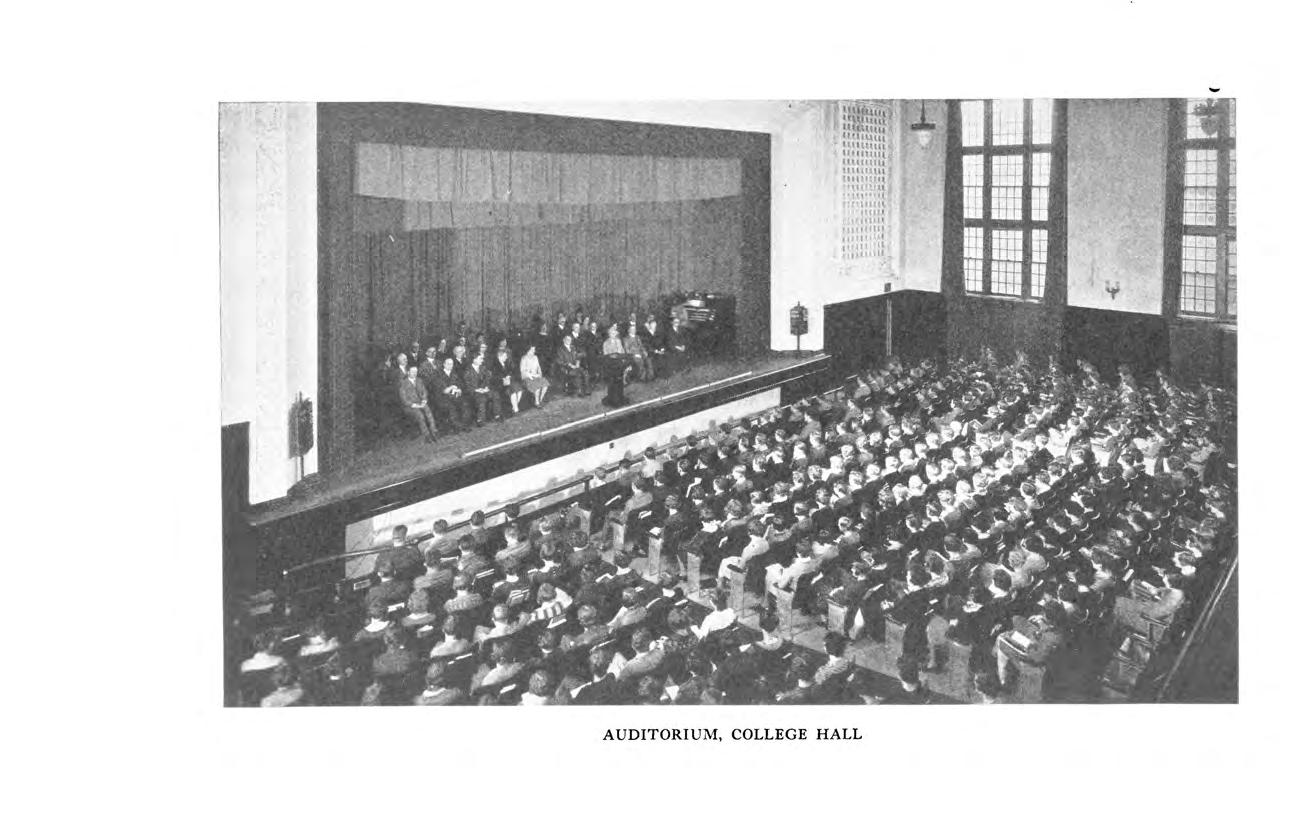

In the catalog for 1916-17, the college announced a twoyear “special curriculum in rural education.” It was designed to meet the needs of ‘‘rural school teachers, heads of training departments, and supervisors, admission to the work being based upon high school graduation.” At this time, too, the “special course for elementary supervision” became “‘the special curriculum in supervision and departmentalteaching.” It appears that the need of more than two years of training for the “regular’ teacher in the elementary grades was here officially recognized for the first time, for the third year of study was planned “‘to supplement the regular two years of work heretofore maintained.” It was pointed out that the third year graduates would be in demand for general supervisory positions, for work in high school training departments as well as in departmental work in the grades. In the next catalog and thereafter, reference was made to the “third year of the general curriculum.” Encouragement to take this three-year course was provided by offering a ‘“‘special diploma in elementary education.” "| PRP
In the announcements for 1919-20, special mention was made of ‘‘college subjects.” ‘While practically all normal school subjects are of college grade,” it was pointed out, “‘certain ones are more generally accepted for advanced credit in universities, including the subjects offered for departmental and junior high school teachers.” Then followed a list of subjects from which the student might elect, with the aim of later transferring his credits to a university or professional school.
In the catalog for 1920-21, the junior-college course was placed among the “special curriculums’’—manual training, rural education, and the rest. The subjects were the academic as distinct from the professional-education subjects. In the next year’s announcements, special mention was made of the advantages of engaging in junior-college study at such a school as Winona instead of going to a larger school: “Should one have in view other work requiring college study, he cannot do better than to enter the junior-college work also offered in the normal school. Indeed, the preliminary preparation for various lines of professional study is best secured in a school where

the work is available at forty per cent less cost than at universities, where the transition from high school to university is more safely and easily made on account of smaller classes, and where there is the most personal contact with instructors. The records show that normal-school graduates after transfer to the university average higher in their studies than do other’ groups of students.”
‘In the catalog for 1919-20, a two-year course in physical education was added to the list of special curriculums making a total of eight of these special fields.
In the announcements for 1922-23, no mention was made of the possibility of taking a third year in any special curriculum. All were referred to as two-year curriculums. In this publication home economics and drawing were dropped from the list of special curriculums, but subjects continued to be offered in both fields as part of the “regular” curriculums. ‘The threeyear general curriculum was still listed.
Perhaps the most significant development in the past twentyfive years has been the setting-up of a four-year curriculum leading to the bachelor’s degree. This was authorized by the State Legislature in 1921, and the name of the school was changed to The Winona State Teachers College. The catalog for 1922-23 stated that “the four-year curriculum, leading to the degree, Bachelor of Arts in Education,* will be offered in full as soon as it is justified by the demand therefor and the resources of the college. Approximately one-half the work will be offered in 1922-23.” Elsewhere in the same publication it was stated that the full course could not be provided at once because of lack of facilities, but that “the necessary courses will be steadily added.”
In that same year, 1922-23, announcement was made that the college would provide a limited amount of correspondence study for teachers in service who had shown themselves to be capable students while in residence. The aim evidently was to encourage these graduates to proceed with the degree program. This work was withdrawn three years later, however, with the simple announcement that “This college does not at
* Later changed to Bachelor of Education.

thistime maintain a plan for correspondence study.” A year after this announcement, the college entered the extension study field. ‘The college maintains campus courses,” according to the catalog statement, “‘either in the evening or on Saturdays, whereby teachers with at least a year of credit in college work may improve their teaching and add credits needed for the diploma or the degree.”
From 1925 to 1928, courses and field work preparatory to visiting-teacher service were offered. These courses, under the general designation, ‘‘social guidance of the child,” were given by a specially trained teacher and social worker under a grant from the Commonwealth Fund as part of a nation-wide experiment in visiting-teacher work.
The college graduated its first degree class—a class of four —in June 1926. Since that time, the three-year general curriculum has not been offered. The curriculums listed in the announcements for 1926-27 were the general two-year curriculum, the general four-year curriculum, and the following twoyear special curriculums: kindergarten-primary, manual training, music, physical education, rural education, and junior college. This is the last mention of a special junior-college course. Since 1919 it had been recognized as offering a special opportunity to students not wishing to become teachers, and it had been listed among the “‘special curriculums” since 1920. Graduates from this course had received the title ‘“‘Associate in Arts” and had been accepted as juniors in the College of Science, Literature, and the Arts at the University of Minnesota. But the plan eventually was opposed by certain members of the Teachers College Board and by at least one teachers college president in Minnesota and the academic junior-college course was discontinued.*
For the eight years during which junior-college courses were specifically offered and students taking this work were designated in the enrollment figures, the number enrolled ranged from thirteen to thirty-three, the average being twenty-one.
In addition to the regular two-year and four-year curriculums and the two-year special curriculums in industrial educa-
For President Maxwell’s defense of the Junior-College course in a teachers college see Koos, L. V., The Junior College, Vol. II, p. 558-9.
tion, public school music, kindergarten-primary, physical education, and rural education listed for 1929-30, the college cited the increasing demand for teachers of broader preparation andannounced advanced work, requiring four years of preparation, in the special fields of industrial arts, music and physical education. A year later fine arts was added to this
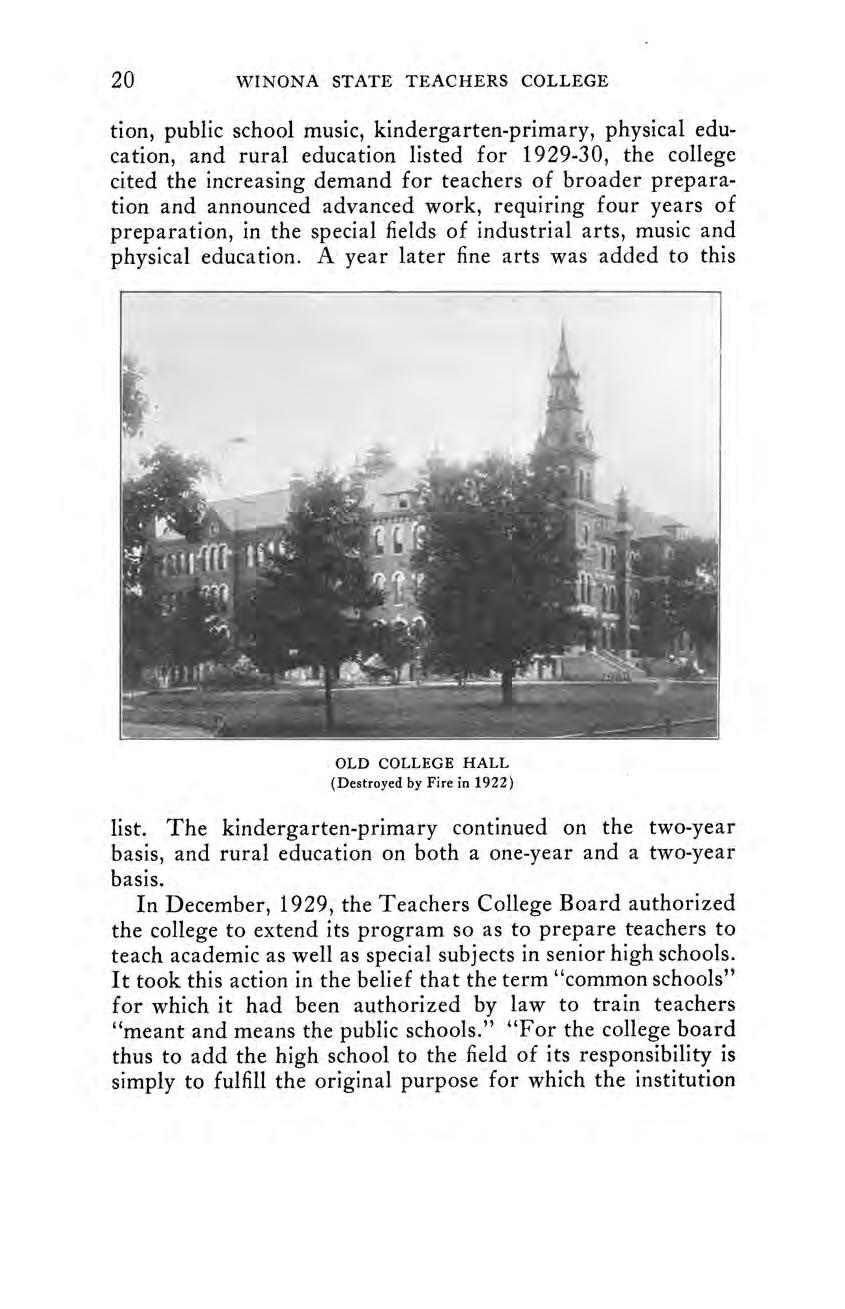
(Destroyed by Fire in 1922)
list. The kindergarten-primary continued on the two-year basis, and rural education on both a one-year and a two-year basis.
In December, 1929, the Teachers College Board authorized the college to extend its program so as to prepare teachers to teach academic as well as special subjects in senior high schools. It took this action in the belief that the term ‘common schools” for which it had been authorized by law to train teachers ‘meant and means the public schools.”’ ‘For the college board thus to add the high school to the field of its responsibility is simply to fulfill the original purpose for which the institution
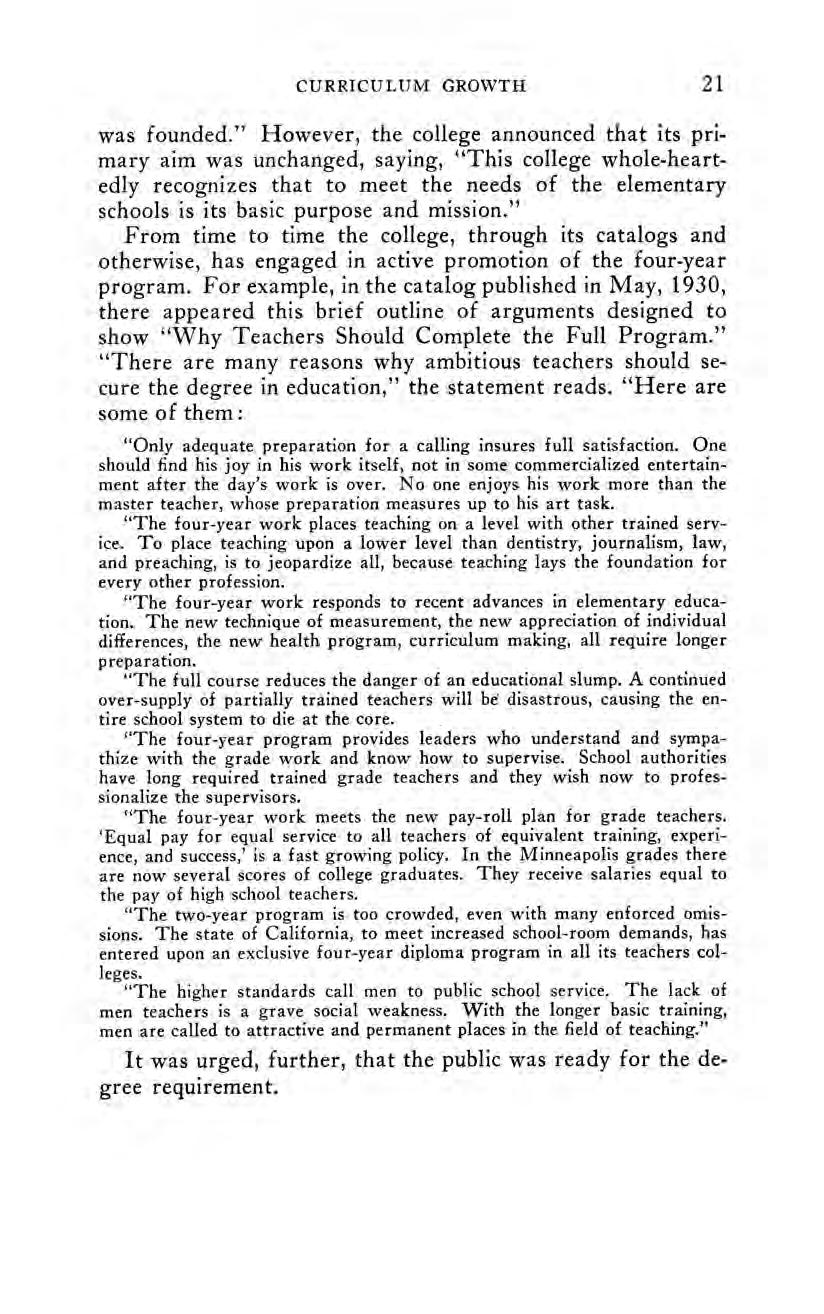
was founded.” However, the college announced that its primary aim was unchanged, saying, ““This college whole-heartedly recognizes that to meet the needs of the elementary schools is its basic purpose and mission.”
From time to time the college, through its catalogs and otherwise, has engaged in active promotion of the four-year program. For example, in the catalog published in May, 1930, there appeared this brief outline of arguments designed to show ‘‘Why Teachers Should Complete the Full Program.” “There are many reasons why ambitious teachers should secure the degree in education,” the statement reads. ‘Here are some of them:
“Only adequate preparation for a calling insures full satisfaction. One should find his joy in his work itself, not in some commercialized entertainment after the day’s work is over. No one enjoys his work more than the master teacher, whose preparation measures up to his art task.
“The four-year work places teaching on a level with other trained service. To place teaching upon a lower level than dentistry, journalism, law, and preaching, is to jeopardize all, because teaching lays the foundation for every other profession.
“The four-year work responds to recent advances in elementary education. The new technique of measurement, the new appreciation of individual differences, the new health program, curriculum making, all require longer preparation.
“The full course reduces the danger of an educational slump. A continued over-supply of partially trained teachers will be disastrous, causing the entire school system to die at the core.
“The four-year program provides leaders who understand and sympathize with the grade work and know how to supervise. School authorities have long required trained grade teachers and they wish now to professionalize the supervisors.
“The four-year work meets the new pay-roll plan for grade teachers. ‘Equal pay for equal service to all teachers of equivalent training, experience, and success,’ is a fast growing policy. In the Minneapolis grades there are now several scores of college graduates. They receive salaries equal to the pay of high school teachers.
“The two-year program is too crowded, even with many enforced omissions. The state of California, to meet increased school-room demands, has entered upon an exclusive four-year diploma program in all its teachers colleges.
“The higher standards call men to public school service. The lack of men teachers is a grave social weakness. With the longer basic training, men are called to attractive and permanent places in the field of teaching.”
It was urged, further, that the public was ready for the degree requirement.
“That the four-year program meets a felt need is shown by the increasing numbers of four-year graduates at Winona. Beginning four years ago, the numbers are 4, 7, 12, and 22. These increases were responses to the needs primarily of the elementary schools, for the College Board had not yet accorded the privilege of teaching in high schools, as it has now done.”
The period from 1926, when the first degree class was graduated, to 1929-30, is quite obviously one of transition and of vaguely defined standards. The degree classes found a few new courses added for their benefit, but to a considerable extent they met the ‘‘tentative’ requirements for graduation by taking additional courses from among those already offered as electives. In May, 1929, the four-year curriculum was officially revised by the Teachers College Board. Since that time it has assumed a somewhat definite form.
For the purpose of comparison with the 1910 curriculum, reported earlier in this chapter, as well as with the curriculum now in use (1934-35), the program announced in the catalog for one recent typical year, 1927-28, is here recorded.
In that year the curriculums announced included only one requiring four years of training, this being listed as ‘‘supervision, administration, etc.” The traditional primary, intermediate, and junior-high school curriculums continued to require only two years, as did the five special fields, industrial arts, kindergarten-primary, music, physical education, and rural education. Eighteen ‘constants’ were listed—courses required of all except those in the special fields of industrial arts, music, and physical education, students specializing in these fields being permitted to substitute certain of their special courses for one or two of these “regular” courses. ‘The list of constants was as follows:

refer to number
In addition to these eighteen subjects, each student pursued six others more or less closely related to his own special in-
terest. For example, those preparing for primary teaching took:
Children’s Literature 4-1. Twoelectives, with Nature Study Drawing or Music * 4-2 and Primary Handwork adLower Grade Methods............... 4-1 VISE ...escssscssscsssetceeressesseesseaceues 8-2 Physical Education 4-1 and 2
(* Choose the one omitted from the group of constants.)
Special lists of requirements were set up in similar fashion for intermediate-grade teaching, junior-high school teaching, and kindergarten-primary teaching, as well as for teaching in the so-called special fields of industrial education, music, physical education, and rural education.
Those wishing to get the degree were required to ‘add to the twenty-four subjects included in any two-year diploma program a total of twenty-four subjects or units, half of which are prescribed. The remaining twelve subjects are chosen from the elective group under certain conditions.”
Subjects required for the third and fourth years were as follows:

In addition to meeting the requirements as noted, the catalog statement explained, “‘it is also required that the candidate for the degree shall cover the work of two majors, one of which must be in education, and two minors, one of which must be in a field other than each of the majors... .”
It was indicated that a major consisted of 24 quarter-hours from the third and fourth years’ work in a given group and from electives of the second year’s work, and a minor consisted of twelve quarter-hours of college work in a given subject or group.
Electives for two-year and four-year students were chosen from the special curriculums and from the following list of subjects:
American History 2 4-1
Debate 4-2
(Geography 8)........ 4-3.
and Tennyson............ 4-3.
4-4
and Art 2-5 wn. 16-2:

2-3 ..cccccsscseceeees 8-2
(Geography 6-7) 8-4
4-3
Century Novel 4-4
In the catalog for 1934-35, some interesting changes are to be noted. For the first time in its history, the college offers no one-year course. Rural education, formerly listed among the special curriculums and offering a one-year and a two-year course, is now included among the general curriculums for elementary schools and is on the two-year basis exclusively. The kindergarten-primary course also is listed among the general curriculums instead of being among those designated as ‘‘special.”’
Another striking change is the requirement of four years in all of the special fields, fine arts, industrial arts, music, physical education, and a fifth one labeled “supervision, high school, etc.”
Another change is in the number of constants, there now being thirteen subjects required of all two-year students instead of eighteen as formerly. The difference is not so great as it might seem, however, for “teaching” courses (314 units) are now included among the variables—‘‘primary teaching,” “intermediate teaching,” for example—instead of with the constants.
‘Wariables” are provided for all two-year fields, substantially the same as in 1927-28.
The sixteen hours of electives available to each two-year student are chosen from the following list:
Another notable change is that the four-year program is set up as a complete unit rather than as an addition to the twoyear curriculums. The work is “‘half prescribed, half elective.”’ The 96 hours of constants are distributed by years and quarterhours as follows:
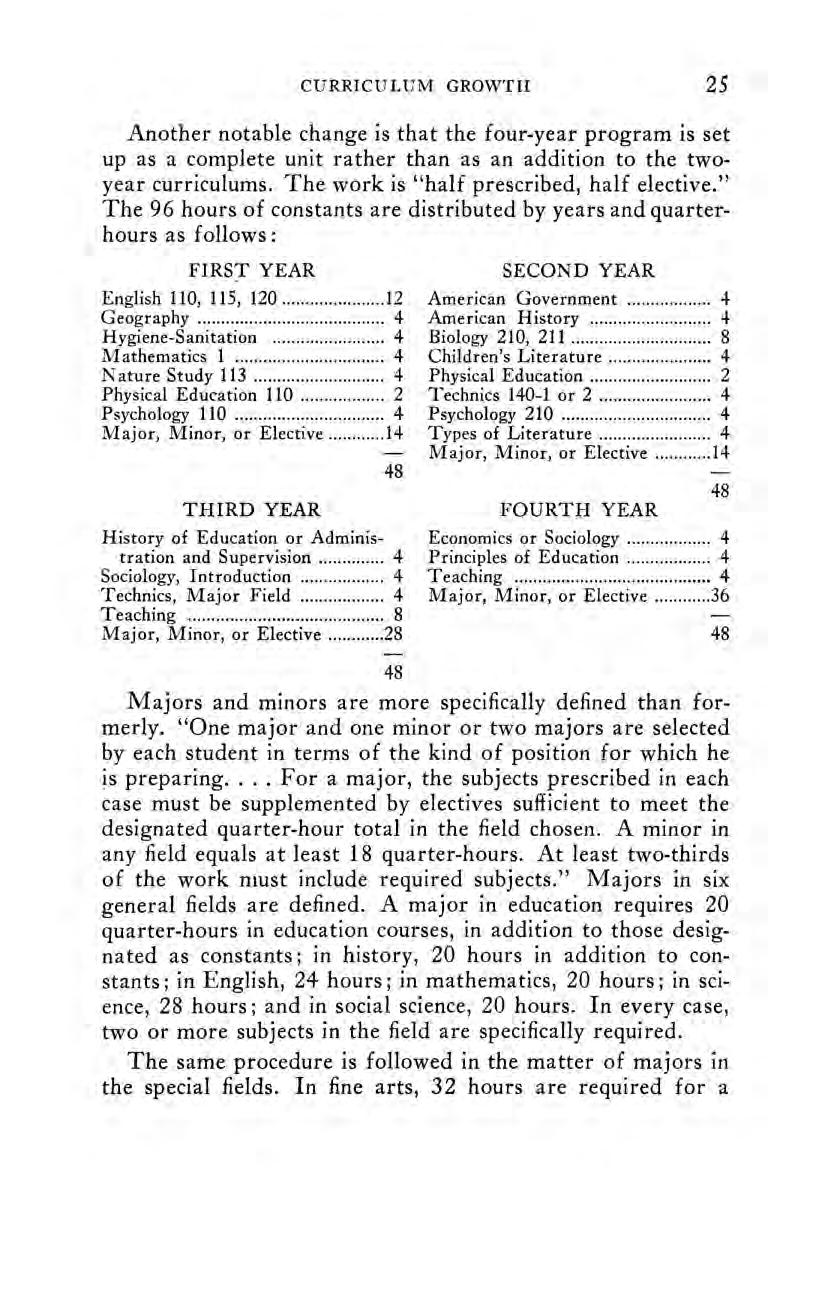
Majors and minors are more specifically defined than formerly. “One major and one minor or two majors are selected by each student in terms of the kind of position for which he is preparing. For a major, the subjects prescribed in each case must be supplemented by electives sufficient to meet the. designated quarter-hour total in the field chosen. A minor in any field equals at least 18 quarter-hours. At least two-thirds of the work must include required subjects.”’ Majors in six general fields are defined. A major in education requires 20 quarter-hours in education courses, in addition to those designated as constants; in history, 20 hours in addition to constants; in English, 24 hours; in mathematics, 20 hours; in science, 28 hours; and in social science, 20 hours. In every case, two or more subjects in the field are specifically required. The same procedure is followed in the matter of majors in the special fields. In fine arts, 32 hours are required for a
major in the field, in addition to the constants; in industrial arts, 36 hours; in music, 44 hours; in physical education, 32 hours. In each of these fields, fromfour to twelve subjects are specifically named as requirements over and above the 96 hours of constants and in addition to eight hours of technics and teaching in the special field.
The following is the list of subjects available to four-year students as electives. In addition, electives may also be chosen from the special and general four-year fields and from the list of two-year electives.

Other changes will be noted in the catalog recently printed, containing announcements for 1935-36. Faculty committees in the six Minnesota teachers colleges, under general authorization of the six presidents, have during the past two years carried out somewhat comprehensive studies of curricular practice in the various states and of the specific curricular problems found in Minnesota. After several meetings of a “‘conference committee’ made up of representatives of the six local committees, various recommendations for change in the four-year curriculums were made to the presidents and transmitted by them, after amendment, to the Teachers College Board for approval. Four notable changes will be found. (1) The fouryear program will be definitely the regular program. Instead of having four-year students make their schedules by adjustment to a two-year program, those taking the two-year course will make adjustment to the regular four-year program. (2) Academic subjects will be provided almost exclusively in the first two years, and professional-education subjects will be car-
ried, almost without exception, in the last two years. (3) Majors and minors will have a new definition. (4) Subjectmatter will receive relatively more emphasis and professional courses somewhat less than heretofore.
(As

for 1935-36)
To prepare for the elementary field the student adds to the constants listed above the subjects which follow, and with the degree he receives the Elementary School Standard Certificate. [his qualifies him for teaching in any elementary school, or, when so designated, in any junior high school.
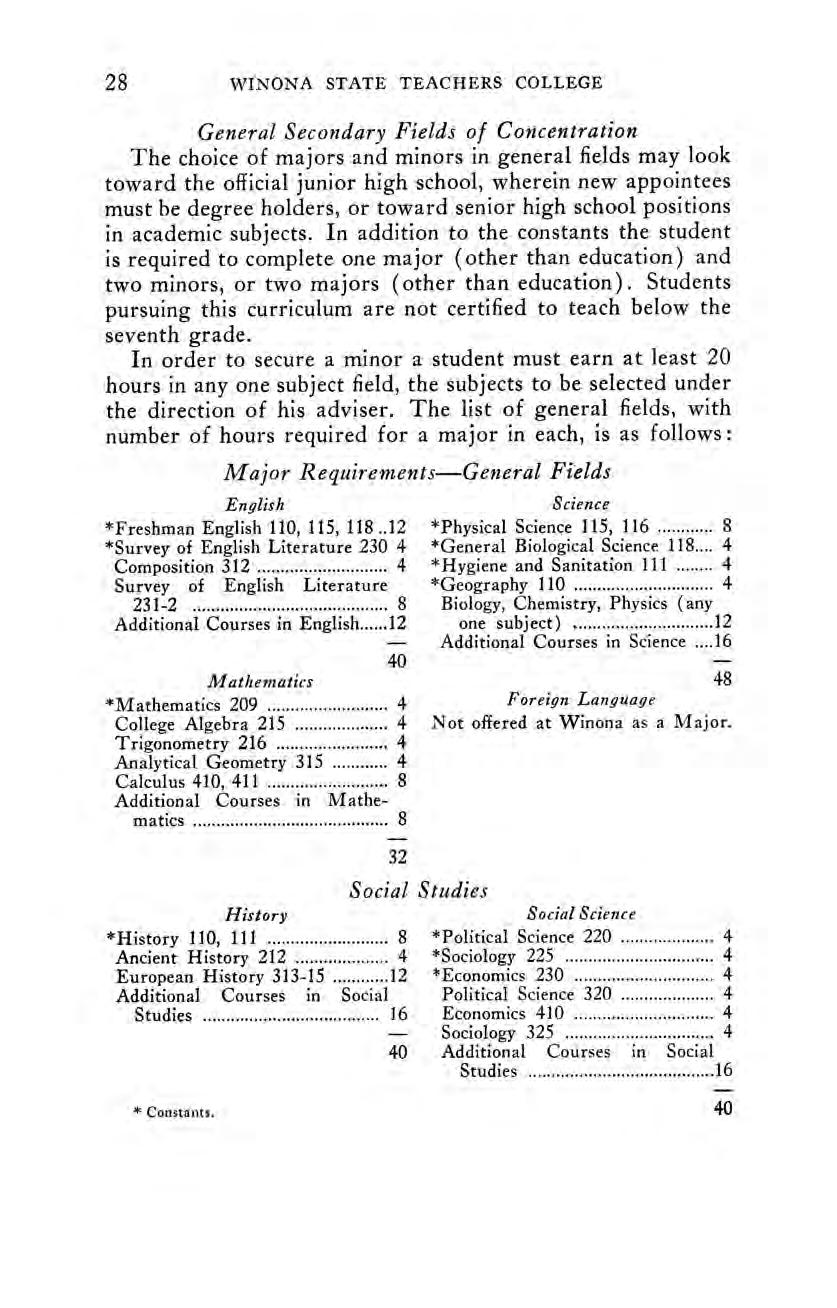
The choice of majors and minors in general fields may look toward the official junior high school, wherein new appointees must be degree holders, or toward senior high school positions in academic subjects. In addition to the constants the student is required to complete one major (other than education) and two minors, or two majors (other than education). Students pursuing this curriculum are not certified to teach below the seventh grade.
In order to secure a minor a student must earn at least 20 hours in any one subject field, the subjects to be selected under the direction of his adviser. The list of general fields, with number of hours required for a major in each, is as follows:

Today the student who completes the full program pursues four times as much work as did his fellow of sixty and seventy years ago. The steps in this forward movement have been steady and definite. ‘Avoiding alluring by-paths the authorities of the college have appreciated the enlarging conception of the place of the common schools in the life and progress of our state and have steadily set up higher standards of health, teaching technique, scholarship, and culture.”

In the preceding chapter, the general development of the curriculum of the college since 1910 was briefly sketched. It may be of interest to go beneath the surface, to present in more detail the content of some of the various courses and subjects, although space limitations will prevent anything like a complete record.
Attention has already been called to the expansion in the so-called “special” fields, beginning in 1911-12. The history of the developments in these and other fields is here reviewed, beginning with the oldest, the kindergarten-primary curriculum. *
With a greatly increased enrollment of kindergarten children as well as of students specializing in this field, the addition of a third person to the staff became necessary in 1911. Beautiful, spacious, well-equipped quarters were provided in the new library building. The rather prohibitive extra fee of thirty dollars a year formerly collected from kindergarten students was discontinued, and the work offered in this department was recognized as being of the same rank as the other work of the school.
A very significant change was made in 1916. Instead of one kindergarten, two well-equipped kindergartens were provided, one for four-year-olds and one for five-year-olds. In thus separating the children and providing special material and equipment for the younger children, we find the Winona Normal School breaking the ground for the earliest of the pre-kindergarten or nursery schools in Minnesota. A special curriculum for the four-year-old child was developed, with
* For the earlier record of the offerings in this field, the reader is referred to the Ruggles “Historical Sketch” published by the college in 1910.
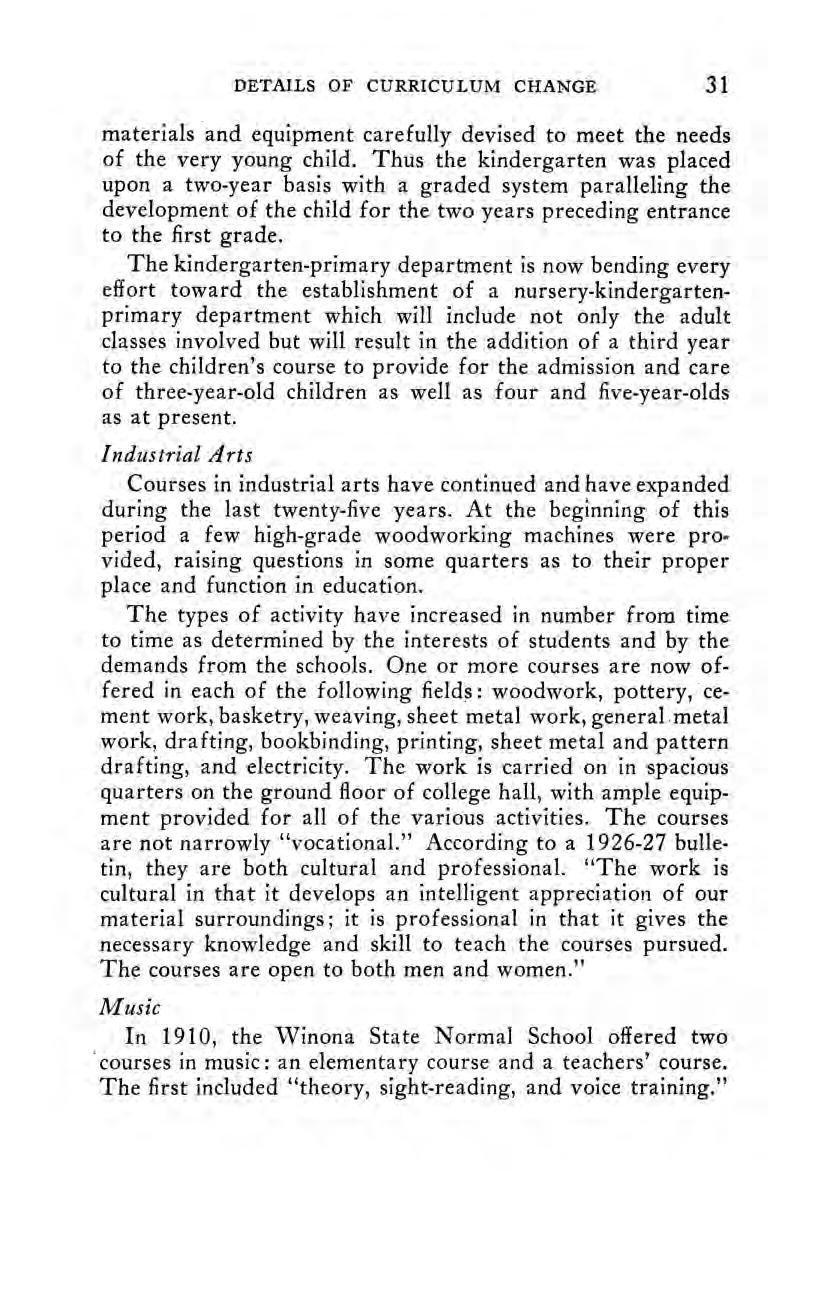
materials and equipment carefully devised to meet the needs of the very young child. Thus the kindergarten was placed upon a two-year basis with a graded system paralleling the development of the child for the two years preceding entrance to the first grade.
The kindergarten-primary department is now bending every effort toward the establishment of a nursery-kindergartenprimary department which will include not only the adult classes involved but will result in the addition of a third year to the children’s course to provide for the admission and care of three-year-old children as well as four and five-year-olds as at present.
Courses in industrial arts have continued and have expanded during the last twenty-five years. At the beginning of this period a few high-grade woodworking machines were provided, raising questions in some quarters as to their proper place and function in education.
The types of activity have increased in number from time to time as determined by the interests of students and by the demands from the schools. One or more courses are now offered in each of the following fields: woodwork, pottery, cement work, basketry, weaving, sheet metal work, general.metal work, drafting, bookbinding, printing, sheet metal and pattern drafting, and electricity. The work is carried on in spacious quarters on the ground floor of college hall, with ample equipment provided for all of the various activities. The courses are not narrowly ‘‘vocational.” According to a 1926-27 bulletin, they are both cultural and professional. ‘“The work is cultural in that it develops an intelligent appreciation of our material surroundings; it is professional in that it gives the necessary knowledge and skill to teach the courses pursued. The courses are open to both men and women.”
In 1910, the Winona State Normal School offered two ‘courses in music: an elementary course anda teachers’ course. The first included “theory, sight-reading, and voice training.”

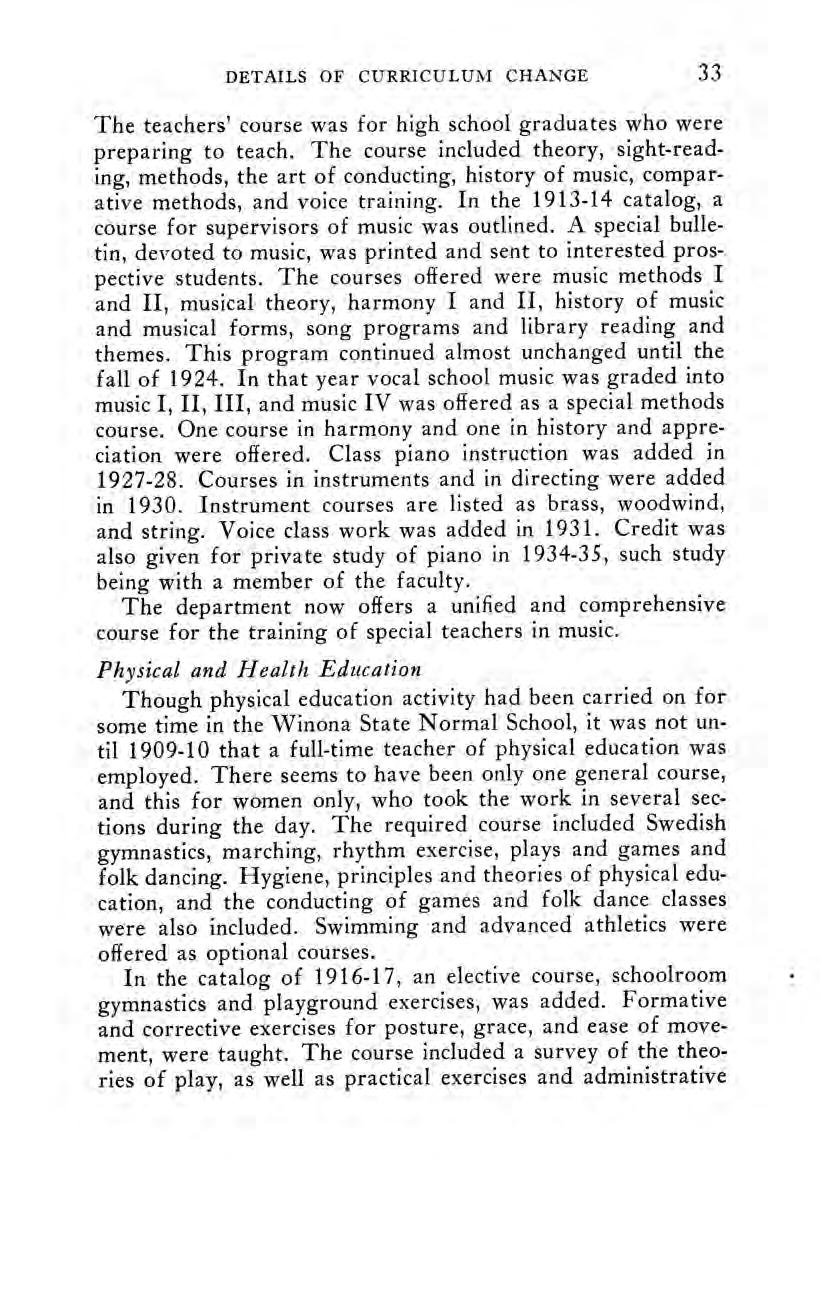
The teachers’ course was for high school graduates who were preparing to teach. The course included theory, sight-reading, methods, the art of conducting, history of music, comparative methods, and voice training. In the 1913-14 catalog, a course for supervisors of music was outlined. A special bulletin, devoted to music, was printed and sent to interested prospective students. The courses offered were music methods I and II, musical theory, harmony I and II, history of music and musical forms, song programs and library reading and themes. This program continued almost unchanged until the fall of 1924. In that year vocal school music was graded into music I, II, III, and music IV was offered as a special methods course. One course in harmony and one in history and appreciation were offered. Class piano instruction was added in 1927-28. Courses in instruments and in directing were added in 1930. Instrument courses are listed as brass, woodwind, and string. Voice class work was added in 1931. Credit was also given for private study of piano in 1934-35, such study being with a member of the faculty.
The department now offers a unified and comprehensive course for the training of special teachers in music.
Though physical education activity had been carried on for some time in the Winona State Normal School, it was not until 1909-10 that a full-time teacher of physical education was employed. There seems to have been only one general course, and this for women only, who took the work in several sections during the day. The required course included Swedish gymnastics, marching, rhythm exercise, plays and games and folk dancing. Hygiene, principles and theories of physical education, and the conducting of games and folk dance classes were also included. Swimming and advanced athletics were offered as optional courses.
In the catalog of 1916-17, an elective course, schoolroom gymnastics and playground exercises, was added. Formative and corrective exercises for posture, grace, and ease of movement, were taught. The course included a survey of the theories of play, as well as practical exercises and administrative

organization. The physical education work for men seems to have been entirely in athletics.
In 1918-19, a special two-year curriculum in physical education was provided. This was ‘designed to prepare students not only to teach the regular school subjects but in addition to meet the demand for teachers who are capable of conducting schoolroom gymnastics, playground activities, and athletics.”’ The special subjects were: bacteriology; child feeding and emergencies; physical education methods and coaching; physical education theory and organization; physiology; play and gymnastics; and practice teaching and coaching.
In 1919-20, the work was organized under the name of the department of hygiene at the invitation of the United States
Interdepartmental Social Hygiene Board which gave some financial aid and set up certain requirements. A resident physiclan was employed and the course in sanitation and hygiene, formerly included under the general heading of science, was changed to a course in general hygiene and was added to the courses previously included in the department of physical education. Later the work of the department was reorganized under the name hygiene and physical education.
The state law requiring physical and health education in all public schools produced interest in the special two-year curriculum. The essential content of courses previously given was continued and expanded under slightly different names. Coaching methods for men was listed as a separate course, including the study of theory and practice in the major sports, football, basketball, and track. A new course growing out of the one previously called teachers physiology, under the name growth and development, was added. A course in home nursing, covering bedside and sick-room care, hygiene of maternity and infancy, contagious and infectious disease, and emergencies and bandaging, was offered for the first time. In 1926-27, another addition to the courses previously offered was made. The old course in descriptive and applied anatomy was expanded into two courses, one in elementary anatomy and the other in elementary physiology.

New courses in 1927-28 included the following: technique of sports for women—dealing with the organization and the methods of coaching hockey, soccer, basketball, and baseball; individual gymnastics—dealing with common faults of posture, their causes and symptoms, and exercises and methods for their correction or improvement; school health supervision —dealing with common defects of school children, classification of pupils according to endurance and coordination, and methods of treating health; personal hygiene—a course emphasizing personal attitudes and habits in relation to health.
The physical education practice required of all men and women was entirely reorganized at this time on a sport and seasonal basis and emphasized progressive games and skill tests leading to the major seasonal sports. This form of organization has continued without change for the later years.
In 1932-33, the catalog carried a specific statement of the two objectives of the program of activities as follows :— “First, to prepare students for teaching physical education in the public schools; second, to meet the health and recreational needs of college students.” The program of all students was made to include two required activity courses, two elective activity courses, each of one quarter-hour credit, and a teachers course of two quarter-hour credits to be taken during five quarters of residence. This plan of organization with only minor changes remains in effect to date.
At the beginning of this twenty-five-year period, three art courses were required, two in drawing and form study, the other a course “relating to methods of teaching the subject in the common schools.’ In the field of household arts there was one course in design.
With the setting up of a special three-year course in drawing in 1912-13, a course designed to prepare teachers and supervisors ,of art in the public schools, the offerings were greatly expanded, including perspective drawing, color, mechanical drawing, design and composition, history of art, outdoor sketching, pictorial illustration and life drawing, and organization of the course of study. Within a year or two, the

courses were further expanded, both in the number of subjects offered and in the amount of time devoted to some of them. For example, there were two courses in history of art, two in design and composition, and a new course in applied design. In 1915-16, ten courses in ‘drawing’ were required for the special diploma in drawing. The name ‘‘drawing”’ was changed to “art” the following year. In 1919-20, the number of courses for the special diploma was reduced to six, and two years later the special art curriculum was discontinued, although certain courses of value to regular grade teachers were still offered. In 1923, for the first time drawing was not required in the general two-year curriculum, students being permitted to choose between drawing and music.
In 1930-31, fine art was made one of the four-year special fields, three of which had been established by the Teachers College Board the preceding year. At that time, the following courses were offered: the teaching of drawing, primary handwork, design, history of art (two courses), representation, and rural drawing. Later, courses in applied design and advanced representation were added, and two courses called respectively survey of art and art appreciation were substituted for history of art. A course in interior decoration has been added very recently.
Special training for teaching in rural schools had its beginning in the summer session of 1912, when a successful rural teacher gave a course in rural methods and management, using an ungraded room for observation. This was substantially the extent of the offerings in this field, in summer. and regular sessions, until rural education was made one of the special twoyear curriculums in 1916-17, with a special rural education diploma. The required subjects included methods and management, rural sociology, rural home economics, rural teaching and observation, and elementary agriculture. In 1920, courses in industrial arts and in nature study as adapted to rural schools were added. Since 1926, a field course in rural techniques has been provided. This requires the student to spend two or three afternoons each week during a term, teaching

specific phases of the rural school course of study. Since 1932, each student has been required to take a two-year course in physical education adapted to the rural school.
Until 1934, a one-year rural coursewas offered. This was eliminated in all of the Minnesota State Teachers Colleges by Board resolution of May 10, 1933.
In 1910, six types of work were listed under education. These were: pedagogy, one unit; history of education, two units; theory of education, two units; teaching and observation, three units; methods for primary, intermediate, and grammar grades, one unit each; and school management, onehalf unit. It is interesting to note that in lieu of experimental findings in education the course in pedagogy applied psychology and history of education to the problems of teaching. In 1914, school administration was added for principals and supervisors, and library science was also listed under education.
A fourth unit in “teaching” appeared in 1916 with the statement that it might be carried in any special field or in the rural school. In 1919, the special training for the kindergarten field appeared with other courses in education. There are three units of kindergarten principles, three of technics, and one of stories, and two of teaching in the kindergarten, with an additional one in the primary department.
A statement introductory to the ‘“‘education’”’ courses in 1920 suggests the point of view known as “‘professionalizing subject matter.” It says: ‘‘In a sense the very function of the normal school makes all courses of the school courses in education.”
In 1923, the name of the course in the theory of education was changed to principles of education. Educational survey (later called contemporary education) was addedin 1927-28. In 1928-29, introduction to teaching first appeared as a general orientation course in education, having for one of its purposes assistance in intelligent choosing of the department in which effort was to focalize. In the same year the expansion of the college curriculum admitted further courses. The course

in administration and supervision was divided into two units. Courses in teaching technics in the high school and in curriculum were added.
In 1932-33, principles of secondary education and high school administration appeared as the college extended its preparation beyond the elementary field.
English
The offerings given can be roughly divided into these groups: composition, grammar, literature, speech, and technics courses. Speech will not be treated here and the technics courses will be included chiefly with composition.
Composition: In 1910, two courses in composition were offered, chiefly in theme writing, with an additional course called rhetoric, which seems to have tended strongly toward being a speech course. There was also a combination course which consisted largely of themes on literature, thus combining the two subjects. No significant change occurred until 1916, when rhetoric became composition 2, an advanced course in writing, towards which it had probably been tending for some time. This course seems to have been centered somewhat on literary materials, but mention was made in 1924 of its field being exposition and argumentation, exposition being also given as the chief field of the more elementary course in composition, the former two courses having been reduced to one. This set-up has persisted to the present, with this change, that in 1929 the advanced course again became literary writing, dealing with “the sketch, short story, one-act play,biography.” It now carries the sub-title,“imaginative writing,” given it in 1933. In 1931 appeared a standard course in journalism, and in 1932 a course in high school English technics. A spelling requirement of 90% on a selected list of words was imposed in 1922, and later raised to the present requirement of 95%. A mention was made in 1932 of a “similar standard” of penmanship—still insisted on. A sub-freshman course of review English was added in 1933.
Grammar: In 1910 three courses in grammar were given, the first two being evidently content courses plus work in “training the pupil to gather the thought rapidly from the
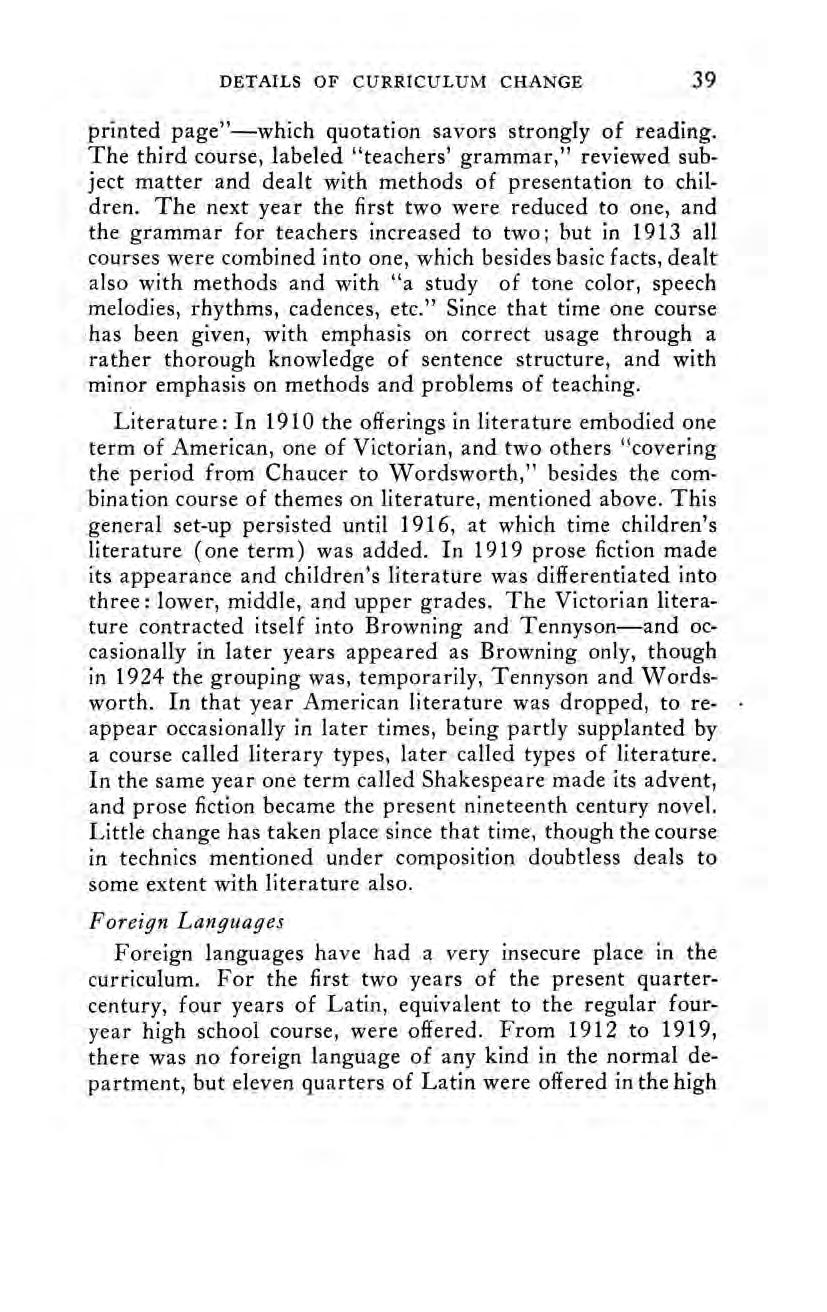
printed page’’—which quotation savors strongly of reading. The third course, labeled ‘‘teachers’ grammar,” reviewed subject matter and dealt with methods of presentation to children. The next year the first two were reduced to one, and the grammar for teachers increased to two; but in 1913 all courses were combined into one, which besides basic facts, dealt also with methods and with ‘a study of tone color, speech melodies, rhythms, cadences, etc.’’ Since that time one course thas been given, with emphasis on correct usage through a rather thorough knowledge of sentence structure, and with minor emphasis on methods and problems of teaching.
Literature: In 1910 the offerings in literature embodied one term of American, one of Victorian, and two others “covering the period from Chaucer to Wordsworth,” besides the combination course of themes on literature, mentioned above. This general set-up persisted until 1916, at which time children’s literature (one term) was added. In 1919 prose fiction made its appearance and children’s literature was differentiated into three: lower, middle, and upper grades. The Victorian literature contracted itself into Browning and Tennyson—and occasionally in later years appeared as Browning only, though in 1924 the grouping was, temporarily, Tennyson and Wordsworth. In that year American literature was dropped, to reappear occasionally in later times, being partly supplanted by a course called literary types, later called types of literature. In the same year one term called Shakespeare made its advent, and prose fiction became the present nineteenth century novel. Little change has taken place since that time, though the course in technics mentioned under composition doubtless deals to some extent with literature also.
Foreign languages have had a very insecure place in the curriculum. For the first two years of the present quartercentury, four years of Latin, equivalent to the regular fouryear high school course, were offered. From 1912 to 1919, there was no foreign language of any kind in the normal department, but eleven quarters of Latin were offered in the high

school or academic department. Then for a period of three years, 1919 to 1922, elementary French and a year of intermediate French were offered. These courses were omitted in 1922-23; given again in 1923-24; then discontinued from 1924 to 1929. From 1929 to 1932, courses in second and third-year French were offered, then all foreign language was omitted until 1934-35, during which a course in beginning French was given.
This seems to reflect the border-line character of foreign languages in a teachers college whose main concern is with elementary education. With an increasing number of students choosing to take a four-year course and with a probable increase in the number preparing for high school teaching, it seems likely that a modern foreign language, probably French, will be given a permanent place in the curriculum.
In 1910, in addition to the four courses in geography, there was one in physiography and one in astronomy. Two years later, physiography was dropped but after another two-year interval it was reinstated and general geography was reduced to one term called teachers geography. A course in commercial geography was added in 1914, but in 1916 the geography of North America was substituted for it and the geography of South America and Europe took the place of physiography. South American geography was eliminated from this latter course in 1919, the full term being devoted to Europe, especially to ‘the geography of the war and reconstruction.”
There was no change from this time until 1926, when one term of each of the following was offered: structural and dynamic geology, historical geology, and astronomy. The latest change in the offerings in this field is the addition, in 1931, of a course in the geography of South America.
The college attitude toward handwriting has changed materially in the past twenty-five years.
In 1914, when the first catalog description of such a course appeared, handwriting was required of all students, who met
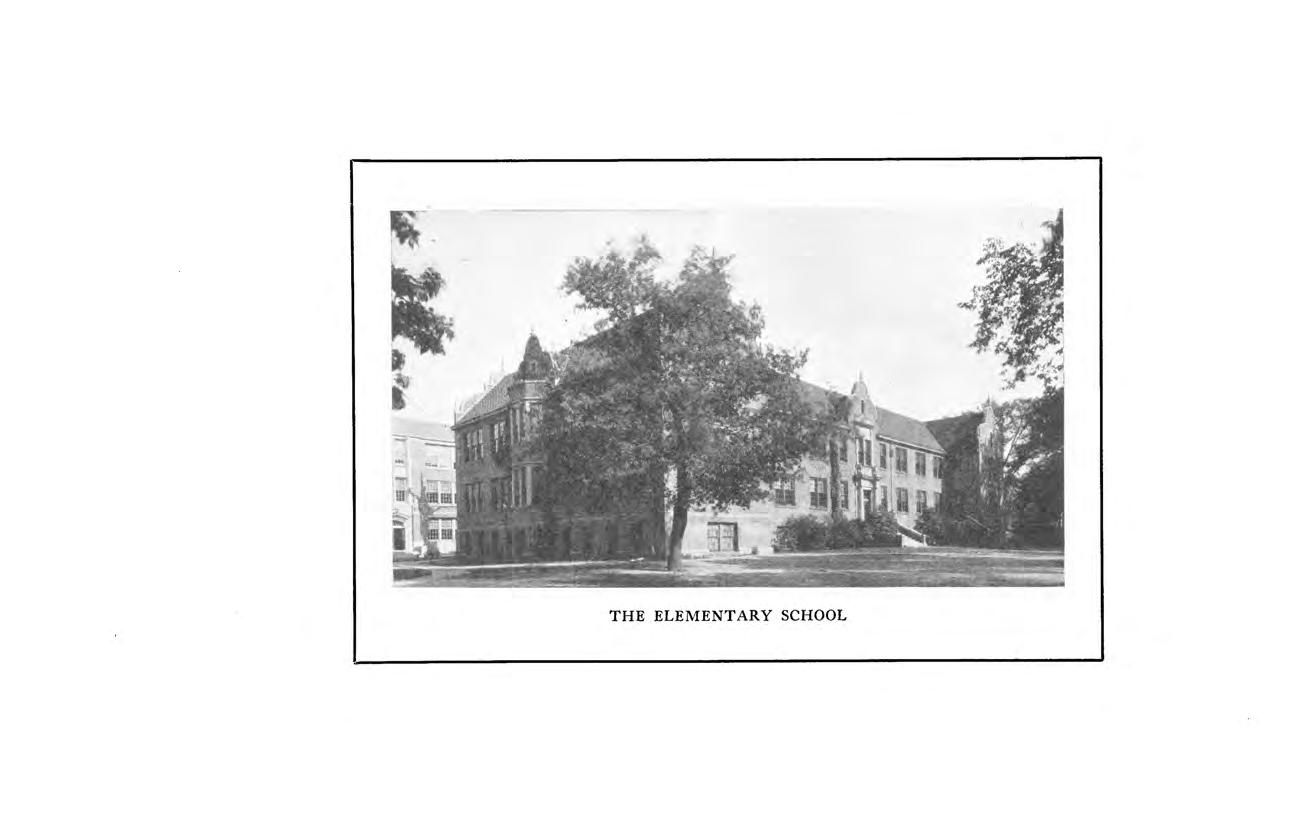
THE ELEMENTARY SCHOOL

daily for one quarter to “acquire good handwriting and also thorough study of the method of instruction to earn the Palmer Teacher’s Certificate.”
In 1930, a second course, ‘Supervision of Penmanship,” to ‘give students the opportunity to observe and teach penmanship,’ was offered. However, at the end of two years handwriting as a formal required subject for all was dropped from the curriculum. Since then it hasbeen regarded as a subject to be taken only by students who by their inability to meet requirements as set up by standard writing scales show need of such training. Such students are aided by a teacher of handwriting to diagnose their individual difficulties and do the necessary remedial work to enable them to write legibly.
The history offerings twenty-five years ago consisted of three courses in American history, the first two taking the student through the revolutionary period, and the third covering the period ‘“‘from 1750 to date;’ three courses in general history, the first extending back to earliest historic times, the second covering the period from the eleventh century through the French Revolution, and the third covering nineteenth century Europe; and one course in English history, emphasizing the decline of absolute government and the relation of English history to American culture.
In 1912, one course in American history was named ‘‘teachers’ American history,” to distinguish it from the courses taught in the high school department. This suggests the beginning of such issues as the “‘professionalization of subject matter’ and the provision of ‘‘materials and methods” courses. Two years later, two of the American history courses were ‘teachers’ courses.”
In 1917, an even stronger emphasis upon professionalization seems to be reflected in the title, “history 3, methods and materials for the grades.”
In 1914, one course in general history was discontinued and a course in industrial history of the United States was substituted. This offering was soon discontinued, however.

From one to three courses in history of modern Europe have been given from 1917 to the present. The titles in later years do not indicate any special emphasis upon ‘“‘teachers’ courses.’’ Separate courses in ancient history and medieval history are now available; also a course in contemporary history, stressing developments since the World War. One of the two courses offered in what might be called general American history is required of all students.
From 1913 to 1914-15 inclusive the school had a threeyear high school course, and a two-year teachers course. It was therefore necessary to teach the mathematics of the high school and a very complete course was offered, more extensive than the majority of high schoolsin Minnesota offer. There were three courses in algebra, equivalent to what we now call elementary algebra and higher algebra; a full year of plane geometry, and a course in solid geometry.
In the teachers course two years of arithmetic were offered; one a course mainly devoted to computation arithmetic, and a second course in which subject matter was reviewed and methods of presenting it were discussed.
In 1914, the preparatory course was cut to two years, but the mathematics remained the same except that a year of trigonometry was added. This was added for the benefit of the Normal School students, as demands were coming in for teachers who had specialized in mathematics, due probably to the growth of the junior high school.
In 1917 the Normal School course was lengthened to three years but the mathematics offerings remained the same. A year later, however, a course in analytic geometry was added.
In 1919 a change was made in the work in arithmetic. The only course given in this subject emphasized teaching methods rather than subject matter on which the emphasis had been placed up to this time. From 1910 on a number of very good books had been written dealing with the methods of teaching arithmetic, so that it was now possible to have a reference library which was quite adequate on this subject.

The number of junior high schools in the state was increasing each year, so a new course in junior-high school mathematics was introduced, in which both subject matter and method were emphasized. It was especially necessary to emphasize subject matter in algebra and trigonometry.
The junior college idea was growing in this state and the number of students in the school who wished academic work was increasing, so that a course in college algebra was introduced in 1920; and in 1922, after a junior college curriculum was formally organized in the school, two courses in calculus were offered inthe catalog although only one was given, due to lack of teachers.
With the development of the four-year course, there has been a natural demand on the part of some students for an opportunity to major in mathematics. A course in the history of mathematics was offered in 1926, the year of graduation of the first degree class. In the current year a second course in calculus is being given. Additional desirable courses will no doubt be offered for those wishing to teach mathematics in high schools as soon as additional help is available in the department.
During the first ten years of this quarter-century, there were just two courses in psychology. These were definitely introspective in their point of view and in their objective.
With a change of instructors in 1920, the shift from introspective to behavioristic psychology was evident, although the new emphasis was not extreme. The second of the two courses in psychology became definitely a course in learning, with emphasis upon individual differences, measurement, and correlation. Educational measurement was offered as a separate course in the summer of 1921 and has been offered regularly since 1925-26. Courses in psychology of the common branches, in mental hygiene, in social psychology, and in fields of psychology have all been added to the offerings in this field since 1926.

In 1910, the science offerings of the Winona State Normal School included a course in physiology, two courses in chemistry, two in botany, threein physics, one in elementary science and one elective course in advanced physics. A year later, two elective courses in agriculture were listed, and two units of work in zoology. A few years later, two additional courses in organic and food chemistry were given, as was also a course in bacteriology, all as required in the special home-economics curriculum.
The field designated by the term physiology in 1910 has had a rather frequent change of name, accompanied by changes in emphasis and content. At one time this single course was labeled physiology, hygiene, and anatomy; later the name physiology and sanitation was used; then hygiene and sanitation, the name that has persisted to the present.
The offerings were sharply contracted in 1917 after the elimination of the high school department, both physics and botany being discontinued. The courses in food chemistry and bacteriology were discontinued with the elimination of the special curriculum in home economics.
The old course in elementary science became ‘‘nature study”’ in 1923 without any significant change in content as the course is described in the catalog.
For some time after the fire in 1922, funds were not available for equipping the laboratories, so the offerings were limited until the late 1920's, physics, chemistry, and zoology all disappearing from the list of offerings. Two units of biology were announced in 1926; hygiene and sanitation was transferred from the physical education department and was listed with the science courses; a course in home nursing was given. In 1928, the chemistry laboratory was equipped and two chemistry courses were offered. Two years later “science for upper-grade teachers”? was announced as was also one unit in botany. Two terms of physics were provided soon thereafter. The latest addition to the science offerings is a course in quantitative analysis.

The curriculum in 1910-11 included one course named “'social science,” three courses in civics, and an elective course in economics. In 1914-15 only two civics courses were given, and there were two courses in “‘social science,” these being named specifically economics and sociology. Two or three years later, civics was reduced to one term.
In 1919, rural sociology was offered as an alternative to the “regular” course in sociology. Civics became ‘American government” in 1924. Educational sociology was introduced in 1925-26, and child guidance a year later, for the first of a three-year demonstration of visiting-teacher work under the Commonwealth Fund. Rural sociology was dropped from the list of offerings in the catalog for 1928-29. ‘Two years later, two new courses were listed: American social problems and education and present world issues. Since 1932, the list of subjects has beenconsiderably increased by the addition of courses in cultural evolution, political parties, money and banking, and social progress.
A major in social science as now defined by the Minnesota Teachers Colleges does not include courses in history.
The college has placed definite but somewhat shifting emphasis upon training in reading and speech during this past quarter-century. In 1912-13, there were three courses in reading. A year later, two of these were labeled ‘teachers courses” and a course in public speaking was added. The next year two of the reading courses were dropped. A course in rhetoric, listed with the English courses, was in reality a course in speech. The catalog description read as follows: “A study of the means of affecting others through speech. Attention is centered on the listener. The student is taught how clearness, unity, and coherence, and rhythmic and figurative qualities of speech help him to affect his hearers.” A paragraph entitled “Expression” and stressing the need for “‘constant practice in oral and written expression” in English courses was printed in the catalog year after year until 1920-21 in the section de-
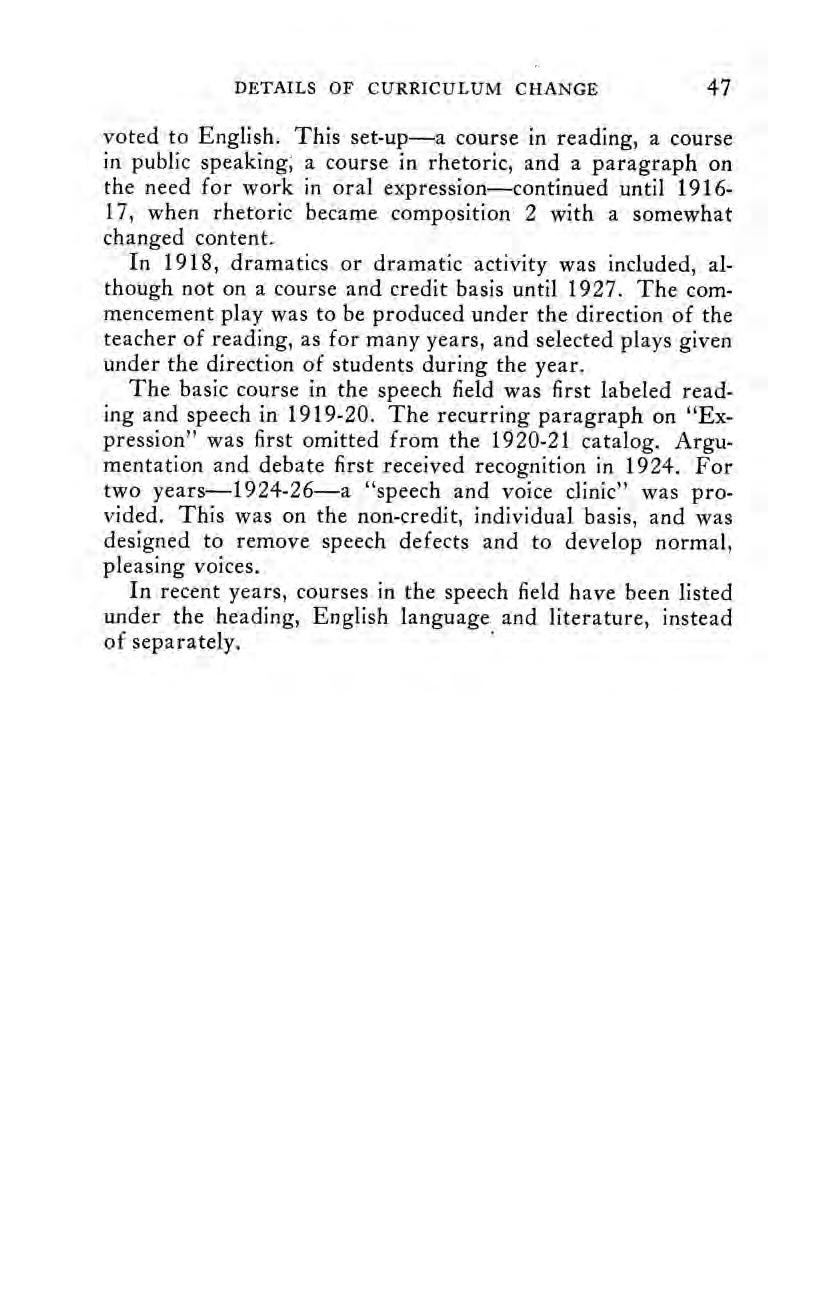
voted to English. This set-up—a course in reading, a course in public speaking, a course in rhetoric, and a paragraph on the need for work in oral expression—continued until 191617, when rhetoric became composition 2 with a somewhat changed content.
In 1918, dramatics or dramatic activity was included, although not on a course and credit basis until 1927. The commencement play was to be produced under the direction of the teacher of reading, as for many years, and selected plays given under the direction of students during the year.
The basic course in the speech field was first labeled reading and speech in 1919-20. The recurring paragraph on ‘“Expression” was first omitted from the 1920-21 catalog. Argumentation and debate first received recognition in 1924. For two years—1924-26—a “speech and voice clinic’? was provided. This was on the non-credit, individual basis, and was designed to remove speech defects and to develop normal, pleasing voices.
In recent years, courses in the speech field have been listed under the heading, English language and literature, instead of separately.

Figures showing the number of students enrolled and the number graduated each year since 1910 are presented in Table I. The table reveals a remarkable uniformity throughout the period, remarkable in the light of such factors as occasional official change in certification requirements, the occasional addition or elimination of a special field, the erection of a new teachers college near by in a sister state, the unorganized social pressure toward longer periods of training, the economic depressions of the 20’s and 30’s, all of which must have had some effect upon student enrollment.
The number of faculty members has remained practically constant since 1914.
The number of graduates from the four-year course is increasing. The three “honorary” diplomas (1930) were granted to the three members of the first class of the Winona State Normal School who were still living at the time of the 70th anniversary of the founding of the school. *
As would be anticipated, young women have constituted a very large proportion of the enrollment. In Table II, the percentage that young men were of the total student enrollment from 1910 to 1935 is shown.
The school has not been entirely complacent about the great disparity in numbers as between the sexes. In the president’s report to the Normal School Board on September 17, 1914, reference was made to the fact that there had been an allschool meeting to discuss the question, ‘“‘How to Interest More Boys.’ Beginning a men’s inter-scholastic athletic program under a trained coach in 1920-21 was valued partly because of the fact that it was expected to increase the number and the proportion of men students.
* For figures covering the period from 1860 to 1910. see Ruggles, Op. Cit., p. 118-120.

FIRST DEGREE CLASS, 1926
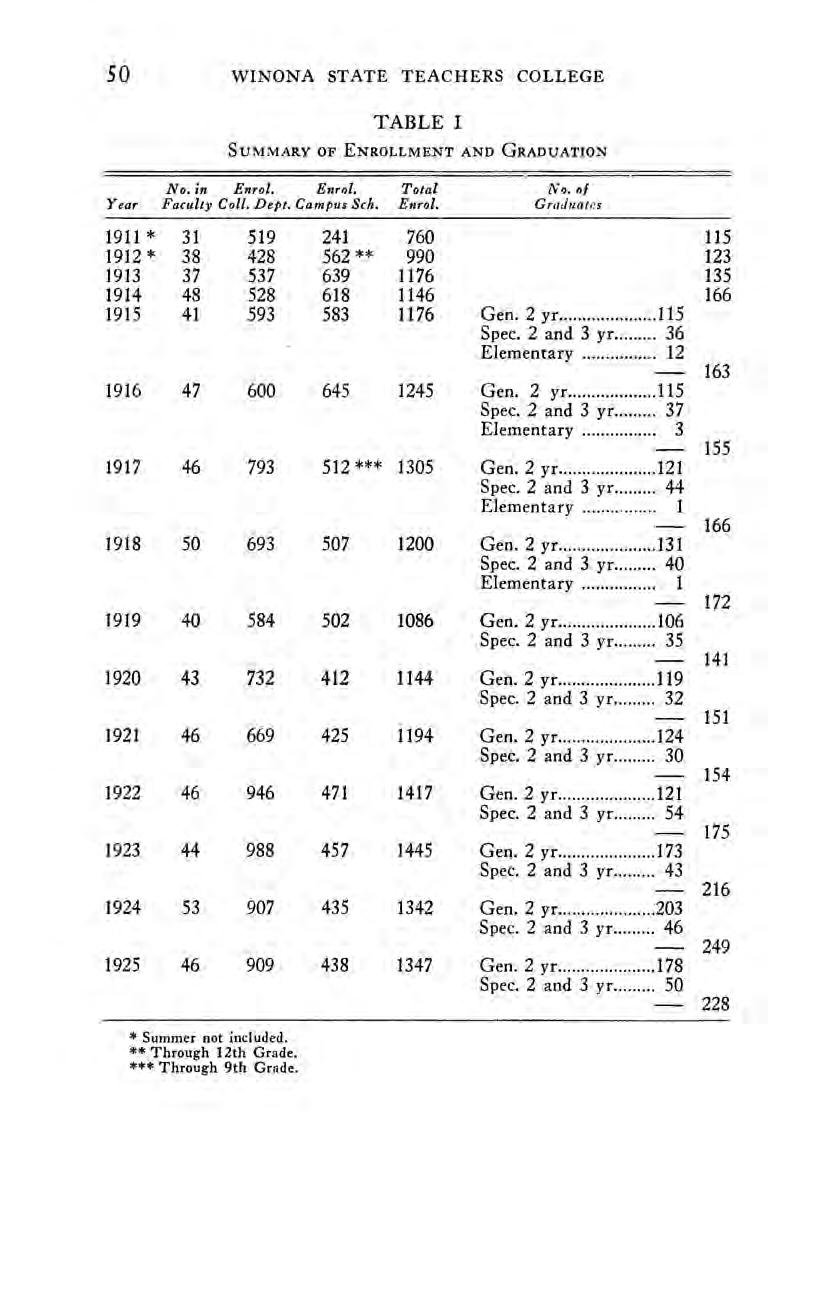
Summer not included.
Through 12th Grade.
Through 9th Grade.

Part-time teachers included.

Arguments in support of the maintenance of a junior college curriculum included the point that it would tend to create a better social condition in that it would decrease the disparity between the sexes. Later, in 1930, in a catalog statement supporting the four-year program, it was asserted that ‘‘the higher standards call men to public-school service. The lack of men teachers is a grave social weakness. With the longer basic training, men are called to attractive and permanent -places in the field of teaching.”
*
The location of the school, almost at the very corner of the state, cuts down its natural patronage area very sharply as compared to that of some of the other Minnesota teachers colleges. The fact that its enrollment has maintaineda relatively high level with a minimum use of promotion methods is a notable evidence of its general standing. Such bulletins as have been distributed and such public announcements as have been madehave been of the informational type. Well-edited, attractive pamphlets, in addition to the annual catalog, telling of the opportunities for training to be found at Winona, have been available to all making inquiry. Members of the professional staff, on invitation, have served as judges in school contests and as speakers at commencements and other events;
* It is of interest to note that just one graduating class in the history of the school has contained more men than women. This was the class of 1872, of which Charles A. Morey was a member. It included nine women and twelve men.
college musical and other groups have given occasional programs away from the college and have gone out on occasional short “tours.’’ Indirectly, it may be assumed, these activities probably have had some favorable effect upon enrollment.

At one time, the school did formulate and publish, in its catalogs, several striking statements addressed to high school teachers and students and incidentally to the general public, urging the importance of teaching and the need for increased attendance in teachers colleges. This was in the period from 1920 to 1924, when there was a shortage of qualified teachers. This was no selfish appeal on behalf of the Winona college. The need for well-trained teachers was discussed on the high level of social responsibility and social leadership. ‘These statements are quite characteristic of the spirit of the college in. relation to size and quality of enrollment.
The first, includedin the catalog published in May, 1920, was entitled, ‘“The Call to Teach,” and read, in part, as follows:
“Something has Happened to Teaching. It has become one of the great opportunities. The outstanding single sign of this change is that all the country begins to know that teachers, like soldiers, are in the service of the
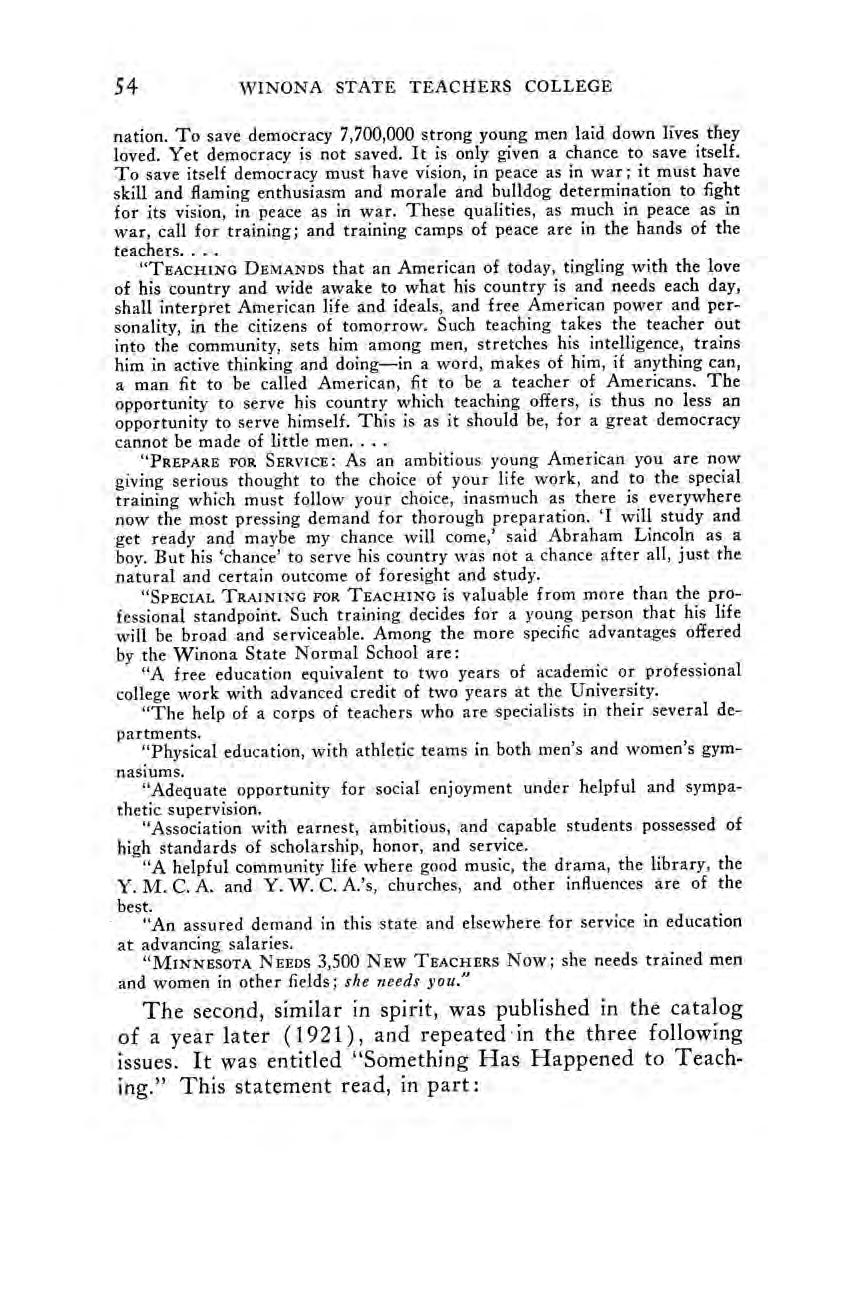
nation. To save democracy 7,700,000 strong young men laid down lives they loved. Yet democracy is not saved. It is only given a chance to save itself. To save itself democracy must have vision, in peace as in war; it must have skill and flaming enthusiasm and morale and bulldog determination to fight for its vision, in peace as in war. These qualities, as much in peace as in war, call for training; and training camps of peace are in the hands of the teachers.
“TEACHING DEMANDS that an American of today, tingling with thelove of his country and wide awake to what his country is and needs each day, shall interpret American life and ideals, and free American power and personality, in the citizens of tomorrow. Such teaching takes the teacher out into the community, sets him among men, stretches his intelligence, trains him in active thinking and doing—in a word, makes of him, if anything can, a man fit to be called American, fit to be a teacher of Americans. The opportunity to serve his country which teaching offers, is thus no less an opportunity to serve himself. This is as it should be, for a great democracy cannot be made of little men...
“PREPARE FOR SERVICE: As an ambitious young American you are now giving serious thought to the choice of your life work, and to the special training which must follow your choice, inasmuch as there is everywhere now the most pressing demand for thorough preparation. ‘I will study and get ready and maybe my chance will come,’ said Abraham Lincoln as a boy. But his ‘chance’ to serve his country was not a chance after all, just the natural and certain outcome of foresight and study.
“SpRcIAL TRAINING FOR TEACHING is valuable from more than the professional standpoint. Such training decides for a young person that his life will be broad and serviceable. Among the more specific advantages offered by the Winona State Normal School are:
“A free education equivalent to two years of academic or professional college work with advanced credit of two years at the University.
“The help of a corps of teachers who are specialists in their several departments.
“Physical education, with athletic teams in both men’s and women’s gymnasiums.
“Adequate opportunity for social enjoyment under helpful and sympathetic supervision.
“Association with earnest, ambitious, and capable students possessed of high standards of scholarship, honor, and service.
“A helpful community life where good music, the drama, the library, the Y.M.C.A. and Y. W.C. A.’s, churches, and other influences are of the best.
“An assured demand in this state and elsewhere for service in education at advancing salaries.
“Minnesota Neeps 3,500 New Tracuers Now; she needs trained men and women in other fields; she needs you.”
The second, similar in spirit, was published in the catalog of a year later (1921), and repeated:in the three following issues. It was entitled “Something Has Happened to Teaching.” This statement read, in part:

“The teacher’s value is rising. Everybody knows this. Everybody is going into his pocket for his bit toward the higher salaries for teachers. Everybody picks up his paper to read of the need for these higher salaries. He turns to his magazine to read of the need for better teachers. He goes to meetings to hear the need of better schools. He opens his mail to find arguments for and against the education bills before his legislature, or before the Congress. All these things write clear in the most indifferent mind that teaching is somehow coming to be held more important than it used to be.
“Not everybody, however, sees exactly why the teacher’s value is rising. There are some who think vaguely of the change in the teacher’s position as merely a part of the unrest which followed the war. It is not a part of this unrest. It is part of a new knowledge given us by the war; and of a new fear, and a new hope, and a new certainty, which leaped at us out of that knowledge. The new knowledge is the black fact that one out of four of our American youth of draft age could not even read and write. The new fear is a dark vision of masses of Americans with blind minds and unkindled hearts, leading our land to chaos. The new hope is a bright vision of a hundred million Americans with eyes to see and hearts to understand, leading our land to brotherhood and greatness. The new certainty is the breathtaking one that it is the teachers of the land whoshall say which of these two visions shall be made fact...
“For this great task of guardianship, America is this moment calling for 1,000,000 of her very best. She is calling for high ability, quick imagination, warm sympathy, the power to start things, the power to put through what is started. She is pleading for teachers who can dream and who can act. She is seeking minds of force enough to grasp not only what she is, but what she must be; natures fine-tuned enough to feel both a nation’s need and a little child’s... .”
Another statement inthe catalogs for 1922, 1923, and 1924 attacked the same problem in a more specific manner, under the heading, ‘‘A High School’s Quota”:
“We need from 3,200 to 3,600 new teachers in Minnesota each year. Our high schools graduate about 7,000 annually. Every third graduate, at least, should be enlisted for service asa teacher, and should enter a teachertraining institution.
“High school principals and teachers ought to realize that, as public servants, their first duty is to the cause of education. They should advise an increasing number of their promising students to consider courses leading to the teachers college diploma.
“The high school principal should point out to his seniors: (1) that war professions and war salaries are being done away with, and that peace time habits must be taken up again; (2) that there is a necessity for teachers; (3) that teachers are well paid, and that they will continue to be well paid; (4) that teaching offers an opportunity for social service and an assurance of community respect; (5) that adequate training is necessary; (6) that the teachers colleges of this state offer such training free; (7) and finally, that a teachers college graduate is sure of securing a satisfactory position. In any case the principal should make certain that he sends his quota, one graduate out of three, to some teacher training institution.”

The Society of the Alumni of the State Normal School at Winona was organized in 1875 under the leadership of Mr. William F. Phelps, principal of the school. Its objects were declared to be to promote a more intimate relationship between theschool and its graduates and pupils, and to advance their mutual interests as well as the cause of popular education in the State of Minnesota.
The minutes do not show any marked activities during the period covered by this volume until 1923, when many alumni were appealed to for subscriptions to the memorial organ. To this appeal about six hundred persons responded. In 1930, at the time of the Seventieth Year Anniversary, the organization was incorporated under the laws of Minnesota as the Alumni Society of Winona State Teachers College, and took an active part in securing a fourteen-thousand-dollar scholarship fund. To this fund about 450 alumni and others contributed. The Society has been active since that time. It has aided students through loans from its funds. It has supported biennial reunions since 1913 in the Twin Cities, at the time of the Minnesota Education Association meetings. It has collected and organized data for proposed legislation, carried an alumni column in The Winonan, student publication, sponsored an excursion to Washington, D. C., and organized and carried through to success two “round-ups” for loyal Winona alumni. Alumni, former students, and present and former faculty members are eligible for active membership. The life membership fee is five dollars, and the annual membership fee is one dollar. The society has 173 life members and forty annual members on its roll, June, 1935.
In the last five years the Board of Directors has elected to honorary membership Mr. and Mrs. Paul Watkins, Mr. and Mrs. H. C. Garvin, Mr. W. W. Norton, Mr. C. M. Youmans, Mrs. Ione DeLong Tearse, Mr. Ell Torrance, Mr. R. H. Watkins, and Mr. S. H. Somsen. The present officers for 1934-35 are Dr. R. B. Le May, President; Mrs. L. J. Luhmann, Vice-president; and Miss Mabel Marvin, Secretarytreasurer.
The staff has varied in size from 31 to 53, the number in recent years being in the lower and middle forties. (See Table I.) Although election is for one year only, inspection of the records indicates that tenure is relatively long. For example, fully half of the staff for 1934-35 have held their positions for nine years or more, the longest service of any present member being 35 years.
Worthy of note, too, is the amount of professional training. An approximate measure of training is the highest academic degree held. In Table III will be found a comparison of the total faculties of the five-year period preceding 1910 with the latest five-year period, 1929-34.
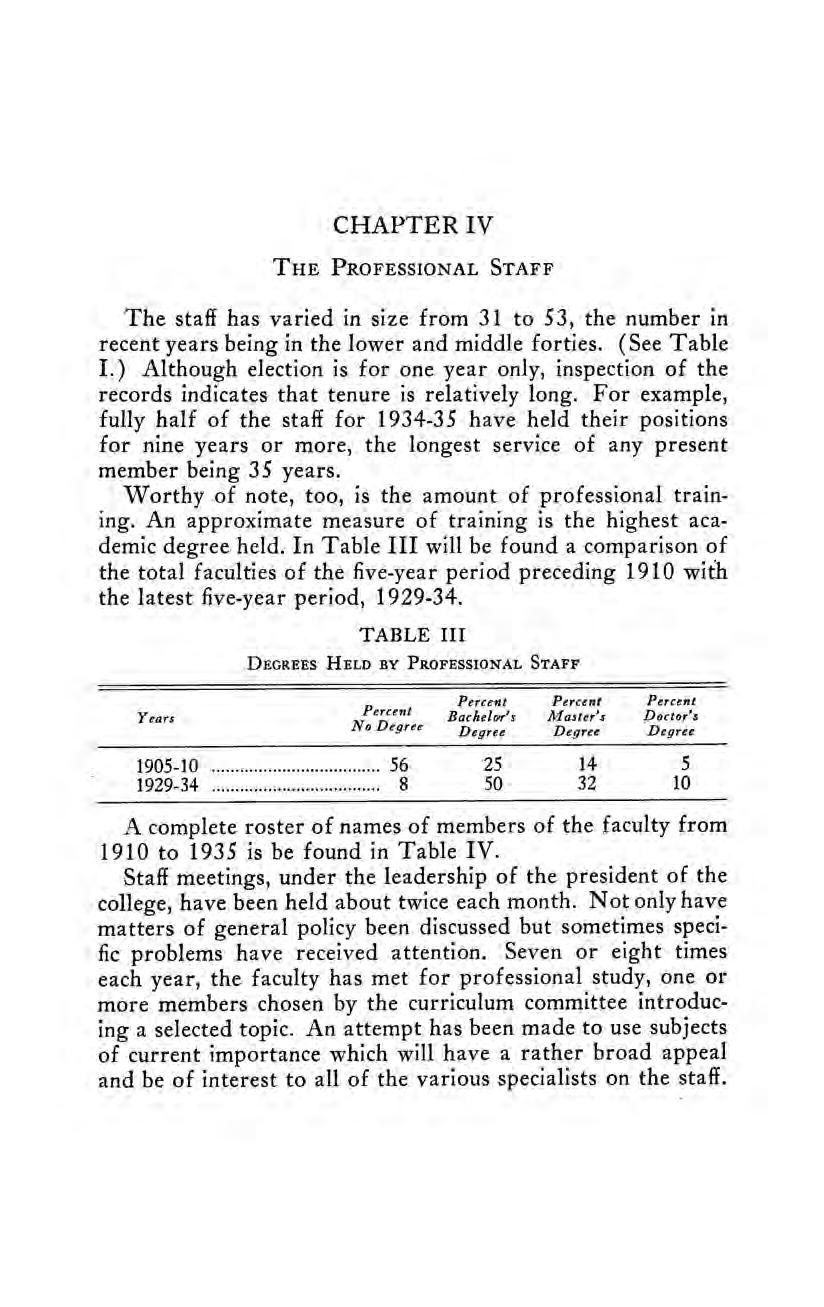
A complete roster of names of members of the faculty from 1910 to 1935 is be found in Table IV.
Staff meetings, under the leadership of the president of the college, have been held about twice each month. Not only have matters of general policy been discussed but sometimes specific problems have received attention. Seven or eight times each year, the faculty has met for professional study, one or more members chosen by the curriculum committee introducing a selected topic. An attempt has been made to use subjects of current importance which will have a rather broad appeal and be of interest to all of the various specialists on the staff.
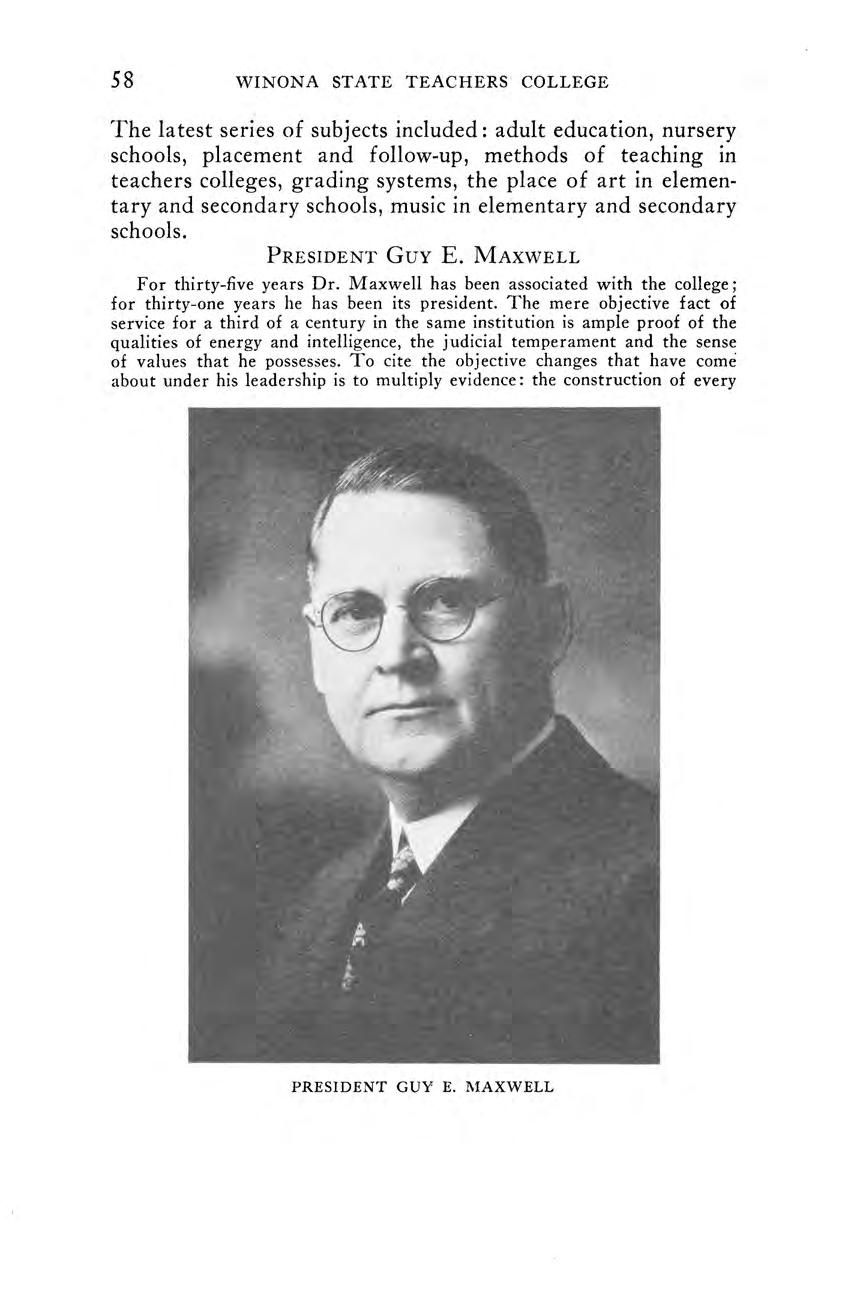
The latest series of subjects included: adult education, nursery schools, placement and follow-up, methods of teaching in teachers colleges, grading systems, the place of art in elementary and secondary schools, music in elementary and secondary schools.
For thirty-five years Dr. Maxwell has been associated with the college; for thirty-one years he has been its president. The mere objective fact of service for a third of a century in the same institution is ample proof of the qualities of energy and intelligence, the judicial temperament and the sense of values that he possesses. To cite the objective changes that have come about under his leadership is to multiply evidence: the construction of every
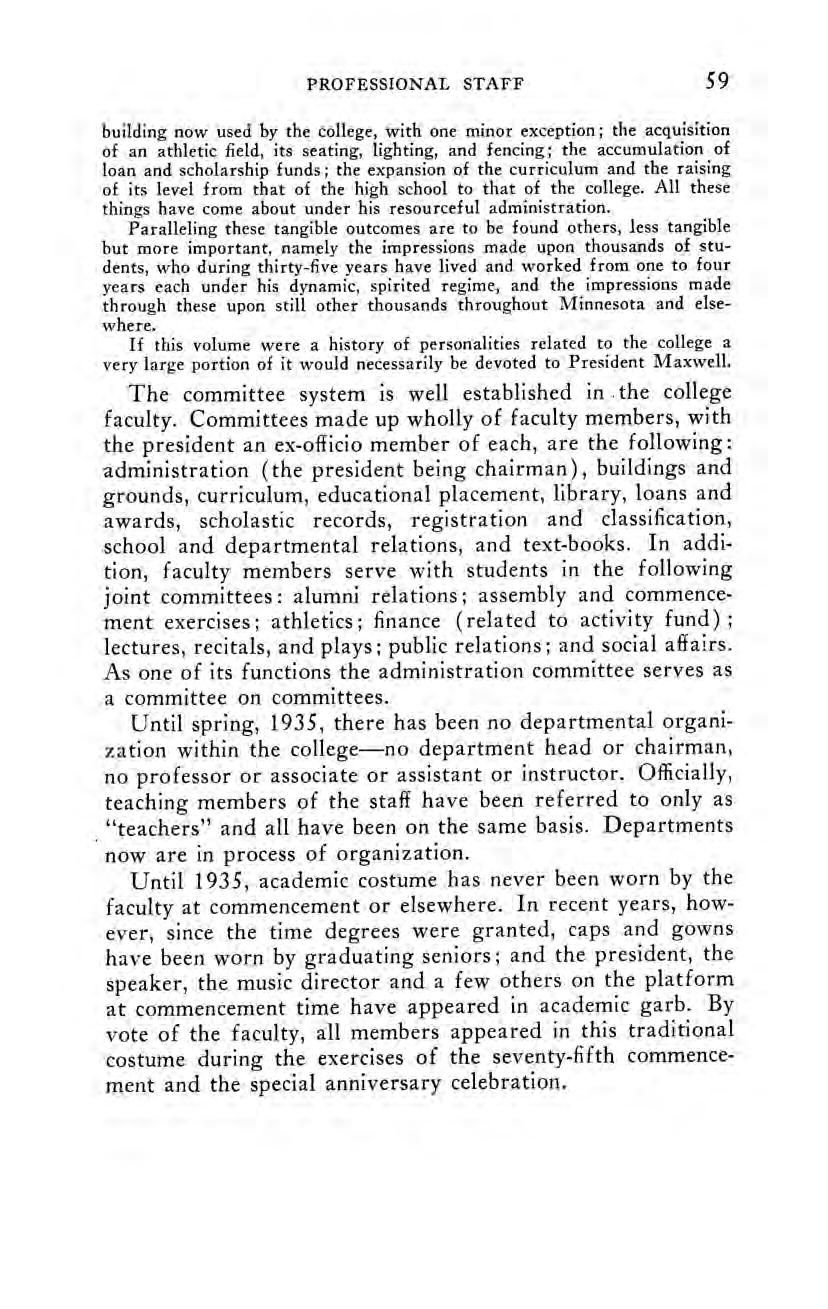
building now used by the college, with one minor exception; the acquisition of an athletic field, its seating, lighting, and fencing; the accumulation of loan and scholarship funds; the expansion of the curriculum and the raising of its level from that of the high school to that of the college. All these things have come about under his resourceful administration.
Paralleling these tangible outcomes are to be found others, less tangible but more important, namely the impressions made upon thousands of students, who during thirty-five years have lived and worked from one to four years each under his dynamic, spirited regime, and the impressions made through these upon still other thousands throughout Minnesota and elsewhere.
If this volume were a history of personalities related to the college a very large portion of it would necessarily be devoted to President Maxwell.
The committee system is well established in.the college faculty. Committees made up wholly of faculty members, with the president an ex-officio member of each, are the following: administration (the president being chairman), buildings and grounds, curriculum, educational placement, library, loans and awards, scholastic records, registration and classification, school and departmental relations, and text-books. In addition, faculty members serve with students in the following joint committees: alumni relations; assembly and commencement exercises; athletics; finance (related to activity fund); lectures, recitals, and plays; public relations; and social affairs. As one of its functions the administration committee serves as a committee on committees.
Until spring, 1935, there has been no departmental organization within the college—no department head or chairman, no professor or associate or assistant or instructor. Offcially, teaching members of the staff have been referred to only as “teachers” and all have been on the same basis. Departments now are in process of organization.
Until 1935, academic costume has never been worn by the faculty at commencement or elsewhere. In recent years, however, since the time degrees were granted, caps and gowns have been worn by graduating seniors; and the president, the speaker, the music director and a few others on the platform at commencement time have appeared in academic garb. By vote of the faculty, all members appeared in this traditional costume during the exercises of the seventy-fifth commencement and the special anniversary celebration.
Facu.ty Recister 1910-1935
In order of seniority of service
Name Dates of Office
Guy E. Maxwell

Present Address Service
1900-1904 Directorof Training Walnut and Lake Drive, 1904- President Winona, Minnesota
Kate L. Sprague 1882-1912 Mathematics Farmington, Michigan 1913-1918
John M. Holzinger 1882-1922 Elem. Sci. and Botany Deceased
Caroline V. Smith 1889-1918 Vocal Music and Penman. 706 Johnson Street, Winona, Minnesota
Bertha H. Speckman 1891-1914 Drawing Deceased 1915-1920 1921-1932
J. S. Gaylord
1898-1920 Psych. and Hist. of Ed. E. Longmeadow, Mass.
Harriett M. Packard 1893-1898 Ass’t. in Kindergarten Deceased 1899-1910
Theda Gildemeister 1898-1905 Critic, Supervisor of 311 West Tremont St.. 1906-1934 Training, Education Hillsboro, Illinois
Mary Grant 1900-1925 Librarian 369 West Fifth Street, Winona, Minnesota
William H. Munson
1901- Zoology and Phys. Science Winona, Minnesota
Carrie F. Saunders 1901-1911 Teacher in Elem. School Onalaska, Wisconsin
Helen Ford Staples 1902-1920Teacher in Elem. School 805 Maryland Avenue, Milwaukee, Wisconsin
Charlotte B. Chorpenning 1904-1913 English Language and Northwestern University, 1914-1921 Literature Evanston, [1linois
Harriett I. Carter 1906-1912 Teacher in Elem. School 6344 Aurelia Street, Pittsburgh, Penn.
J. H. Sandt 1906-1932 Manual Training
Frances M. Smith 1907-1915 Teacher in Elem. School 1921-1925
Deceased
Nora Atwood 1910-1911 Directorof Kindergarten 1316 Euclid Avenue, Washington, D. C.
Agnes G. Storie 1908-1912 Teacher in Elem. School Lodi, Wisconsin
Jane M. Keeler 1908-1912 Reading and Preceptress 545 Elmwood Avenue, Buffalo, New York
Frances W. Barrows 1908-1912 Home Economics Route A, Box 235, Clovis, California
J. L. Stockton
Josephine A. Andrews
1909-1917 Princ. of Elem. School 7706 Eads Avenue, Pedagogy LaJolla, California
1909-1912 Physical Director 117 Carpenter Lane, (Mrs. Walter Magill) Mt. Airy, Penn.
Frances S. Morey 1909-1913 Latin and English c/o Louisville University, (Mrs. Raymond A. Kent) Louisville, Kentucky
Raymond A. Kent 1909-1911 Mathematics President, Louisville University
Clyde O. Ruggles 1909-1913 History, Civics, Social Science Harvard University, Cambridge, Mass.
Florence Wright 1909-1911Teacherin Elem. School H. E. Public Schools, Elizabeth, New Jersey
Alice Wessa 1909-1910 Geography and Physiography 535 Poplar Street, Meadville, Pennsylvania
Dates of Name Service Office
C. G. Sheldon
Alma L. Binzel
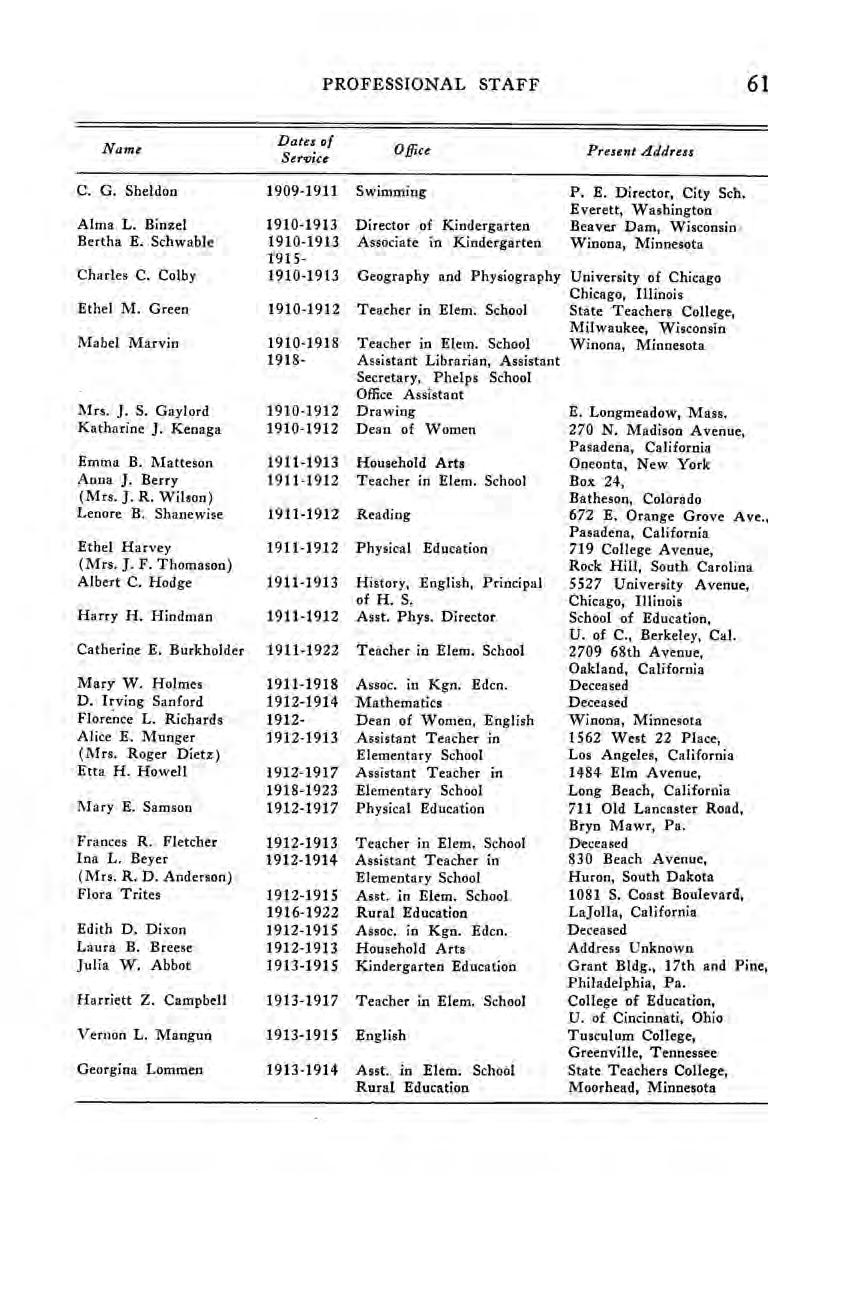
1909-1911 Swimming
Present Address
P. E. Director, City Sch. Everett, Washington
1910-1913 Director of Kindergarten Beaver Dam, Wisconsin
Bertha E. Schwable 1910-1913 Associate in Kindergarten Winona, Minnesota 1915-
Charles C. Colby 1910-1913 Geography and Physiography University of Chicago Chicago, Illinois
Ethel M. Green
1910-1912 Teacher in Elem. School State Teachers College, Milwaukee, Wisconsin
Mabel Marvin 1910-1918 Teacher in Elem. School Winona, Minnesota 1918- Assistant Librarian, Assistant Secretary, Phelps School Office Assistant
Mrs. J. S. Gaylord 1910-1912 Drawing E. Longmeadow, Mass.
Katharine J. Kenaga 1910-1912 Dean of Women 270 N. Madison Avenue, Pasadena, California
Emma B. Matteson 1911-1913 Household Arts
Oneonta, New York
Anna J. Berry 1911-1912 Teacher in Elem. School Box 24,
(Mrs. J. R. Wilson) Batheson, Colorado
Lenore B. Shanewise 1911-1912 Reading 672 E. Orange Grove Ave., Pasadena, California
Ethel Harvey 1911-1912 Physical Education 719 College Avenue, (Mrs. J. F. Thomason) Rock Hill, South Carolina
Albert C. Hodge 1911-1913 History, English, Principal 5527 University Avenue, of H. S. Chicago, Illinois
Harry H. Hindman 1911-1912 Asst. Phys. Director School of Education, U. of C., Berkeley, Cal.
Catherine E. Burkholder 1911-1922 Teacher in Elem. School 2709 68th Avenue, Oakland, California
Mary W. Holmes 1911-1918 Assoc. in Kgn. Eden. Deceased
D. Irving Sanford 1912-1914 Mathematics Deceased
Florence L. Richards 1912- Dean of Women, English Winona, Minnesota
Alice E. Munger 1912-1913 Assistant Teacher in 1562 West 22 Place, (Mrs. Roger Dietz) Elementary School Los Angeles, California
Etta H. Howell 1912-1917 Assistant Teacher in 1484 Elm Avenue, 1918-1923 Elementary School Long Beach, California
Mary E. Samson
Frances R. Fletcher
Ina L. Beyer
1912-1917 Physical Education 711 Old Lancaster Road, Bryn Mawr, Pa.
1912-1913 Teacher in Elem. School Deceased
1912-1914 Assistant Teacher in 830 Beach Avenue,
(Mrs. R. D. Anderson) Elementary School Huron, South Dakota
Flora Trites
Edith D. Dixon
Laura B. Breese
Julia W. Abbot
Harriett Z. Campbell
Vernon L. Mangun
Georgina Lommen
1912-1915 Asst. in Elem. School 1081 S. Coast Boulevard, 1916-1922 Rural Education LaJolla, California
1912-1915 Assoc. in Kgn. Eden. Deceased
1912-1913 Household Arts Address Unknown
1913-1915 Kindergarten Education Grant Bldg., 17th and Pine, Philadelphia, Pa.
1913-1917 Teacher in Elem. School College of Education, U. of Cincinnati, Ohio
1913-1915 English Tusculum College, Greenville, Tennessee
1913-1914 Asst. in Elem. School State Teachers College, Rural Education Moorhead, Minnesota
Name Dates of Office
Floyd W. Moore
Maude F. Shafer
Walter O. Abram
Helen Kirschstein
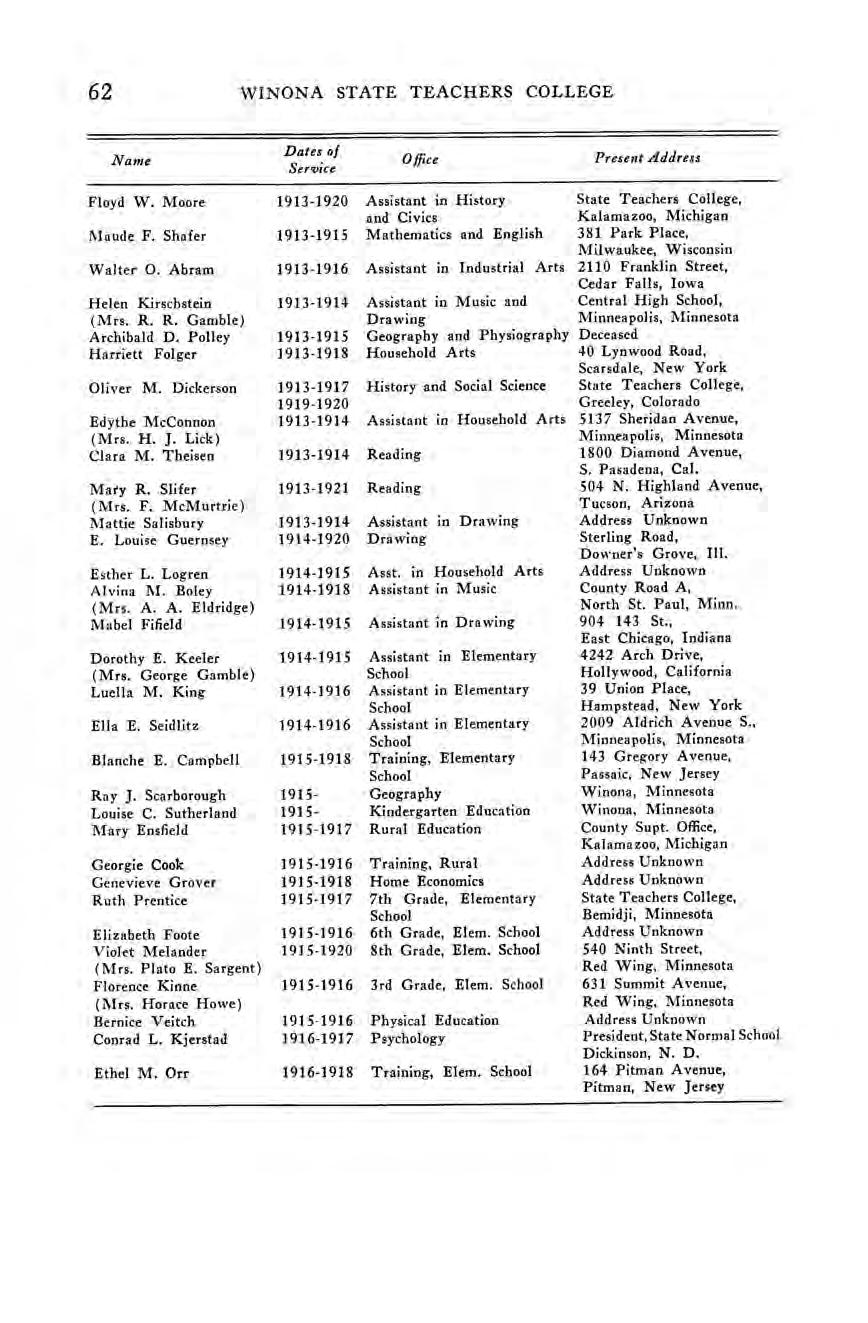
Present Address Service
1913-1920 Assistant in History State Teachers College, and Civics Kalamazoo, Michigan
1913-1915 Mathematics and English 381 Park Place, Milwaukee, Wisconsin
1913-1916 Assistant in Industrial Arts 2110 Franklin Street, Cedar Falls, Iowa
1913-1914 Assistant in Music and Central High School, (Mrs. R.R. Gamble) Drawing Minneapolis, Minnesota
Archibald D. Polley 1913-1915 Geography and Physiography Deceased
Harriett Folger
Oliver M. Dickerson
Edythe McConnon
1913-1918 Household Arts 40 Lynwood Road, Scarsdale, New York
1913-1917 History and Social Science State Teachers College, 1919-1920 Greeley, Colorado
1913-1914 Assistant in Household Arts 5137 Sheridan Avenue, (Mrs. H. J. Lick) Minneapolis, Minnesota
Clara M. Theisen
Mary R. Slifer
1913-1914 Reading 1800 Diamond Avenue, S. Pasadena, Cal.
1913-1921 Reading 504 N. Highland Avenue, (Mrs. F. McMuttrie) Tucson, Arizona
Mattie Salisbury
1913-1914 Assistant in Drawing Address Unknown E. Louise Guernsey 1914-1920 Drawing Sterling Road, Downer’s Grove, III.
Esther L. Logren 1914-1915 Asst. in Household Arts Address Unknown
Alvina M. Boley 1914-1918 Assistant in Music County Road A, (Mrs. A. A. Eldridge) North St. Paul, Minn.
Mabel Fifield
1914-1915 Assistant in Drawing 904 143 St., East Chicago, Indiana
Dorothy E. Keeler 1914-1915 Assistant in Elementary 4242 Arch Drive, (Mrs. George Gamble) School Hollywood, California
Luella M. King 1914-1916 Assistant in Elementary 39 Union Place, School Hampstead, New York
Ella E. Seidlitz 1914-1916 Assistant in Elementary 2009 Aldrich Avenue S., School Minneapolis, Minnesota
Blanche E. Campbell 1915-1918 Training, Elementary 143 Gregory Avenue, School Passaic, New Jersey
Ray J. Scarborough 1915- Geography Winona, Minnesota
Louise C. Sutherland 1915- Kindergarten Education Winona, Minnesota
Mary Ensfield 1915-1917 Rural Education County Supt. Office, Kalamazoo, Michigan
Georgie Cook 1915-1916 Training, Rural
Genevieve Grover 1915-1918 Home Economics
Address Unknown
Address Unknown
Ruth Prentice 1915-1917 7th Grade, Elementary State Teachers College, School Bemidji, Minnesota
Elizabeth Foote 1915-1916 6th Grade, Elem. School
Address Unknown
Violet Melander 1915-1920 8th Grade, Elem. School 540 Ninth Street, (Mrs. Plato E. Sargent) Red Wing, Minnesota
Florence Kinne 1915-1916 3rd Grade, Elem. School 631 Summit Avenue, (Mrs. Horace Howe) Red Wing, Minnesota
Bernice Veitch 1915-1916 Physical Education
Conrad L. Kjerstad 1916-1917 Psychology
Address Unknown
President, State Normal School Dickinson, N. D.
Ethel M. Orr 1916-1918 Training, Elem. School 164 Pitman Avenue, Pitman, New Jersey
Name Dates of Service O ffice
Eleanor Hohaus (Mrs. Abraham)
Jocie Parks (Mrs. F. G. Harnish)
Olive M. Berry (Mrs. Neil O'Callaghan)
Margaret Farnam (Mrs. F. D. Forsyth)
Robert R. Reed
Ellsworth Lowry
Talmadge O. Dillon
Alice B. Dillon
Coral Osborn (Mrs. Young)
Marion D. Robb
Edith Lee (Mrs, Bersness)
Gladys Putsch (Mrs. Homer Butler)
Margaret Barlow (Mrs. Alexander Gow)
Marion John Atwood
Julia M. Hubbard
Esther B. Cooley (Mrs. Wm. Patterson)
Leila E. Broughton
Arthur T. French
Mary Effie Shambaugh
Isabel Collins
A. Evelyn Rogde Mrs, Charles Johnston
Nellie L. Peake
Mabel Smith
Christine Nilsson
E. Loraine Day (Mrs. Lloyd D. Shaffer)
Pearl E. Jack
Grace Ferrey (Mrs. J. L. Dellinger)
Deborah H. Smith
Thelma Hootman (Mrs. J. A. Tawney)
1916-1918
1916-1918
1916-1917 1916-1917
1917 1917-1921
1917-1921
1917-1918
1919-1921 1917-1918
1917-1918 1920-1921 1917-1918
1917-1918
1917-1918
1917-1918
1917-1920
1917-1919
1917-1918
19181918-1919 1920-1922
1918-1920
1918-1920 1918-1919
1918-1921
1918-1920
1918-1920 1924-1926 1918-1920
1918-1921
1918-1919
1919-1922
1919-1922
1st Grade, Elem. School
2nd Grade, Elem. School
4th Grade, Elem. School Home Economics
English Principal, Elem. School
Physical Education Home Economics
Rural Training, Elementary School
7-9 Grades, Elem. School
Reading and Speech 3rd Grade, Elem. School
5th Grade, Elem. School
6th Grade, Elem. School
History and Sociology Training, Elementary School
Home Economics
Physical Education Mathematics
Physical Education
Home Economics
Primary Gr., Elem. School Music
4th Grade, Elem. School
5-6 Grades, Elem. School
Rural Training
Junior High School
Training, Elem. School
Kindergarten
Music
Music, Training School

Present Address
614 East Second St., Baraboo, Wisconsin Consul, Saskatchewan, Canada
Dakota, Minnesota 218 East State Street, Athens, Ohio Winona, Minnesota
State College, Butler, Pennsylvania
Valparaiso, Indiana Valparaiso, Indiana
Nampa, Idaho
Hallis Hall
Brooklyn, New York 4215 Nicollet Avenue, Minneapolis, Minnesota Madelia, Minnesota
Rolla, Missouri
Deceased Teachers College, Detroit, Michigan Greyball, Wyoming
Address Unknown Winona, Minnesota
U. of Cal., Westwood, Los Angeles, California State Teachers College, Indiana, Pennsylvania
Address Unknown 441 Gainsboro Road, Drexel Hill, Pa.
1020 Central Avenue, Indianapolis, Indiana c/o Public Schools, Glencoe, Illinois Rockville, Maryland
4210 Xerxes Avenue, Minneapolis, Minnesota
Teachers College, Clarion, Pennsylvania 831 West Seaside, Long Beach, California
State Teachers College, San Diego, California 4817 36th Street N. W., Washington, D. C.
Name Dates of O ffice
Present Address Service
Benjamin F, Stalcup 1919-1924 History, Civics, Economics
Frances B. Pearson
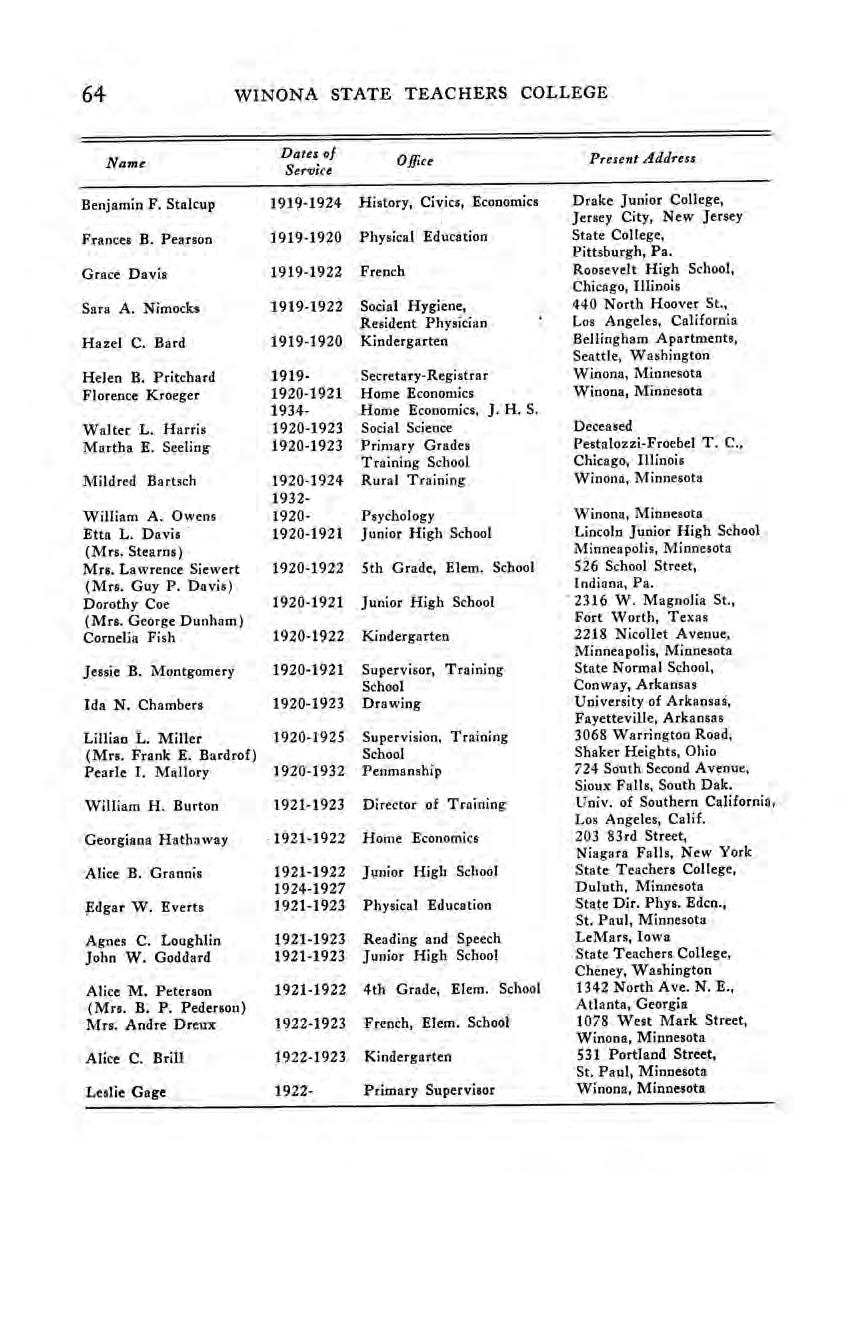
Drake Junior College, Jersey City, New Jersey
1919-1920 Physical Education State College, Pittsburgh, Pa.
Grace Davis 1919-1922 French Roosevelt High School, Chicago, [Illinois
Sara A. Nimocks
1919-1922 Social Hygiene, 440 North Hoover St., Resident Physician Los Angeles, California
Hazel C. Bard 1919-1920 Kindergarten Bellingham Apartments, Seattle, Washington
Helen B. Pritchard 1919- Secretary-Registrar
Florence Kroeger 1920-1921 Home Economics
Walter L. Harris
Winona, Minnesota
Winona, Minnesota 1934- Home Economics, J. H. S.
1920-1923 Social Science
Deceased
Martha E. Seeling 1920-1923 Primary Grades Pestalozzi-Froebel T. C., Training School Chicago, Illinois
Mildred Bartsch
1920-1924 Rural Training
Winona, Minnesota 1932-
William A. Owens 1920- Psychology
Winona, Minnesota
Etta L. Davis 1920-1921 Junior High School Lincoln Junior High School (Mrs. Stearns) Minneapolis, Minnesota
Mrs. Lawrence Siewert
1920-1922 5th Grade, Elem. School 526 School Street, (Mrs. Guy P. Davis) Indiana, Pa.
Dorothy Coe
1920-1921 Junior High School ‘2316 W. Magnolia St., (Mrs. George Dunham) Fort Worth, Texas
Cornelia Fish
Jessie B. Montgomery
1920-1922 Kindergarten 2218 Nicollet Avenue, Minneapolis, Minnesota
1920-1921 Supervisor, Training State Normal School, School Conway, Arkansas
Ida N. Chambers 1920-1923 Drawing University of Arkansas, Fayetteville, Arkansas
Lillian L. Miller
1920-1925 Supervision, Training 3068 Warrington Road, (Mrs, Frank E. Bardrof) School Shaker Heights, Ohio
Pearle I. Mallory 1920-1932 Penmanship 724 South Second Avenue, Sioux Falls, South Dak.
William H. Burton
Georgiana Hathaway -
Alice B. Grannis
Edgar W. Everts
Agnes C. Loughlin
1921-1923 Director of Training Univ. of Southern California, Los Angeles, Calif.
1921-1922 Home Economics 203 83rd Street, Niagara Falls, New York
1921-1922 Junior High School State Teachers College, 1924-1927 Duluth, Minnesota
1921-1923 Physical Education State Dir. Phys. Edcn., St. Paul, Minnesota
1921-1923 Reading and Speech LeMars, Iowa
John W. Goddard 1921-1923 Junior High School State Teachers College, Cheney, Washington
Alice M. Peterson
1921-1922 4th Grade, Elem. School 1342 North Ave. N. E., (Mrs. B. P. Pederson) Atlanta, Georgia
Mrs. Andre Dreux
Alice C. Brill
Leslie Gage
1922-1923 French, Elem. School 1078 West Mark Street, Winona, Minnesota
1922-1923 Kindergarten 531 Portland Street, St. Paul, Minnesota
1922- Primary Supervisor Winona, Minnesota
Name nates of O ffice
Ethel Lee Parker
Dorothy W. Waterman
Bernice E. Leary
Naomi Wetzel
Katherine E. Kennedy

Present Address ervice
1922-1924 Home Economics
1922-1923 Physical Education
University of Kentucky, Lexington, Kentucky
Address Unknown
1922-1923 Junior High School c/o University of Chicago, Chicago, Illinois
1922-1925 4th Grade, Elem. School
Bronxville Elem. School, Bronxville, New York
1922-1924 5th Grade, Elem. School 1930 Woodburn Street, Whitefish Bay, Wis.
Etta O. Christensen 1922- Rural Education Winona, Minnesota
Hazel Irene Aldrich 1922-1923 Supervisor, Elem. School 317 South Drive,
(Mrs. E. P. Finegan)
Mary McKay
Elberta Broadwell
(Mrs. Charles Davidson)
A. Adalyne Artz
Beverly Hills, Cal.
1922-1923 Music 2238 Sherman Avenue, Evanston, Illinois
1922-1923 Music, Training School Scranton, Pa.
1922-1927 Resident Nurse
Red Oak, Iowa
Mrs. T. M. Cassidy 1923-1930 Drawing Huron, South Dakota
Cyrus F. Jennings 1923-1926 Assistant in Manual 1603 Lake Street, Arts Evanston, Illinois
Angela L. Mensing 1923-1925 Kindergarten 1308 Anderson Street, New Orleans, La.
Erwin S. Selle
1923- Sociology and Government Winona, Minnesota
Martha E. Lewis 1923-1927 Physical Education Wisconsin Gen. Hospital Madison, Wisconsin
Cecile Evans
Fern Andrews Olson
Ruth Strickland
Arnold M. Christensen
Charles L. Simmers
Beulah Brunner
1923-1924 Assistant Librarian
Address Unknown
1923-1925 Music, Training School Underhill Road, Scarsdale, New York
1923-1924 Primary Grades State Normal School, Training School Bellingham, Washington
1923-1926 Junior High School State Teachers College, Moorhead, Minnesota
1923- Director of Training Winona, Minnesota
1923- Supervisor, Tr. School Winona, Minnesota
Walter Grimm 1923- Music Winona, Minnesota
Lester K. Kirk
Susan B. Davis
Ray E. Haberman
Mrs. Charles L. Simmers
Grace Durrin
Genevieve Holcomb
1923-1924 Junior High School Detroit University, Detroit, Michigan
1923-1925 Reading and Speech University of Wisconsin, Madison, Wisconsin
1923-1927 Physical Education 645 Northwestern Bk. Bldg., Minneapolis, Minnesota
1923-1927 English 373 West King Street, Winona, Minnesota
1923-1924 English 130 Troupe Avenue, Bowling Green, Ohio
1923-1924 Physical Education
Address Unknown
Janet Conklin 1924-1925 Physical Education Sioux Falls, S. D.
(Mrs. James Dalton)
O. Harry Gibson
Adah E. Minard
Vannita L. Wesely
1924-1925 History and Government Junior College, Eveleth, Minnesota
1924-1927 Primary Grades, Training 141 Sixth Street N. E., School Watertown, S. D.
1924-1927 Assistant Librarian 132 South Seventh St., Gainsville, Florida
Name Dates of O fice
Maria C. Ingberg

Present Address Service
1924-1929 5th and 6th Grades, Y. W.C.A.,, Training School Akron, Ohio
Lucille E. Moritz 1924-1926 Home Economics
(Mrs. J. C. Sullivan)
J. Lawrence Eason 1924-1925 English
Address Unknown
Stantonsburg, N. C.
Elizabeth Colwell 1925-1926 Music, Training School 2873 Holmes Street S., (Mrs. Floyd Nielson) Minneapolis, Minn.
Muriel R. Meyer 1925-1929 Piano Fargo, North Dakota (Mrs. L. Nancarrow)
Marguerite Stanton 1925-1926 Primary Grades, Phelps Austin, Minnesota
Jean Talbot 1925- Physical Education Winona, Minnesota
Ruth Beth Watts 1925-1932 Reading and Speech 22 Fairview Avenue, Dover, New Jersey
Natalie T. Huhn 1925-1927 Librarian Public Library, Oshkosh, Wisconsin
Marion L. Hagler 1925-1927 Kindergarten 18405 Winslow Road, (Mrs, Erwin Anderson) Shaker Heights, Ohio
Maude A. Kavanagh 1925-1929 Intermediate Supervisor Whittier College, Whittier, California
Frederick A. Jederman 1925- History, Dean of Men Winona, Minnesota
Mrs. F. A. Jederman
1925-1926 Intermediate Grades Winona, Minnesota
Abbie B. Langmaid 1925-1929 Visiting Teacher Granite Falls, Minn.
Edna J. Barnes
Mildred L. Engstrom
Bernice Bryan
Claire E. Harris
Glenn E. Fishbaugher
1925-1928 Intermediate Grades State Teachers College, Bloomsburg, Pa.
1926- Librarian Winona, Minnesota
1926-1929 Primary Grades 1230 Amsterdam Avenue, New York City
1926-1927 Intermediate Grades 3325 45th Avenue South, Minneapolis, Minn.
1926- Phelps Jr. H. S. Winona, Minnesota
Mary Frances Gregg 1926-1928 Music, Phelps School Mt. Pleasant, Iowa
Willis E. Boots
1926- English and Psychology Winona, Minnesota
Roland M. Torgerson 1926- Industrial Education Winona, Minnesota
Herbert W. Hess 1926-1927 Sociology and Government Junior College, Duluth, Minnesota
Mrs. Edwin J. Dahl
Florence McKinley
1926-1927 Home Economics Address Unknown
1927-1931 Physical Education Bakersfield, Cal.
Glendon E. Galligan 1927-1934 Physical Education Winona, Minnesota 1935-
Cora Ebert
1927-1929 Junior High School T. C., Columbia Univer., New York City
Louise Strohbehn 1927-1931 Primary Grades 803 Marquette, (Mrs. H. Goldschmidt) Davenport, Iowa
Phila Humphreys 1927-1929 Intermediate Grades 579 Swain, Elmhurst, Illinois
Margaret Clark
Evelyn Ellingson
Theodora Densmore
Merle S. Adams
1927-1929 Librarian Library, Miami Univ., Oxford, Ohio
1927-1929 Resident Nurse c/o Dept. Public Health, Clarksville, Tenn.
1927-1929 Associate, Kindergarten 718 Clary Street, Beloit, Wisconsin
1928-1929 Music, Phelps 3213 Minnehaha Avenue, Minneapolis, Minn.
Helen M. Coleman
Evelyn Semling

1928-1932 French
319 West 75th St., New York City
1929- Assistant, Kindergarten Winona, Minnesota
Valeta Jeffrey 1929- Music, Phelps Winona, Minnesota
Grace M. Muir
1929-1934 Junior High School Savoy Plaza, (Mrs. Joseph Watkins) New York City
Erna R. Stech
Fra Samuels
Martha Dallman
1929-1930 Assistant Librarian
1929-1930 Primary Grades
Address Unknown
Address Unknown
1929- Intermediate Grades Winona, Minnesota
Cathryn Cramer 1929- Intermediate Grades Winona, Minnesota
Clara Stroud 1929-1930 Intermediate Grades Pasco, Washington
Florence Rasmussen
1929-1930 Piano 2511 .VanLeuman Ave., Cheney, Wyoming
Dorothy Clark 1929- Fine Art Winona, Minnesota
Viola M. Beery
1930-1934 Domestic Science, J. H. S. Portage, Michigan
Alice E. Washburn 1930-1931 Primary Grades
Ella C. Clark
Address Unknown
1930- Intermed. Supervisor Winona, Minnesota
Minnie Zimmerman 1930- Assistant Librarian Winona, Minnesota
Grace A. Selleck 1930-1931 Primary Grades 365 West Sanborn St., 1932-1933 Rural Education Winona, Minnesota
Margaret B. Miller 1930- College Nurse Winona, Minnesota
Mrs. Inez Mattison 1930-1932 Gen. Science and Chemistry Winona, Minnesota
Jeanne S. Brouillette 1931- Primary Grades Winona, Minnesota
Helen A. Pendergast 1931- Physical Education Winona, Minnesota
Laura Opal Foster 1931- Primary Grades Winona, Minnesota
Janet R. Rohweder 1931- Voice Winona, Minnesota
Walter Rupp
Jean Brady Jones
1931-1932 Industrial Arts Mountain Lake, Minn.
1932- Reading and Speech Winona, Minnesota
Nels Minne 1932- Chemistry and Physics Winona, Minnesota
Roy B. Tozier
1932- Sec. Eden. and Soc. Science Winona, Minnesota
Stanley J. Pawelek 1932- Industrial Education Winona, Minnesota
Marion F. Davis 1932- French Winona, Minnesota
Floretta Murray 1932- Art, Phelps School Winona, Minnesota
Edna Justman
1932-1933 Piano Henning, Minnesota
Agnes Bard 1933- Piano Winona, Minnesota
Ella Murphy 1934- English Winona, Minnesota
Earl B. Greene 1934- Physical Education Winona, Minnesota
Jennie Lorenz 1934- Reading and Speech New York City
Maurine Scovell 1935- Junior High School Winona, Minnesota
Summer Term Only
Name re of O
J. V. Voorhees

Present Address ervice
1910-1916 Algebra and Geometry
Ella Beyerstedt 1911 Drawing
State Teachers College, Duluth, Minnesota
204 East Wabasha St., Winona, Minnesota
F, V. Churchill 1911 Manual Training Deceased
D. H. Holbrook 1911 History and Civics
G. C. Stockton
Theodore Wanerus
Margaret McAdam
Frances R. Fletcher
Charlotte J. Pettis
H. R. Leonard
A. H. Bernhard
Marian Kassing
Margaret Bieri
Alberta Ackerman
Elizabeth Falls
Karl Holzinger
Ray LeMay
Marian J. Wesley
W. P. Shortridge
Ora K. Smith
Minnie Howell
Sara Brammer
Charles Walter
LeRoy Arnold
Clara Turner
Nellie Feetham
Evelyn Edbloom
Etta Anchester
History and Civics Teacher in Elem. School Teacher in Elem. School Assistant in Geography Agriculture Physics
Sewing and Drawing Rural Education
Rural Education Teacher, Elem. School Mathematics Manual Training Teacher, Elem. School History
Rural School Methods Education Methods Geography Literature
Home Economics
Edcn, of Excep. Children Edcn. of Exc. Chn. Critic
Prim, Hdwk. and Reading
Address Unknown
Address Unknown
Gillette, Wyoming
Blooming Prairie, Minn. Deceased
Address Unknown
Address Unknown
State Teachers College, LaCrosse, Wisconsin
Menominee, Wisconsin
State Teachers College, Moorhead, Minnesota Northfield, Minnesota
State Teachers College, San Marcos, Texas University of Chicago, Chicago, I]linois 403 Choate Building, Winona, Minnesota
Address Unknown
West Va. University, Morgantown, W. Va.
Address Unknown 1484 Elm Avenue, Long Beach, Cal. 562 West Broadway, Winona, Minnesota 7108 22nd Avenue, Kenosha, Wisconsin Hamline University, St. Paul, Minnesota
Address Unknown Duluth, Minnesota 3442 10th Ave. S., Minneapolis, Minn. Public Schools, Philadelphia, Pa.
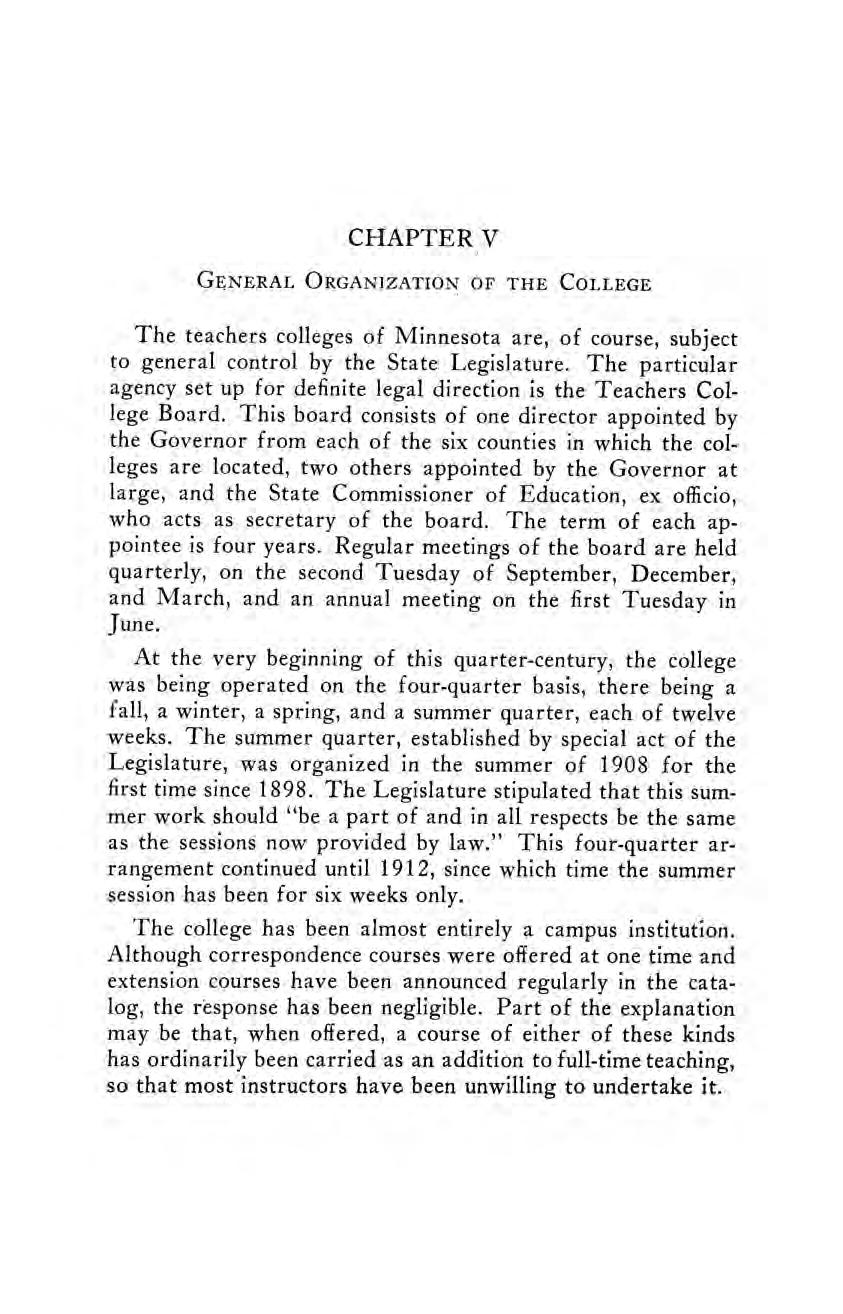
The teachers colleges of Minnesota are, of course, subject to general control by the State Legislature. The particular agency set up for definite legal direction is the Teachers College Board. This board consists of one director appointed by the Governor from each of the six counties in which the colleges are located, two others appointed by the Governor at large, and the State Commissioner of Education, ex officio, who acts as secretary of the board. The term of each appointee is four years. Regular meetings of the board are held quarterly, on the second Tuesday of September, December, and March, and an annual meeting on the first Tuesday in June.
At the very beginning of this quarter-century, the college was being operated on the four-quarter basis, there being a fall, a winter, a spring, and a summer quarter, each of twelve weeks. The summer quarter, established by special act of the Legislature, was organized in the summer of 1908 for the first time since 1898. The Legislature stipulated that this summer work should “be a part of and in all respects be the same as the sessions now provided by law.” This four-quarter arrangement continued until 1912, since which time the summer session has been for six weeks only.
The college has been almost entirely a campus institution. Although correspondence courses were offered at one time and extension courses have been announced regularly in the catalog, the response has been negligible. Part of the explanation may be that, when offered, a course of either of these kinds has ordinarily been carried as an addition to full-time teaching, so that most instructors have been unwilling to undertake it.
The resident director. of the Winona State Teachers College for almost the entire quarter-century of our interest was Mr. S. H. Somsen. He was first appointed in 1909 and reappointed quadrennially until 1933, when he resigned, having completed almost twenty-five years of service. During this period, Mr. Somsen was in attendance at all but five of the more than 140 meetings held by the board. He was actively interested in all the work of the board and served for many years as the chairman of the legislative committee. For the last three years of his tenure he was president of the board.
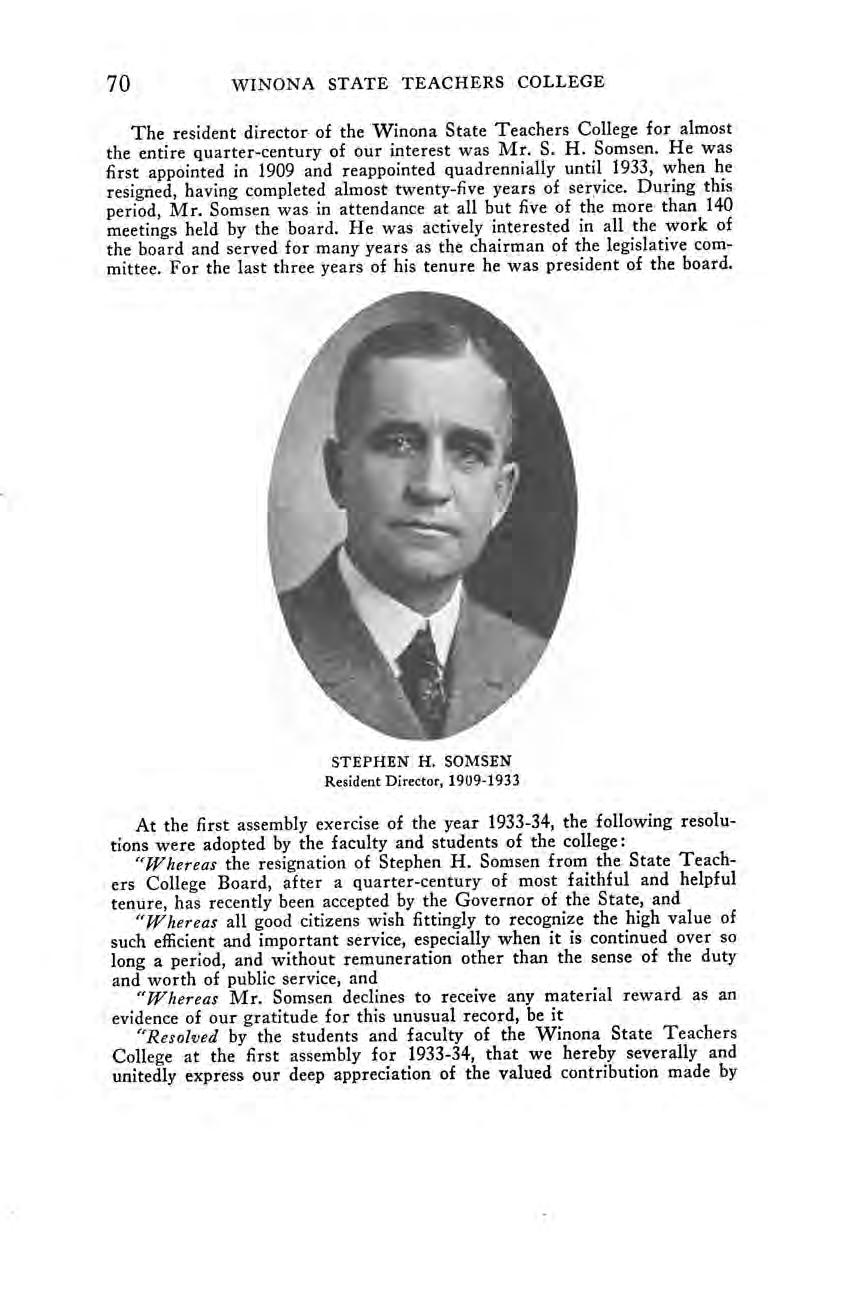
STEPHEN H. SOMSEN Resident Director, 1909-1933
At the first assembly exercise of the year 1933-34, the following resolutions were adopted by the faculty and students of the college:
“Whereas the resignation of Stephen H. Somsen from the State Teachers College Board, after a quarter-century of most faithful and helpful tenure, has recently been accepted by the Governor of the State, and
“Whereas all good citizens wish fittingly to recognize the high value of such efficient and important service, especially when it is continued over so long a period, and without remuneration other than the sense of the duty and worth of public service, and
“Whereas Mr. Somsen declines to receive any material reward as an evidence of our gratitude for this unusual record, be it
“Resolved by the students and faculty of the Winona State Teachers College at the first assembly for 1933-34, that we hereby severally and unitedly express our deep appreciation of the valued contribution made by
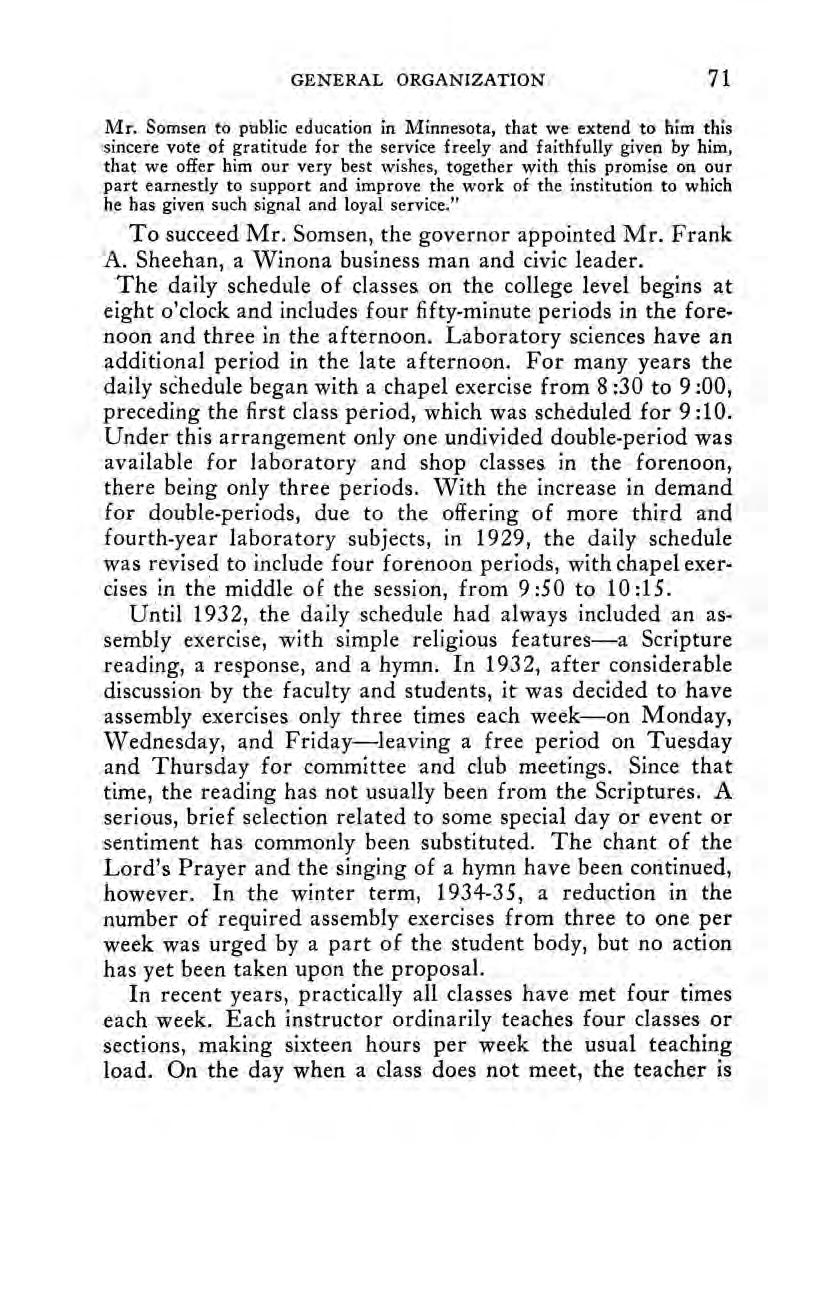
Mr. Somsen to public education in Minnesota, that we extend to him this sincere vote of gratitude for the service freely and faithfully given by him,that we offer him our very best wishes, together with this promise on our part earnestly to support and improve the work of the institution to which he has given such signal and loyal service.”
To succeed Mr. Somsen, the governor appointed Mr. Frank A. Sheehan, a Winona business man and civic leader.
The daily schedule of classes on the college level begins at eight o’clock and includes four fifty-minute periods in the forenoon and three in the afternoon. Laboratory sciences have an additional period in the late afternoon. For many years the daily schedule began with a chapel exercise from 8 :30 to 9:00, preceding the first class period, which was scheduled for 9:10. Under this arrangement only one undivided double-period was available for laboratory and shop classes in the forenoon, there being only three periods. With the increase in demand for double-periods, due to the offering of more third and fourth-year laboratory subjects, in 1929, the daily schedule was revised to include four forenoon periods, with chapel exercises in the middle of the session, from 9:50 to 10:15.
Until 1932, the daily schedule had always included an assembly exercise, with simple religious features—a Scripture reading, a response, and a hymn. In 1932, after considerable discussion by the faculty and students, it was decided to have assembly exercises only three times each week—on Monday, Wednesday, and Friday—leaving a free period on Tuesday and Thursday for committee and club meetings. Since that time, the reading has not usually been from the Scriptures. A serious, brief selection related to some special day or event or sentiment has commonly been substituted. The chant of the Lord’s Prayer and the singing of a hymn have been continued, however. In the winter term, 1934-35, a reduction in the number of required assembly exercises from three to one per week was urged by a part of the student body, but no action has yet been taken upon the proposal.
In recent years, practically all classes have met four times each week. Each instructor ordinarily teaches four classes or sections, making sixteen hours per week the usual teaching load. On the day whena class does not meet, the teacher is

expected to be available for conferences with individual members or with the class as a whole.
For a time after the fire of 1922, which destroyed all textbooks, the college, contrary to the former plan, sold books to students without profit. However, in order to reduce the cost of attendance, the rental system was soon re-established, and has continued until the present. Provision is made for frequent change of texts in fields where this is of importance. A faculty committee exercises general supervision over the textbook rental library.
High school graduation hasbeen required for admission to the school since September, 1918. No student who applies for admission is excluded because of low scholastic standing in high school, but those whose records place them in the lowest quarter of their graduating class are advised not to enroll.
The general policy of the Teachers College Board has been to maintain uniformity in such matters as the curriculums, the standards for admission, and the standards for graduation. Usually, whatever any one of the six Minnesota teacherscolleges is authorized to do, the other five may do. This is an obvious accommodation to a certain degree of friendly rivalry among the colleges, and perhaps to the potential conflict among the various regions served by the colleges.
Affiliation of the Minnesota colleges with organizations outside Minnesota has raised some interesting issues. This is one matter in which uniformity on the part of the six schools has not always been required. Winona became a member of the North Central Association of Colleges and Secondary Schools in 1913, the first year that an accredited list of schools was published, and was a member continuously until 1930 except for one brief lapse, 1914 to 1916. Two other Minnesota teachers colleges joined this organization in 1915 and 1916 respectively and continued in this relationship until 1930, with only a two-year lapse. At that time, 1930, the association made certain changes in the requirements for teacher-training institutions, virtually placing them on the same basis as liberal
arts colleges. The three Minnesota member colleges withdrew, and persisted in their withdrawal, with the approval of the Teachers College Board, even though the association voted not to apply the new rules until 1933. “It seemed better to our Board,” President G. E. Maxwell wrote to an officer of the accrediting organization under date of April 10, 1930, “to ask to be withdrawn from the teacher-training list of the North Central Association primarily because of local con-

FRANK A. SHEEHAN Resident Director,
1933-
ditions within our legislature. Last winter when we sought a rating in teacher certification equivalent to that of the University and the arts colleges of the state, we made it very clear to the legislature that we were not and that we are not ambitious to become arts colleges. We believe that to re-enter or even to continue inthe North Central Association might be misinterpreted at the next session and tend to limit the amount of the appropriations which we shall need to carry out our enlarged program of professional training. .”
Mr. J. M. McConnell, State Commissioner of Education and an ex officio member of the Teachers College Board, pro-

tested vigorously against a relationship which would place an outside, private accrediting agency in a position to dictate to a state in the setting up of standards.
Since 1930, the question of a renewal of the affiliation has received occasional attention, but no formal steps have been taken either by the colleges or by the association. If the membership is renewed, the usual rule as to uniformity of procedure will apparently be applied by the board, that is, none of the colleges being permitted to enter until all are ready.
Another important, long-continued contact has been that with the American Association of Teachers Colleges and organizations of its kind preceding it. The first of these was an association of administrative officers rather than of institutions. It was regional, as shown by its name: The North Central Council of State Normal Presidents. This organization came into existence in 1902 and continued until 1917 when it was reorganized as the National Council of Normal School Presidents and Principals. In 1923, this group merged with the American Association of Teachers Colleges, the combined organizations taking the latter name.
The Winona college has kept in close contact with these various organizations and has kept abreast of their standards. A prominent part has been taken in each of them by President G. E. Maxwell, who held the office of president in the first one in 1909 and in the second one in 1923; and the office of acting president in 1924 and that of president in 1925 of the newly combined group known as the American Association of Teachers Colleges.
This organization has become an active accrediting agency in the teacher-training field. It has regularly accorded a Class A rating to the Winona college.
The first step toward formal cooperation between students and faculty in school government appears to have been taken in the spring of 1911, and was reported by the president to the Normal School Board in the following November. It was stated that after discussion each student and teacher had made
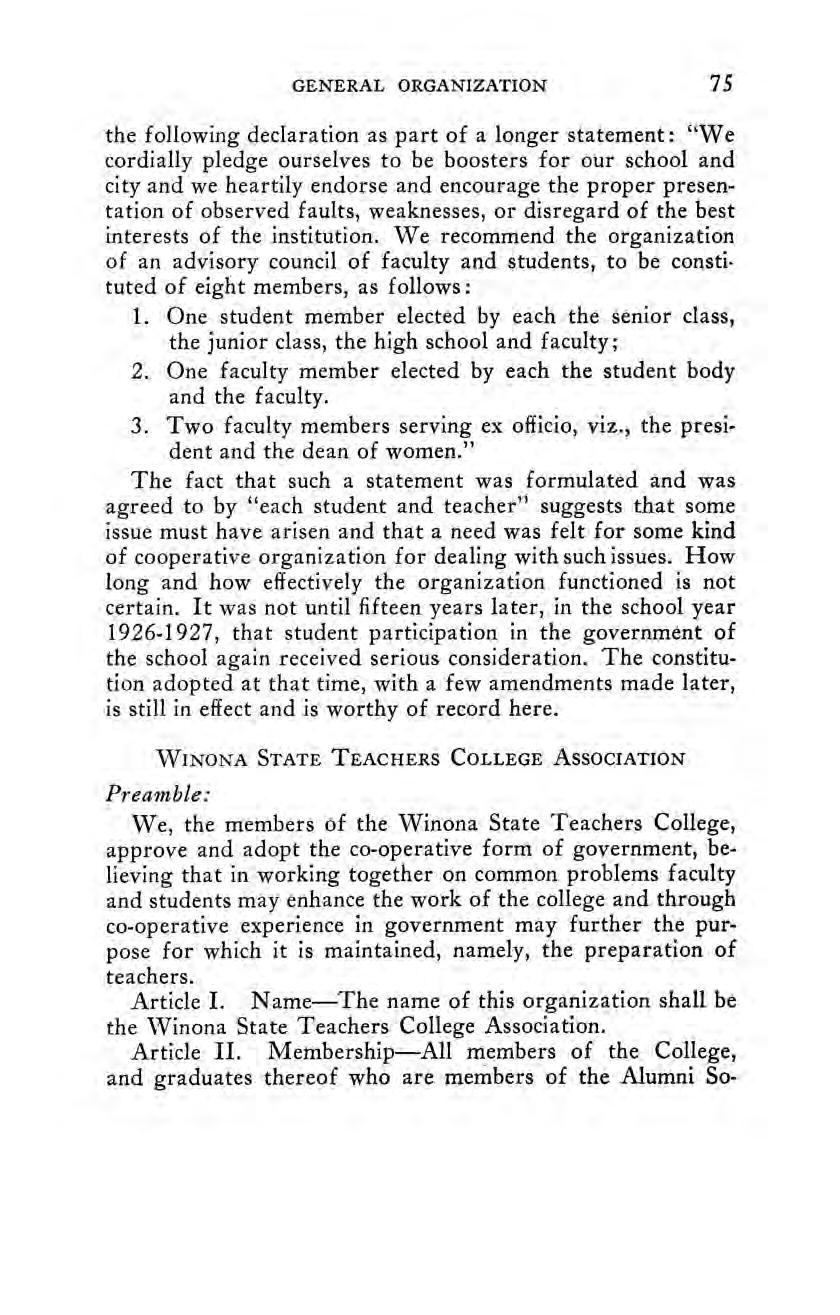
the following declaration as part of a longer statement: ‘We cordially pledge ourselves to be boosters for our schooland city and we heartily endorse and encourage the proper presentation of observed faults, weaknesses, or disregard of the best interests of the institution. We recommendthe organization of an advisory council of faculty and students, to be constituted of eight members, as follows:
1. One student member elected by each the senior class, the junior class, the high school and faculty;
2. One faculty member elected by each the student body and the faculty.
3. Two faculty members serving ex officio, viz., the president and the dean of women.”
The fact that such a statement was formulated and was agreed to by ‘‘each student and teacher” suggests that some issue must have arisenand that a need was felt for some kind of cooperative organization for dealing with such issues. How long and how effectively the organization functioned is not certain. It was not until fifteen years later, in the school year 1926-1927, that student participation in the government of the school again received serious consideration. The constitution adopted at that time, with a few amendments made later, is still in effectand is worthy of record here.
Preamble:
We, the members of the Winona State Teachers College, approve and adopt the co-operative form of government, believing that in working together on common problems faculty and students may enhance the work of the college and through co-operative experience in government may further the purpose for which it is maintained, namely, the preparation of teachers.
Article I. Name—The name of this organization shall be the Winona State Teachers College Association.
Article IJ. Membership—All members of the College, and graduates thereof who are members of the Alumni So-
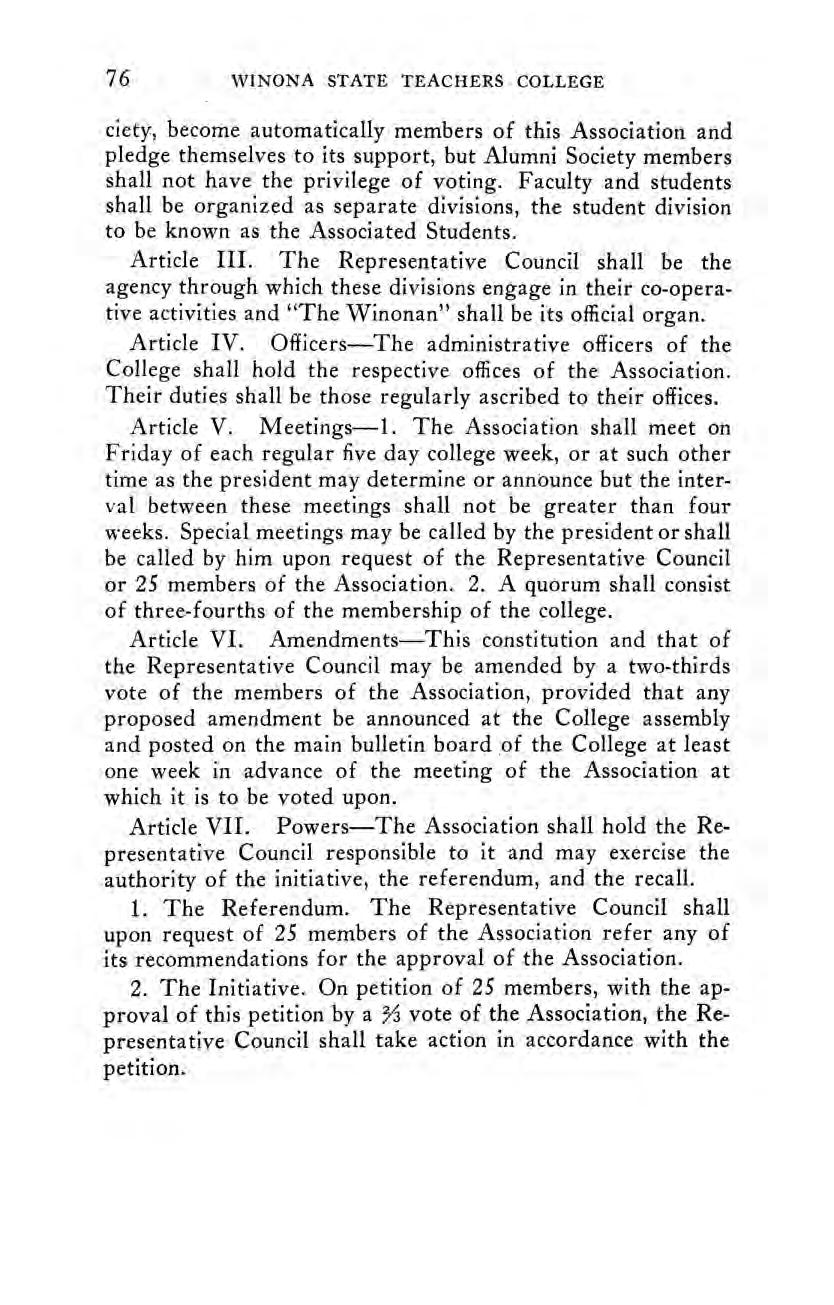
ciety, become automatically members of this Association and pledge themselves to its support, but Alumni Society members shall not have the privilege of voting. Faculty and students shall be organized as separate divisions, the student division to be known as the Associated Students.
Article III. The Representative Council shall be the agency through which these divisions engage in their co-operative activities and “The Winonan” shall be its official organ.
Article IV. Officers—The administrative officers of the College shall hold the respective offices of the Association. Their duties shall be those regularly ascribed to their offices.
Article V. Meetings—i. The Association shall meet on Friday of each regular five day college week, or at such other time as the president may determine or announce but the interval between these meetings shall not be greater than four weeks. Special meetings may be called by the president or shall be called by him upon request of the Representative Council or 25 members of the Association. 2. A quorum shall consist of three-fourths of the membership of the college.
Article VI. Amendments—This constitution and that of the Representative Council may be amended by a two-thirds vote of the members of the Association, provided that any proposed amendment be announced at the College assembly and posted on the main bulletin board of the College at least one week in advance of the meeting of the Association at which it is to be voted upon.
Article VII. Powers—The Association shall hold the Representative Council responsible to it and may exercise the authority of the initiative, the referendum, and the recall.
1. The Referendum. The Representative Council shall upon request of 25 members of the Association refer any of its recommendations for the approval of the Association.
2. The Initiative. On petition of 25 members, with the approval of this petition by a % vote of the Association, the Representative Council shall take action in accordance with the petition.

3. The Recall. Upon petition of 50 members, the Association may remove from office by a % vote any student member of the Representative Council, any officer of the Associated Students, or any student member of a college committee.
4. The Association shall be a medium for the expression of college opinion.
5. The Association shall elect student members of the joint committees from those nominated by the Representative Council.
Article I. Name—The name of this organization shall be the Representative Council of the Winona State Teachers College.
Article II. The-Representative Council shall be the agency through which the Association engages in its co-operative activities and shall assume responsible oversight of various activities undertaken jointly by faculty and students.
Article III. Membership—1. This Council shall consist of 12 members as follows:
a. The Dean of Men and the Dean of Women, ex officio.
b. Three faculty members elected annually by the faculty.
c. Two representatives, a man and a woman, elected by and from each of the three upper classes, one of these two being the class president.
d. The president of the freshman class, after the close of the fall quarter.
2. The members of the Councilshall continue in office until the first meeting after their successors are elected, at which meeting such successors shall take office.
3. The President of the College may sit with the Council and shall have the privilege of discussion.
Article IV. Officers—1. The officers of the Council shall be, President, Vice President, and Secretary. These officers shall be ex officio president, vice-president, and secretary respectively of the Associated Students.
2. The Councilshall elect its officers from the student members thereof,
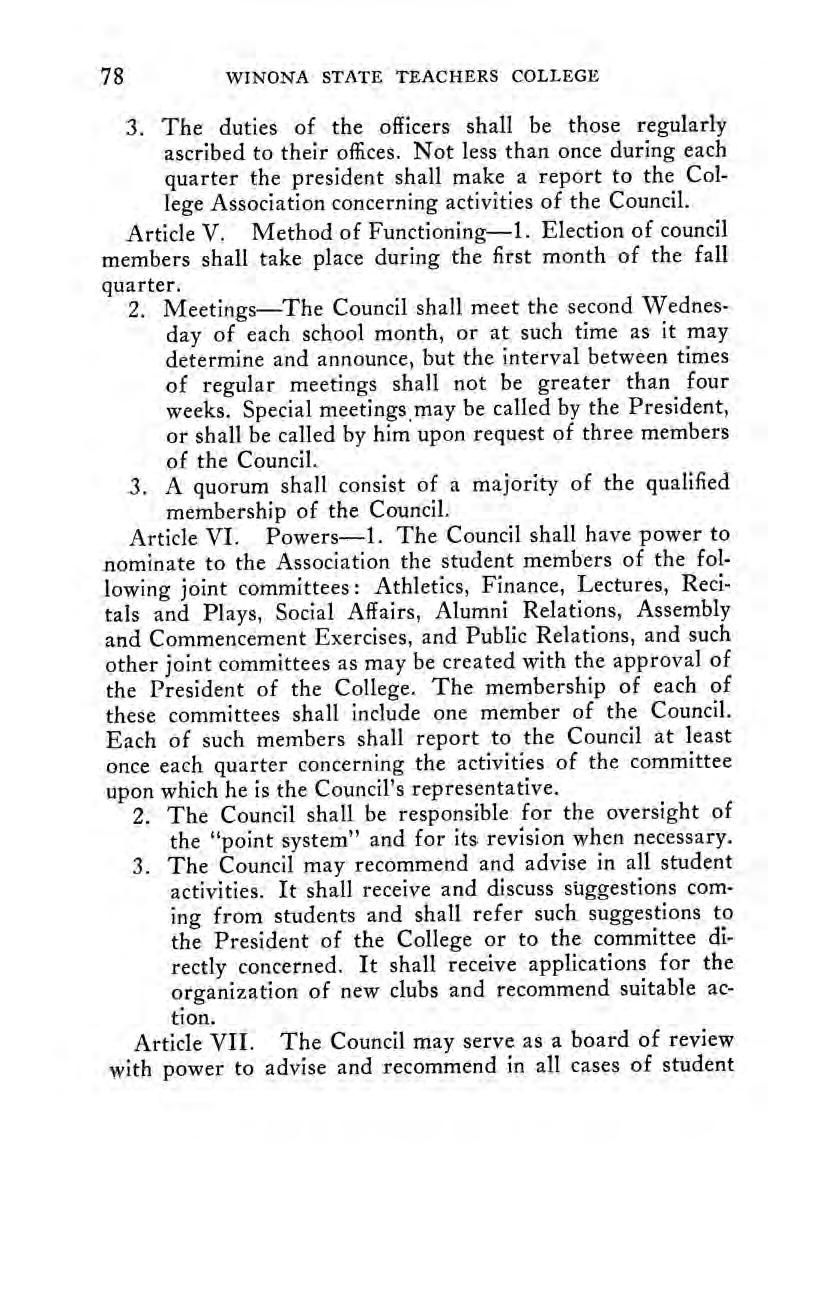
3. The duties of the officers shall be those regularly ascribed to their offices. Not less than once during each quarter the president shall make a report to the College Association concerning activities of the Council.
Article V. Method of Functioning—1. Election of council members shall take place during the first month of the fall quarter.
2. Meetings—The Council shall meet the second Wednesday of each school month, or at such time as it may determine and announce, but the interval between times of regular meetings shall not be greater than four weeks. Special meetings may be called by the President, or shall be called by him upon request of three members of the Council.
3. A quorum shall consist of a majority of the qualified membership of the Council.
Article VI. Powers—1. The Council shall have power to nominate to the Association the student members of the following joint committees: Athletics, Finance, Lectures, Recitals and Plays, Social Affairs, Alumni Relations, Assembly and Commencement Exercises, and Public Relations, and such other joint committees as may be created with the approval of the President of the College. The membership of each of these committees shall include one member of the Council. Each of such members shall report to the Council at least once each quarter concerning the activities of the committee upon which he is the Council’s representative.
2, The Council shall be responsible for the oversight of
3. the “point system” and for its revision when necessary. The Council may recommend and advise in all student activities. It shall receive and discuss stiggestions coming from students and shall refer such suggestions to the President of the College or to the committee directly concerned. It shall receive applications for the organization of new clubs and recommend suitable action.
Article VII. The Council may serve as a board of review with power to advise and recommend in all cases of student

affairs brought to it by a member or members of the Association and shall serve as such in all cases brought to it by a member or members of the Association in which a student’s or students’ enrollment or retention in the College is involved.
Another important field in which there is definite studentfaculty cooperation is in committee activity. In all aspects of college life in which student advice and direction appear appropriate and valuable, provision is made for student repre+ sentation on standing committees. The list of joint committees is to be found in chapter four, The Professional Staff.
In addition to close cooperative relationships between teachers and students as groups, a much more personal relationship is provided in the adviser system, begun in 1928. Each student chooses, or has assigned to him, a faculty adviser. This relationship makes it possible for the student to receive information and guidance about his own educational and sometimes his personal problems from someone who is older and certainly more experienced in matters involved in the student’s relationships in the college. The fact of having one official adviser does not mean that a student cannot seek advice from others, nor does the fact that a teacher’s list of ‘‘advisees” contains only certain students relieve him of any obligation or inclination to be of help to other students. The system does insure that each student knows of a definite, simple procedure by which he may get advice and help if he needs it.
Cooperation of faculty and students is found in the “term ticket” arrangement administered by the joint committee on finance. At the beginning of each term each member of the school purchases a ticket which admits him to all entertainments, parties, athletic games, and debates, gives him a subscription to The Winonan, the school paper, and entitles him to a certain amount of nursing and medical service.
The testing movement at Winona was launched in the fall of 1919 by the giving of the Army Alpha test to the entire college. In the summer of 1921 a course in educational meas-

Seated, left to right: Director I. N. Tompkins, Director E. J. Jones, Commissioner J. M. McConnell. and Director S. H. Somsen.
Standing left to right: Director C. D. Schwab, President J. C. Brown, President C. H. Cooper, President R. B. MacLean, Director A. P. White, Director O. E. Safford, Director H. C. Strong, President M. W. Deputy, Director O. J. Hagen, President E. W. Bohannon, and President G. E. Maxwell.
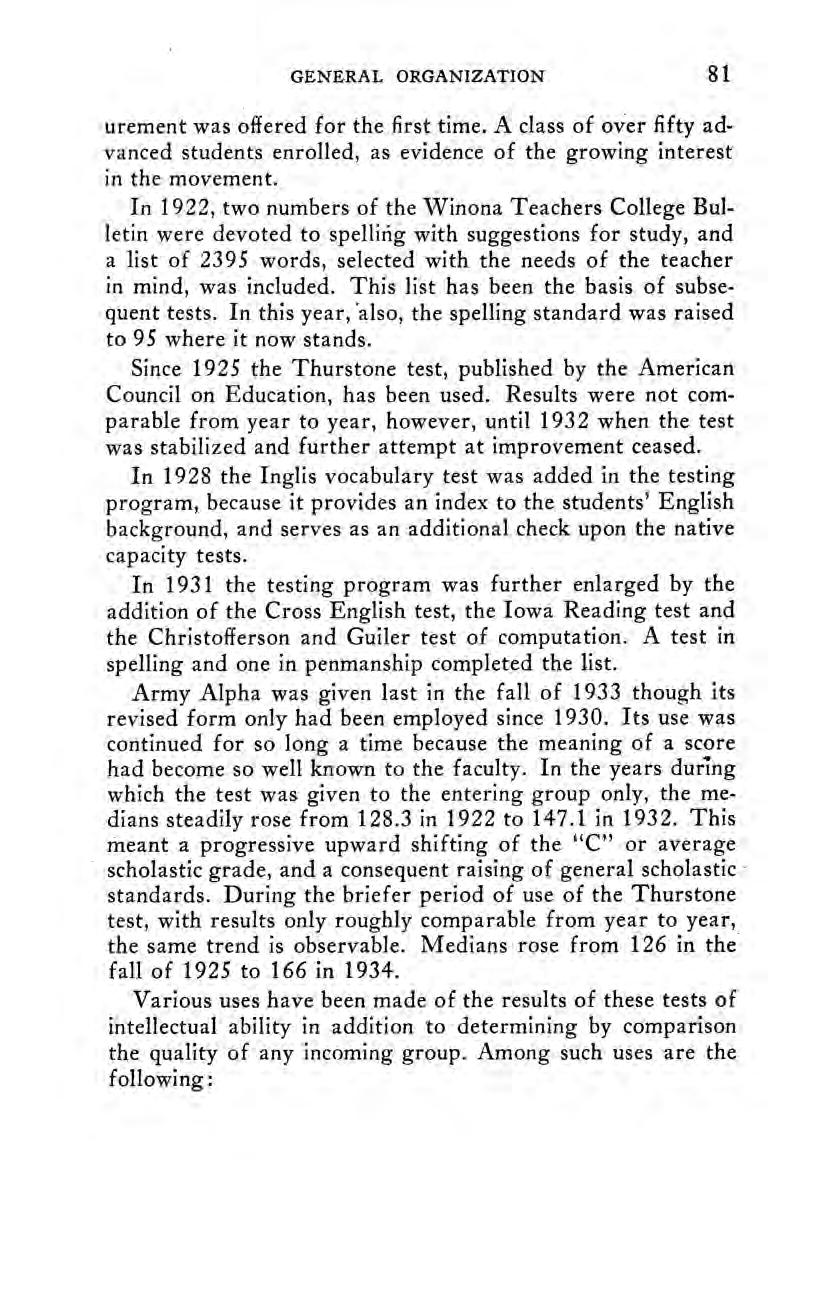
urement was offered for the first time. A class of over fifty advanced students enrolled, as evidence of the growing interest in the movement.
In 1922, two numbers of the Winona Teachers College Bulletin were devoted to spelling with suggestions for study, and a list of 2395 words, selected with the needs of the teacher in mind, was included. This list has been the basis of subsequent tests. In this year, also, the spelling standard was raised to 95 where it now stands.
Since 1925 the Thurstone test, published by the American Council on Education, has been used. Results were not comparable from year to year, however, until 1932 when the test was stabilized and further attempt at improvement ceased.
In 1928 the Inglis vocabulary test was added in the testing program, because it provides an index to thestudents’ English background, and serves as an additional check upon the native capacity tests.
In 1931 the testing program was further enlarged by the addition of the Cross English test, the Iowa Reading test and the Christofferson and Guiler test of computation. A test in spelling and one in penmanship completed the list.
Army Alpha was given last in the fall of 1933 though its revised form only had been employed since 1930. Its use was continued for so long a time because the meaning of a score had become so well known to the faculty. In the years during which the test was given to the entering group only, the medians steadily rose from 128.3 in 1922 to 147.1 in 1932. This meant a progressive upward shifting of the “‘C” or average scholastic grade, and a consequent raising of general scholasticstandards. During the briefer period of use of the Thurstone test, with results only roughly comparable from year to year, the same trend is observable. Medians rose from 126 in the fall of 1925 to 166 in 1934.
Various uses have been made of the results of these tests of intellectual ability in addition to determining by comparison the quality of any incoming group. Among such uses are the following:
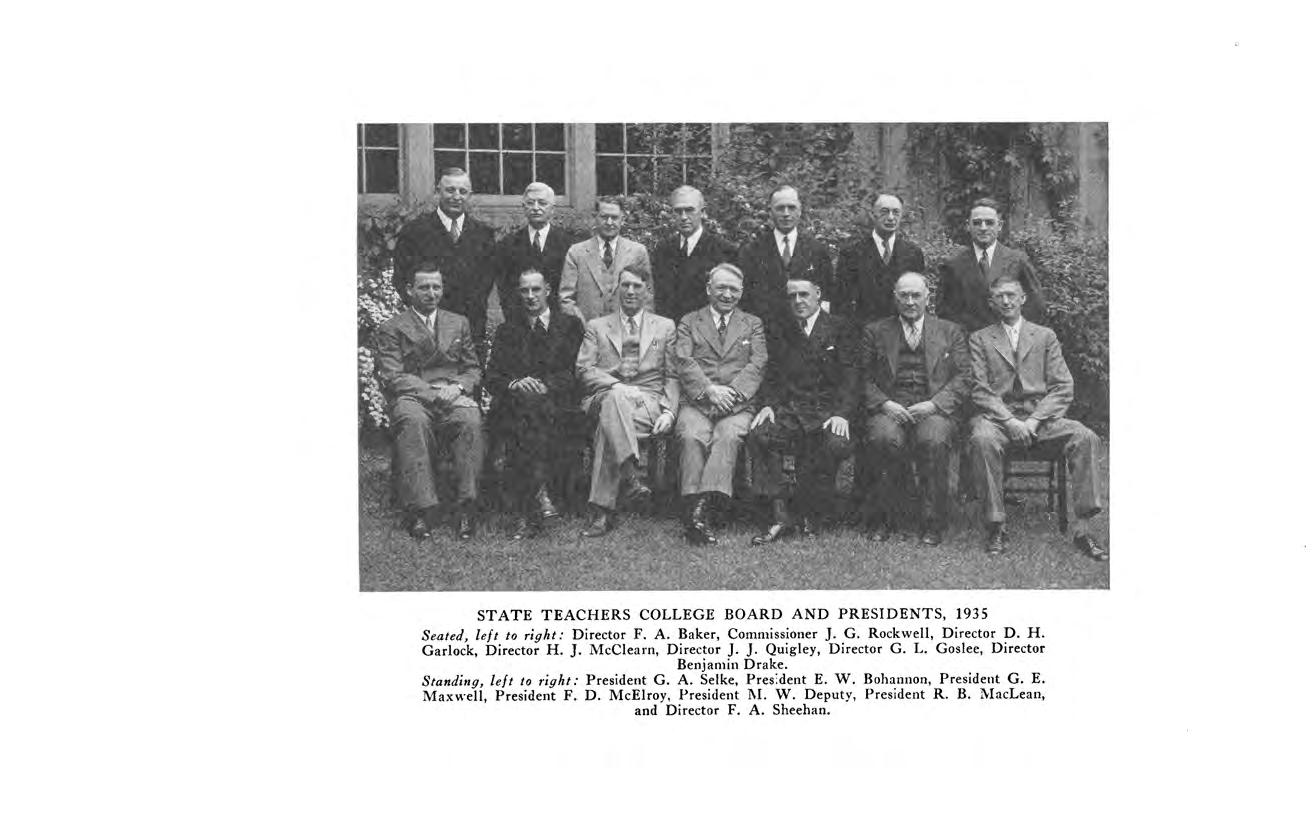
Seated, left to right: Director F. A. Baker, Commissioner J. G. Rockwell, Director D. H. Garlock, Director H. J. McClearn, Director J. J. Quigley, Director G. L. Goslee, Director Benjamin Drake.
Standing, left to right: President G. A. Selke, President E. W. Bohannon, President G. E. Maxwell, President F. D. McElroy, President M. W. Deputy, President R. B. MacLean, and Director F. A. Sheehan.
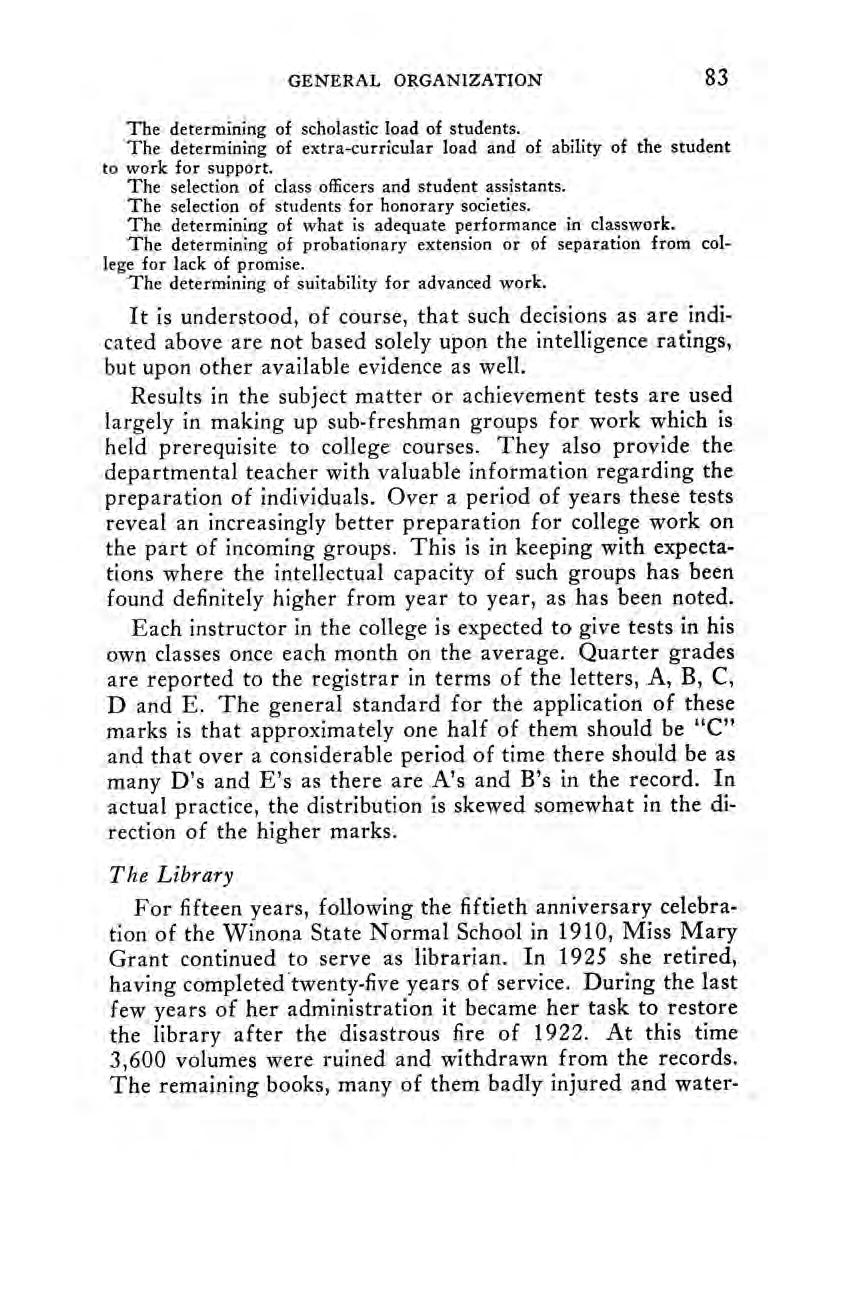
The determining of scholastic load of students.
The determining of extra-curricular load and of ability of the student to work for support.
The selection of class officers and student assistants.
The selection of students for honorary societies.
The determining of what is adequate performance in classwork.
The determining of probationary extension or of separation from college for lack of promise.
The determining of suitability for advanced work.
It is understood, of course, that such decisions as are indicated above are not based solely upon the intelligence ratings, but upon other available evidence as well.
Results in the subject matter or achievement tests are used largely in making up sub-freshman groups for work which is held prerequisite to college courses. They also provide the departmental teacher with valuable information regarding the preparation of individuals.Over a period of years these tests reveal an increasingly better preparation for college work on the part of incoming groups. This is in keeping with expectations where the intellectual capacity of such groups has been found definitely higher from year to year, as has been noted. Each instructor in the college is expected to give tests in his own classes once each month on the average. Quarter grades are reported to the registrar in terms of the letters, A, B, C, D and E. The general standard for the application of these marks is that approximately one half of them should be “C” and that over a considerable period of time there should be as many D’s and E’s as there are A’s and B’s in the record. In actual practice, the distribution is skewed somewhat in the direction of the higher marks.
For fifteen years, following the fiftieth anniversary celebration of the Winona State Normal School in 1910, Miss Mary Grant continued to serve as librarian. In 1925 she retired, having completed twenty-five years of service. During the last few years of her administration it became her task to restore the library after the disastrous fire of 1922. At this time 3,600 volumes were ruined and withdrawn from the records. The remaining books, many of them badly injured and water-

soaked, were repaired and made usable again. The library catalog and other records were restored as well.
The library, in the twelve years since the fire, has been gradually recovering, balancing once more its collection, and attaining the standards set by the American Association of Teachers Colleges and the North Central Association. It now contains over 15,000 volumes. In addition it has a special collection of reserved books, numbering 2,000.
The juvenile library, which is housed in the main library reading room, has been reorganized within the last five years. The books have been chosen largely from the Minnesota State Library List, prepared by Miss Harriet A. Wood, State Supervisor of School Libraries, from which list selection must be made by the schools of Minnesota if state library aid is to be received. The books are arranged according to the modification of the Dewey decimalclassification scheme which Miss Wood uses in her list. This collection has grown to more than 2,000 volumes, and has its own catalog which the children are taught to use.
This juvenile library hasbeen built up, not only with the purpose of furnishing recreational reading for the children of the Phelps School and supplying supplementary material for the teachers, but also with the aim of acquainting the students of the college with the books which are recommended by the State Department of Education. These books have been purchased in the editions which the state supervisors consider suitable for school libraries.
A collection of about 200 juvenile books, in especially attractive editions, is set aside for the use of the college classes in children’s literature.
In addition to the book collection, the library has about 3,000 bound periodicals, many of which run back seventy-five or a hundred years. The library also has in its possession a complete file of the Congressional Record dating from 1789. This collection of older materials, which are of especial value to research workers, is supplemented by over 150 current periodicals which are in constant use for reference work in all school subjects.
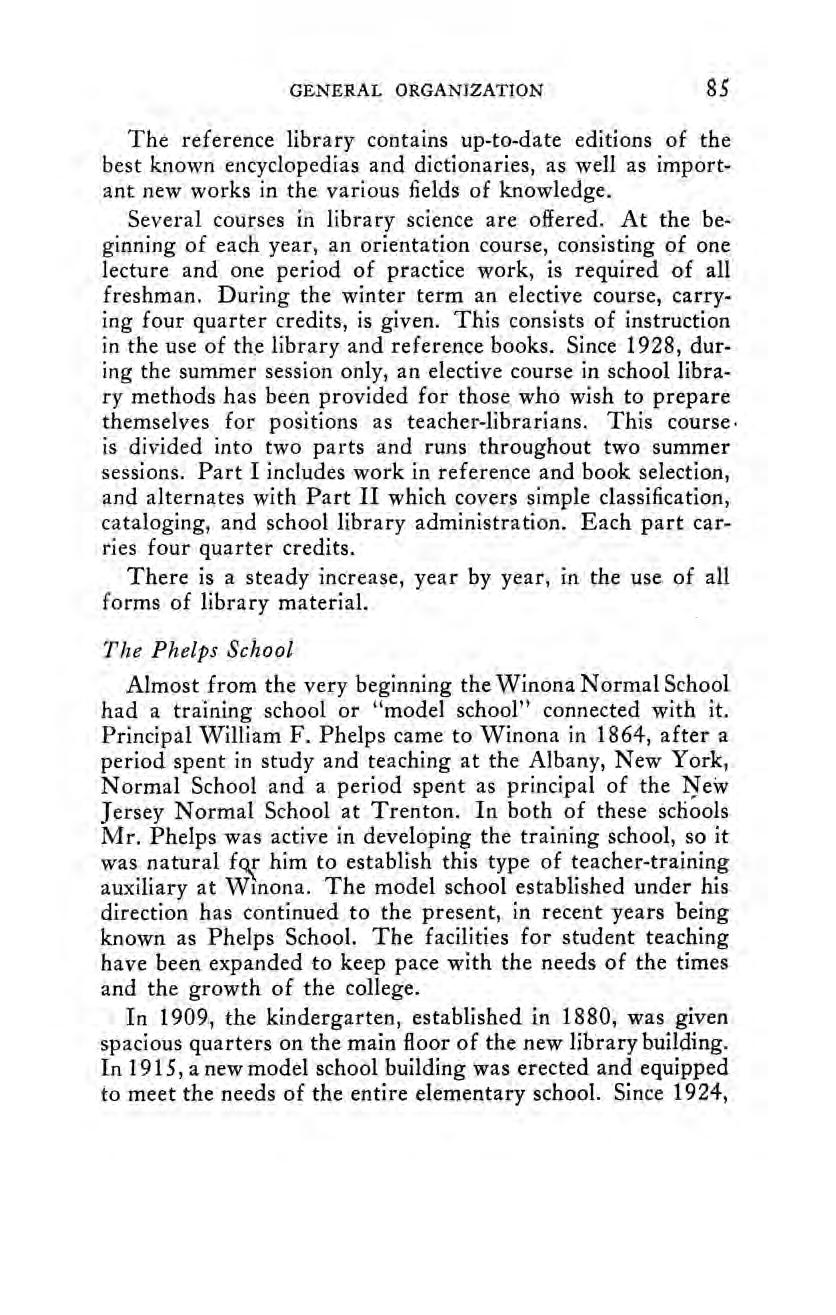
The reference library contains up-to-date editions of the best known encyclopedias and dictionaries, as well as important new works in the various fields of knowledge.
Several courses in library science are offered. At the beginning of each year, an orientation course, consisting of one lecture and one period of practice work, is required of all freshman. During the winter term an elective course, carrying four quarter credits, is given. This consists of instruction inthe use of the library and reference books. Since 1928, during the summer session only, an elective course in school library methods has been provided for those who wish to prepare themselves for positions as teacher-librarians. This course. is divided into two parts and runs throughout two summer sessions. Part I includes work in reference and book selection, and alternates with Part II which covers simple classification, cataloging, and school library administration. Each part carries four quarter credits.
There is a steady increase, year by year, in the use of all forms of library material.
Almost from the very beginning the Winona Normal School had a training school or “model school’ connected with it.
Principal William F. Phelps came to Winona in 1864, after a period spent in study and teaching at the Albany, New York, Normal School and a period spent as principal of the New Jersey Normal School at Trenton. In both of these schools Mr. Phelps was active in developing the training school, so it was natural far him to establish this type of teacher-training auxiliary at Winona. The model school established under his direction has continued to the present, in recent years being known as Phelps School. The facilities for student teaching have been expanded to keep pace with the needs of the times and the growth of the college.
In 1909, the kindergarten, established in 1880, was given spacious quarters on the main floor of the new librarybuilding. In 1915, anew model school building was erected and equipped to meet the needs of the entire elementary school. Since 1924,
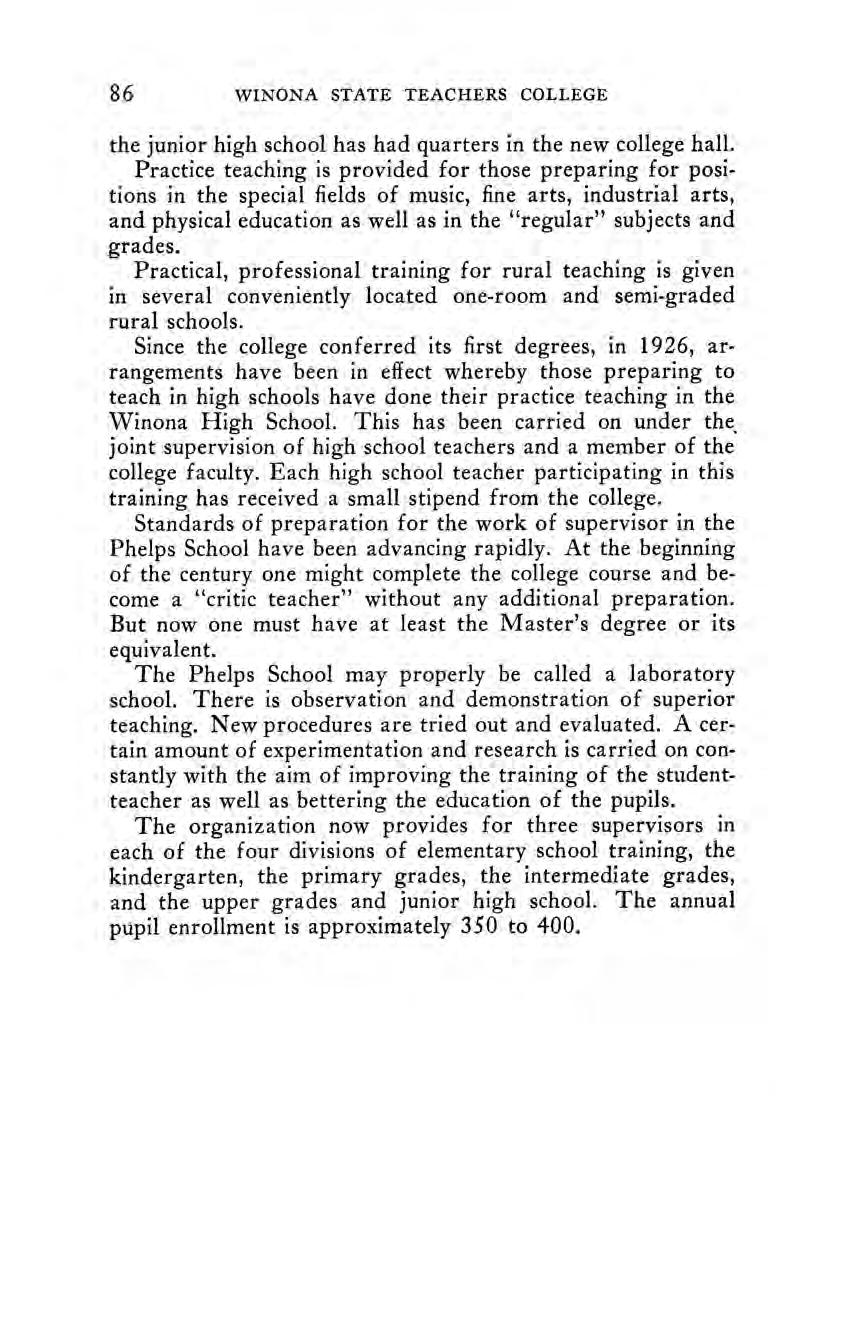
the junior high school has had quarters in the new college hall. Practice teaching is provided for those preparing for positions in the special fields of music, fine arts, industrial arts, and physical education as well as in the “regular” subjects and grades.
Practical, professional training for rural teaching is given in several conveniently located one-room and semi-graded rural schools.
Since the college conferred its first degrees, in 1926, arrangements have been in effect whereby those preparing to teach in high schools have done their practice teaching in the Winona High School. This has been carried on under the joint supervision of high school teachers and a member of the college faculty. Each high school teacher participating in this training has received a small stipend from the college.
Standards of preparation for the work of supervisor in the Phelps School have been advancing rapidly. At the beginning of the century one might complete the college course and become a “critic teacher’? without any additional preparation. But now one must have at least the Master’s degree or its equivalent.
The Phelps School may properly be called a laboratory school. There is observation and demonstration of superior teaching. New procedures are tried out and evaluated. A certain amount of experimentation and research is carried on constantly with the aim of improving the training of the studentteacher as well as bettering the education of the pupils.
The organization now provides for three supervisors in each of the four divisions of elementary school training, the kindergarten, the primary grades, the intermediate grades, and the upper grades and junior high school. The annual pupil enrollment is approximately 350 to 400.

During the past quarter-century one of the most striking developments has been the increase in the number and in the importance of student organizations. Some of these represent a quite obvious means of improving their members in their broad fields of specialization. Illustrations of these would be the Kindergarten Club, the Primary Club, the Intermediate Grade Club, and the Junior High School Club, which meet regularly for professional study anddiscussion. Incidentally they engage in strictly sociable activities occasionally, and they have taken their turns in organizing all-college parties.
Other student organizations, whose functions are not adequately indicated in their names, are here briefly described.
The training received in some of these organizations is so definitely educational that a small amount of curricular credit is allowed for it. This is true of the Mendelssohn Club, the Apollo Club, the senior band, the orchestra, debate, and of certain positions in the Wenonah, the Winonan, and the Wenonah Players.
Mendelssohn Club
For thirty-five years the Mendelssohn Club, an organization of young women students, has had for its purpose the stimulation of the musical life of the school and the community through its high musical standards. Founded by Miss Caroline V. Smith in 1900, it has served the college longer than any other organization. It has sung regularly at various musical functions both in the college and community.
The annual May recital has become an important event in ‘the annals of the school, representing the culmination of the whole year’s work on the part of the club. A typical program, presented in 1923, may prove interesting. It was as follows:
Part ONE
In These Delightful Pleasant GroveS.......cccccssscsscssesseeeseetseeeesHenry Purcell
How Long Wilt Thou Forget Me, O Lord?....... Johannes Brahms
The Leprechaunna........ccccssscscesccsessscssessssssscenessessscseseeasesssseensBryreson Trehavne
A Page from Homer........cccceccssesscsssesscseesecsescesescesseensecnenaesRimsky-Korsakoff
The Call of Home...ccccccccccccsccssssecccssescseesssscessecssessesceeeeseeenaesLondonderry Air
Part Two

Harp Recital
Part THREE
The Garden of Flowers (Cantata).......cccccsccscsssesseseteceeerteeseeresLuigi Denza 1923 Medley Hail Winona
The program of the concert of 1935 may be of interest in contrast to this one of 1923. The program for 1935 was as follows:
Group ONE
Invocation to Sprimg......cccccccscccseessceseccesseessesesceneesseesssecseeseesLouis Victor Saar
CLOUdS ciccccccccsssssssscscescesscsscsecsccesesscsersceesscceeeesenaeseecaseasenecaseneesasaseneneas Charles Deis
Rain-Drops Charles Heurter
A Song in the Night...
cecccscceesetereeeneeeessereeraees Loughborough-Samuelson
Fairy Fantasy.......ccscssssscscsccsercesssccnsessesssssscssssseoessesesH. Alexander Matthews
Chit-Chat....ccccccccccscsesscssscsesseseseseessreeesOld English, arr. by Alfred Moffat
Group Two
Ave Maria wiccccccccsccscsccsscsccssesecssscssessccssseccssecssesecscsseseceaeeeceeceeceeseaseaseeneseaeesSchubert Habanera vcccccccccssescssessesssssscescscsscescsesseseeseneceecsenaeeerseecesecseeasssaesaesessseeonts Sarasate
Mr. Johannes Fossum, Violinist
Mrs. Willard Hillyer, Accompanist
Group THREE
The Snow cicsccccsscccsscsccsssscssssssscscsessesscsceaesecseeaeeesscscesscacssssasesssesssacseseesseneseessceens Elgar Grandfather’s Clock.........ccscscsseceeereesesecssesssseseseseeeeesseesensseeneneensArr. by Moore
Little Boy Blue ....cccseessesessssessssscsssssssesesscesseesesesensesenssssesssseneensessseaeneseneeseesNevin
Lullaby wiccccsccsssssssssesccssseecsseesesesscsessscssssscsneeseessessesesersseneeenenesesesessnenenees Brahms
American Lallaby.......cccccccscccssssseeeessecesssscsssssesssseeeesesesnenssnesessensssesseaseGlady Rich
Two Czech Carols
Lullaby Gloria in Excelsis
Group Four
Caprice Vienmois ....c..cccccescesscseseeeesetsssscsssscssessassssssssesssssesesssesessesesseseseseees Kreisler
ZiGEUMETWEISEN .o.sccsescesessscecescsseseesecsseeesssssscssseseesenseseseseesenessssesesessesetsesnseees Sarasate
Mr. Fossum, Violinist
Mrs. Hillyer, Accompanist
Sylvia Dances, Valse Lente from the Ballet Sylvia......Delibes, arr. by Cross
My Lover Is a Fisherman... ccscsssescsscessseseesssessesssesssesscesecesseeseaes Strickland Fulfillment, from Arabian Song Cycle.......ccccccccescsssesesscssesrscsseeesC. G. Spross Sweetheart Land wccccccccscsssssssessssscssessssesesessessssesseaessssesestscsecseseesscssses Heurter
My Johann ou. .....Grieg-Aslanoft
Deep in the Valley......cccccscccssssecssesecseeecsscsseeeecsesseessseeeeeaseesesenesBesly-Samuelson
The False Prophet.......ccccccccccssscsesscsscsscssssscsssecesssesscssssscssesessevseceecsacsrsensnensScott
The club has had a membership ranging from sixteen to twenty-five.
The Apollo Club is a choral club including from sixteen to twenty young men. Organized in 1929, it has carried on a serious study of music each year, giving a public recital in the spring. It has become customary for it to take a good-will tour for a week in April, singing in numerous Minnesota high schools.
At its latest home recital, April 5, 1935, it presented the following program, with the assistance of Mrs. Keith Emery, violinist, and Dr. Fred J. King:

APOLLO CLUB
Song of the Huntin. ccccseessssesstssssssssssssesseessesesessessssssnesseesenees Cox
The Light of Dawning... ccsccsssssecnseeeenees Tchaikovsky-Federlein
The Two Grenadiers...cccccccccccccsssccssscssecsssessseeescseceseeseaaesSchumann-Zeimer
SoNATA FOR VIOLIN AND PIANO
Allegretti
Allegro cescccsecsesssssessesesesesssseesscsssnssceesesesseseseseacsesesesenssneneseneneenenens Cesar Franck
ApoLLo CLUB
Silent Strings ...ccccsssesecsccsesseseccssesesessescssesssesscssscesssesssssssssseessseseesseaeers Bantock Were You There....ciccccsccscsscssscscssccesecsssesseessesssevsecsesesssoeseensNegro Melody
Were I a King.icccccccccsssssssssscsssssceccssccseesssecscevsssessnssesesesessssessesseseeassessegsSpeaks Lift Thine Eyyes.........ccccscscssssrcecsscessssesscsssssescesseesscasscsesecsesessesenecenenenseeesLogan
INTERMISSION
BARITONE SOLOS
When I Have Sung My Songs... Charles Laughing Cavalier .....cccsssssscssesersesenssessessseesereees sasestesseetenseseesees Sanderson
Edwin Neeb

VIoLINn SOLos
Adagio Religioso ...c.ccccccccsssssssssssssssssesssssssscsssscsossesssesseevastseecatseessVieuxtemps Pierrot Serenade .......ccccccscsscssssssssscssesessesscsssscsscsssscsacscesssecctsceaceaeace Randegger Mrs. Emery APOLLO CLUB
Maiden, Such a Magic Lies.....ccccsccsssssssssescscsesessssesssesescssetscsessesesTravers
Smuggler’s Song ...cccccscssssessssessssssssssssscssssessscvscsesscscscecesesesecsteceecaces Kernochan Shadow March Pratheroe
The Cossacks ....ccccccsccsesssssscsssssscsssssssesssssscsscevsssssecsssecaseseeescenss Van Norman
The club was organized in 1920 by the young women who were taking the public school music course. The organization during its first years was primarily social in purpose; however, at its regular monthly meetings such topics were discussed as “The Symphony Orchestra,” and ‘(Methods of Conducting.” It became customary for the members of the club to present an operetta during the winter quarter.
In recent years, in line with its aim of developing appreciation of the best music and a wider knowledge of musical artists and composers, the club has presented musical programs at each of its meetings, most of the ‘“‘talent’”” being members.
The organization has a membership of twenty-five.
The college band dates from 1927 when it had nine members and was led by the college music director. Its appearances were practically limited to pep fests, football games and the homecoming parade. It continued on about this basis for three years when the director of the Winona Municipal Band, Mr. O. E. Reese, was engaged to take charge of the organization, giving attention to the beginners’ or junior band as well as to the senior band, those who had had some band experience. The number of members in the combined organizations was thirty-five.
Since 1931, the band has had student directors: Mr. Don Karow, 1931-32; Mr. A. G. Gullickson, 1932-33; and Mr. Harold Edstrom, assisted by his brother, Everett Edstrom, 1933-35,

THE COLLEGE BAND, 1934

On February 10, 1933, at an assembly program, the band made its first appearance in its striking purple and white uniforms. The senior organization now has fifty members. It appears at practically all important athletic contests and at other college events. It gives occasional concerts for the school and community.
The orchestra was organized in 1920, with seventeen members. Its purpose was to contribute to the enjoyment of the members themselves as well as to the enjoyment of the school. The next year, made up of student and faculty members, it furnished “pep”? music for the football games and played rather frequently at chapel exercises, contests and social affairs. It lapsed during 1922 and 1923, but was reorganized in 1924. Since that time it has made its contribution to school exercises quite regularly as well as to occasional meetings away from the college. Its present membershipis sixteen.
The Art Club was organized September 25, 1923. At first the membership was limited to fifteen. This was gradually increased until today the club limits membership to twenty-five students. In the first constitution the following qualifications were noted: “Anyone is qualified for entrance into the club who Is interested and has ability in industrial, applied, or fine art.”
The meetings of the club at first were held weekly. Later this procedure was changed to semi-monthly meetings, one social and one work meeting.
The art club has a three-fold purpose: first,.to further interest in art; second, to raise the standards of art work; and third, to be of assistance in developing art problems related to college work. The results of this three-fold aim are found in the various activities of the club, the most important of which are: first, the decorations for the annual ‘‘Prom’’; second, supplying the ‘“Wenonah” with staff artists; third, occasional artexhibits; fourth, construction at Christmas time of
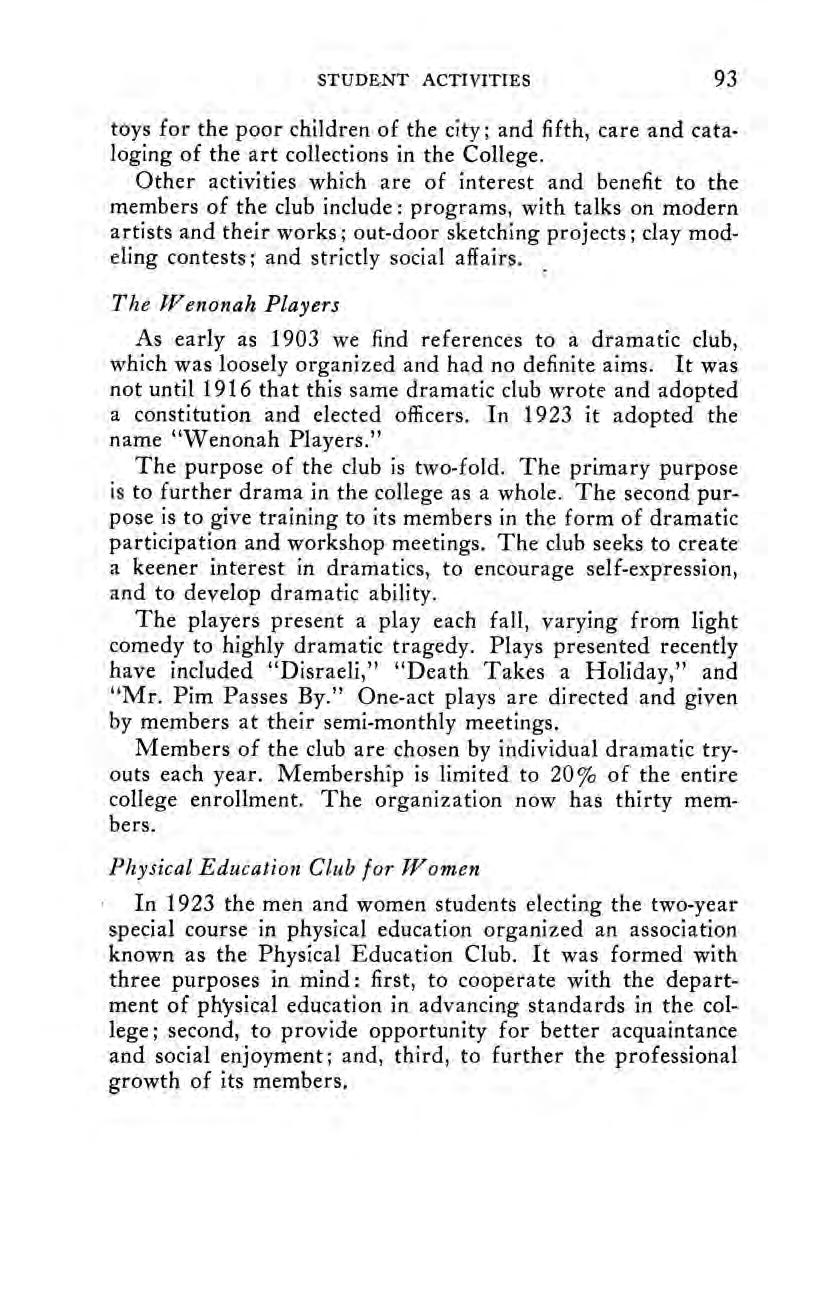
toys for the poor children of the city; and fifth, care and cataloging of the art collectionsin the College.
Other activities which are of interest and benefit to the members of the club include: programs, with talks on modern artists and their works; out-door sketching projects; clay modeling contests; and strictly social affairs.
As early as 1903 we find references to a dramatic club, which was loosely organized and had no definite aims. It was not until 1916 that this same dramatic club wrote and adopted a constitution andelected officers. In 1923 it adopted the name “Wenonah Players.”’
The purpose of the club is two-fold. The primary purpose is to further drama in the college as a whole. The second purpose is to give training to its members in the form of dramatic participation and workshop meetings. The club seeks to create a keener interest in dramatics, to encourage self-expression, and to develop dramatic ability.
The players present a play each fall, varying from light comedy to highly dramatic tragedy. Plays presented recently have included “Disraeli,” ‘Death Takes a Holiday,” and ‘‘Mr. Pim Passes By.” One-act plays are directed and given by members at their semi-monthly meetings.
Members of the club are chosen by individual dramatic tryouts each year. Membership is limited to 20% of the entire college enrollment. The organization now has thirty members.
In 1923 the men and women students electing the two-year special course in physical education organized an association known as the Physical Education Club. It was formed with three purposes in mind: first, to cooperate with the department of physical education in advancing standards in the college; second, to provide opportunity for better acquaintance and social enjoyment; and, third, to further the professional growth of its members,
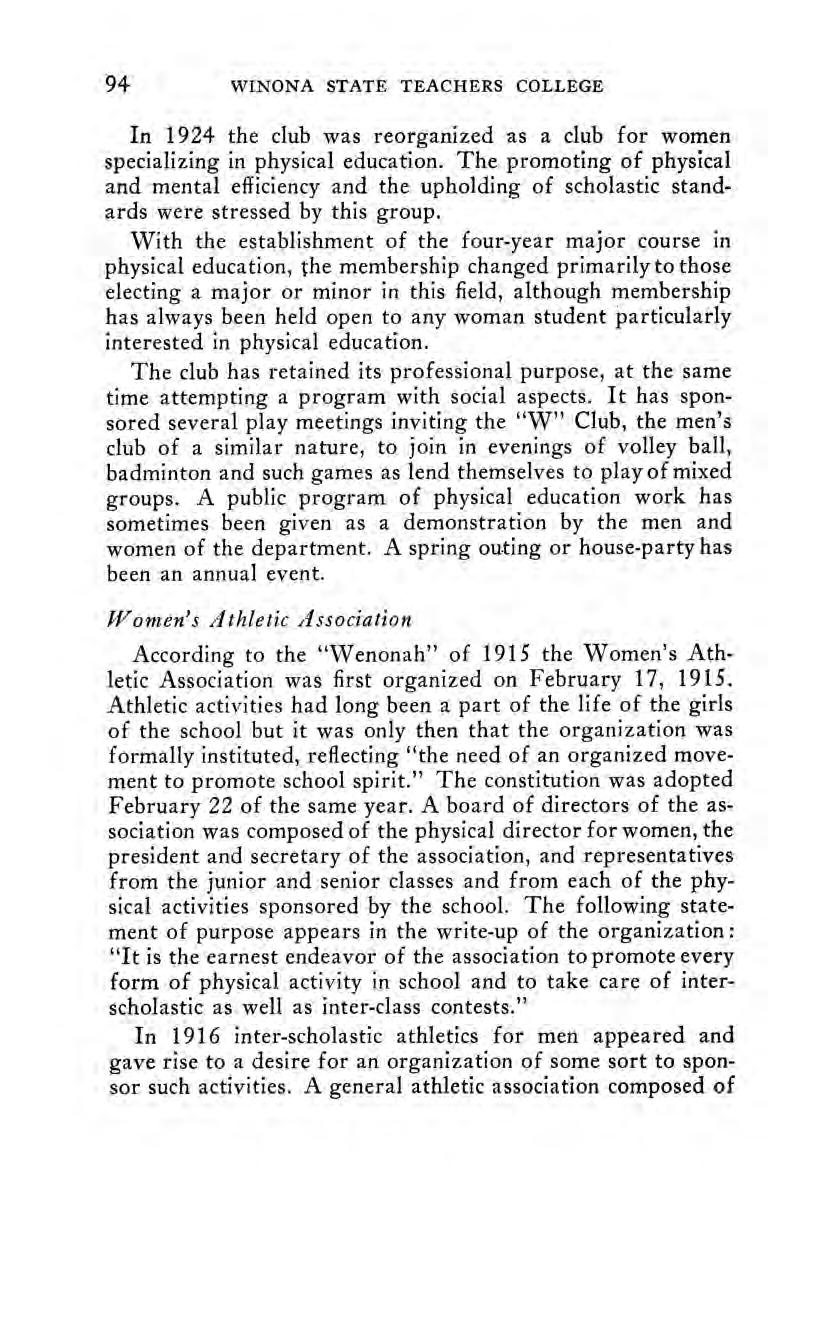
In 1924 the club was reorganized as a club for women specializing in physical education. The promoting of physical and mental efficiency and the upholding of scholastic standards were stressed by this group.
With the establishment of the four-year major course in physical education, the membership changed primarily to those electing a major or minor in this field, although membership has always been held open to any woman student particularly interested in physical education.
The club has retained its professional purpose, at the same time attempting a program with social aspects. It has spon- sored several play meetings inviting the ‘“W”’ Club, the men’s club of a similar nature, to join in evenings of volley ball, badminton and such games as lend themselves to play of mixed groups. A public program of physical education work has sometimes been given as a demonstration by the men and women of the department. A spring outing or house-party has been an annual event.
According to the ‘‘Wenonah” of 1915 the Women’s Athletic Association was first organized on February 17, 1915. Athletic activities had long been a part of the life of the girls of the school but it was only then that the organization was formally instituted, reflecting ‘‘the need of an organized movement to promote school spirit.”” The constitution was adopted February 22 of the same year. A board of directors of the association was composed of the physical director for women, the president and secretary of the association, and representatives from the junior and senior classes and from each of the physical activities sponsored by the school. The following statement of purpose appears in the write-up of the organization: “It is the earnest endeavor of the association to promote every form of physical activity in school and to take care of interscholastic as well as inter-class contests.”
In 1916 inter-scholastic athletics for men appeared and gave rise to a desire for an organization of some sort to sponsor such activities. A general athletic association composed of
all members of the school was formed, being called the Winona Normal School Athletic Association. Membership fees of fifty cents per quarter or one dollar per year admitted to all contests held under the auspices of the association. Offices were alternated yearly between men and women and final authority was vested in a board of control composed of an equal number of men and women and three members of the faculty.
The women’s branch of the athletic association continued under the old constitution previously set up for the women’s
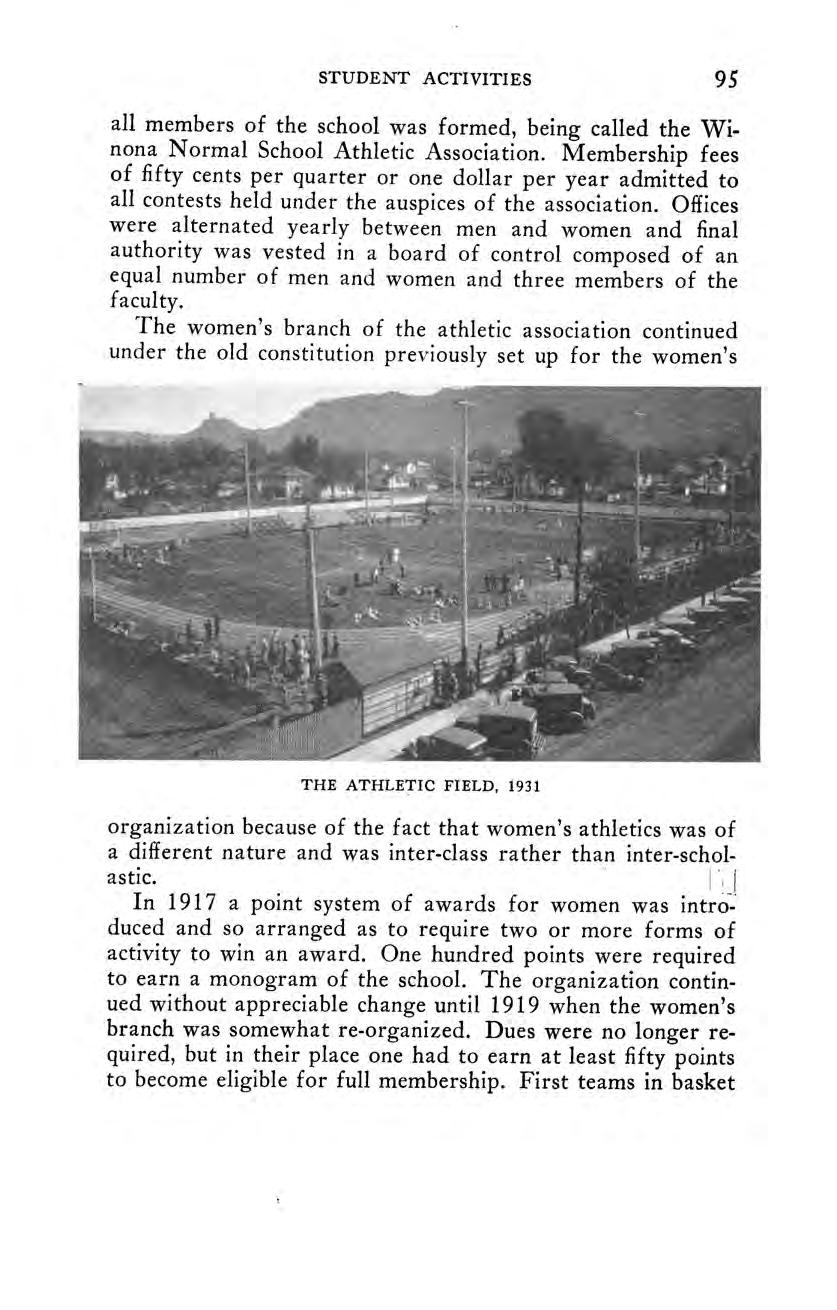
organization because of the fact that women’s athletics was of a different nature and was inter-class rather than inter-scholastic.
In 1917 a point system of awards for women was introduced and so arranged as to require two or more forms of activity to win an award. One hundred points were required to earn a monogram of the school. The organization continued without appreciable change until 1919 when the women’s branch was somewhat re-organized. Dues were no longer required, but in their place one had to earn at least fifty points to become eligible for full membership. First teams in basket
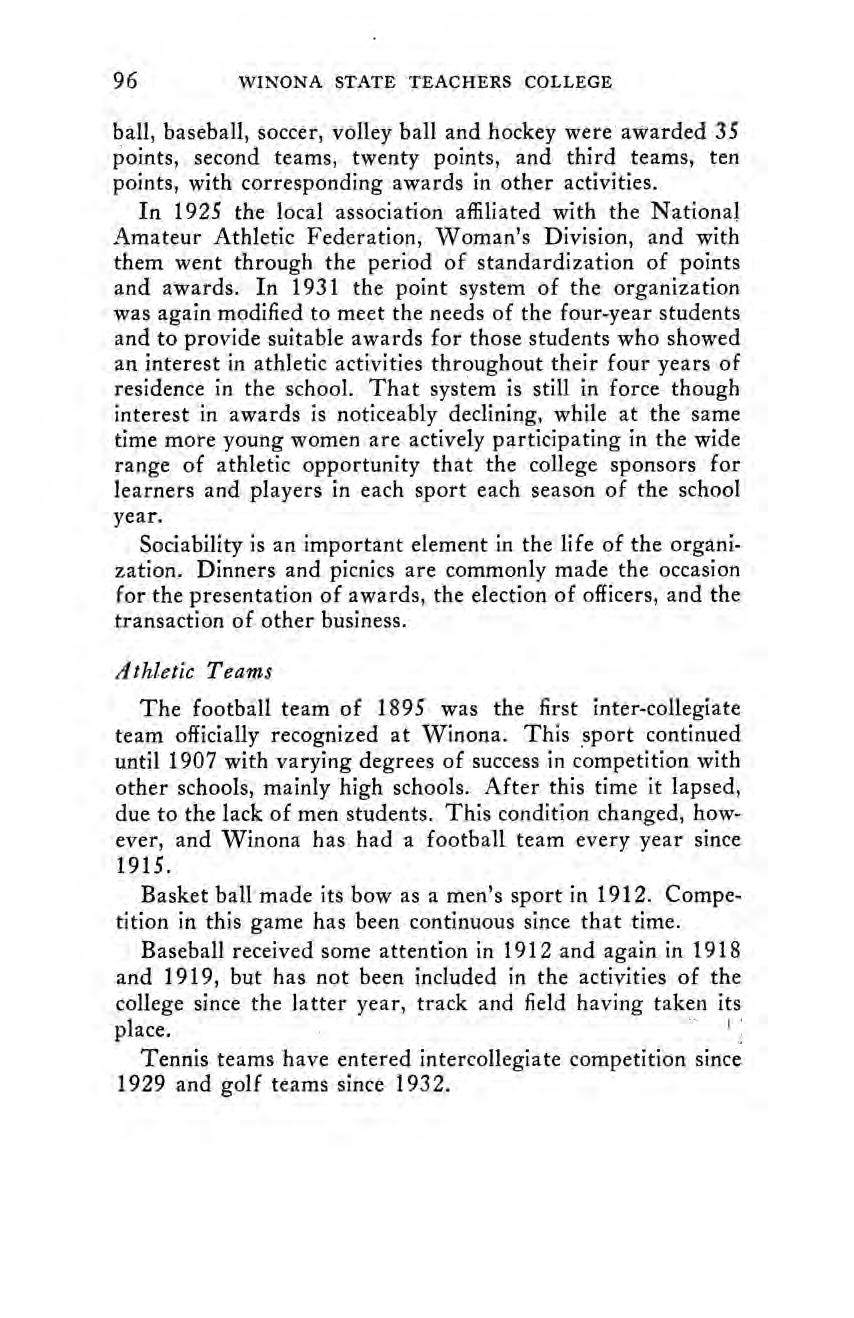
ball, baseball, soccer, volley ball and hockey were awarded 35 points, second teams, twenty points, and third teams, ten points, with corresponding awards in other activities.
In 1925 the local association affliated with the National Amateur Athletic Federation, Woman’s Division, and with them went through the period of standardization of points and awards. In 1931 the point system of the organization was again modified to meet the needs of the four-year students and to provide suitable awards for those students who showed an interest in athletic activities throughout their four years of residence in the school. That system is still in force though interest in awards is noticeably declining, while at the same time more young women are actively participating in the wide range of athletic opportunity that the college sponsors for learners and players in each sport each season of the school year.
Sociability is an important element in the life of the organization. Dinners and picnics are commonly made the occasion for the presentation of awards, the election of officers, and the transaction of other business.
The football team of 1895 was the first inter-collegiate team officially recognized at Winona. This sport continued until 1907 with varying degrees of success in competition with other schools, mainly high schools. After this time it lapsed, due to the lack of men students. This condition changed, however, and Winona has had a football team every year since 1915.
Basket ball made its bow as a men’s sport in 1912. Competition in this game has been continuous since that time.
Baseball received some attention in 1912 and again in 1918 and 1919, but has not been included in the activities of the college since the latter year, track and field having taken its place. a
Tennis teams have entered intercollegiate competition since 1929 and golf teams since 1932.

Winona’s formal athletic conference affiliations began in 1923 when she enteredthe State Junior College Conference. In 1932, with the other teachers colleges of the state, Winona withdrew from this affiliation to enter the Northern Teachers College Conference, which includes, for the present, only the teachers colleges of Minnesota.
There is reason to believe that the competition in this conference is on a par with that in the Minnesota College Conference.
The “W” Club, as the name suggests, is composed of those who have won lettersin athletics. Itis therefore an honorary society. yd
This club was first organizedin 1921 for the purpose of promoting interest in athletics. Thereis no further record of the organization until 1929 when it was reorganized under a new constitution providing two degrees of membership: the initiatory degree, and the ‘‘W” degree. The original emblem —a gold “W” set with nine half pearls—was re-adopted.
In 1930, Tuesday and Thursday were established as “purple letter days.” On these days all ‘“W” members wear their letters.
In 1932 the club donated a tennis trophy to the college. It hopes to contribute to a worthy cause each year.
The Gamma Tau chapter of Kappa Delta Pi, a national honor society in education, was installed at the Winona State Teachers College February 10, 1934.
Fifteenjuniors and seniors of the college at that time and ten graduates of the previous year were initiated into active membership. President G. E. Maxwell and Miss Theda Gildemeister were made honorary members. Charles L. Simmers, a member of the Kappa chapter, was chosen counselor. Upon the establishment of the chapter, the John Dewey Club which had been formed as a local honor society in education, was discontinued.

The purpose of the society is to aid in fostering high professional standards within the college and in the teaching profession; to give better recognition to students who give unusual promise for service in educational work because of their excellence in scholarship, participation in extra-curricular activities, their manifestation of high personal, social, ethical and other professional qualities; and their resultant contribution to the professional and cultural life of the school.
At the request of the Representative Council of the college, Kappa Delta Pi took over the work of fostering Purple Key, which is a local honor society. It was organized in May, 1932, by the John Dewey Club to provide for recognition of intensive and extensive achievement in scholarship, participation in student activities, and professional attitudes.
Not more than ten students each year are to be chosen to membership in Purple Key. They must have a scholastic quotient of 1.75 or better, must have participated in four or more extra-curricular activities and manifested a high degree ofprofessional quality. They may be chosen from the students in the final quarter of their sophomore year, and from the juniors and seniors. Purple Key has no officers and holds no meetings. Election into its membership appears to be highly prized.
Interest in inter-collegiate debating was manifest for the first time in 1924, but no formal debates were held until three years later, when non-decision contests were arranged against the Eau Claire and La Crossse Teachers Colleges. The following year the schedule again included these two schools, with St. Mary’s, St. Thomas, and Macalester in addition. Since that time, from three to five opponents have been met each year, usually on the dual but sometimes on the triangular basis. Winona acquitted herself creditably in the only debate tournament that she has entered thus far, that at St. Cloud in 1934, being tied with the River Falls Teachers College for first place.
The high point of interest in debating was reached when a Winona team met a Cambridge University team in a non-de-

cision contest in the college auditorium on November 24, 1933.
This activity has sometimes been carried on as part of a course in argumentation and debate. Recently it has been on the extra-curricular basis.
In 1933, a group of students interested in international affairs organized an International Relations Club, operating under the general plan established by the Carnegie Endowment for International Peace. The club meets regularly, the various members making and discussing reports of significant political and social developments throughout the world. One important aim of the organization is to develop an interest in international matters on the part of the student body. The Carnegie Endowment makes liberal donations of up-to-date books and pamphlets for the use of the club.
The League of Women Voters, a branch of the national League, is a non-partisan organization which attempts to promote interest in political questions.among women voters, and seeks to create inthem the desire to participate in civic affairs through study of current political problems. Interest in this type of club is evidenced by the number of members who have been active in the college League since its reorganization here by the field secretary in 1930.
The Winonan
In the year 1919-20, the school had its first student publication, a weekly periodical known as ‘““The Pow-Wow...’ Its avowed aim was the development of school spirit. In addition to being printed for student circulation, it was also published each Thursday as a separate sheet of the ‘Winona Leader,” a Winona city paper with circulation in southern Minnesota and in Wisconsin and Iowa. A humorous supplement of the Pow-Wow was known as “The Pee-Wee.”’
In 1922, the title was changed to ‘“The Winonan,” and the paper was published bi-weekly. It was given quarters in the main building, and has functioned as an official school organ and a student newspaper. Since 1930 it has stressed literary material somewhat more than formerly. It has been financed by appropriations out of the student activity fund and by income from a small quantity of advertising.
Since 1930 The Winonan has received a number of awards for excellence from the Columbia Scholastic Press Association.

The functions of this publication may be said to be: 1, to express student opinion; 2, to provide information; 3, to promote school enterprises; 4, to keep a permanent record of school activities; 5, to foster school spirit; 6, to perpetuate traditions.
The members of the staff are chosen during the first month of each spring quarter, the outgoing editors selecting the new staff after try-outs. «+
The Wenonah
Since 1911 the graduating classes have published an ‘“‘annual,” called ‘““The Wenonah.” This has been similar to publications of other schools during this period. It has been uni-

formly printed on paper 8x1034 inches, and has varied in size from 72 to 180 pages. It is an attractive, pictorial record of persons and organizations and important events year by year. It has won several awards for excellence in competition with annuals produced by other schools in the same classification.
The Booster Club was organized in January, 1926, as an agency for assuming the responsibility of boosting school activities. This club informally made it debut into college society by sponsoring the football banquet in the fall of 1926. Any student was eligible to belong to this organization.
After a time the program of the club did not seem adequate. Through the efforts of a few ‘‘Boosters,” both students and faculty members, the Die-no-mo was organized. The purpose of the club was to give active support to and to create interest in all school activities. It was to be something alive, dynamic, hence the name Die-no-mo. The membership of the club was limited to ten per cent of the student body and the faculty. Five faculty members were elected to the position of “‘insulators.” The charter officers of this organization were: High Voltage (President) Ralfe Calkins; Voltage (Vice President) Bernice Jensen; Brush (Secretary-Treasurer) Elizabeth Burns; and Spark (Pep Chairman) Julian Neville.
The club has carried on an extensive program, including a yearly Die-no-mo “Show” for the purpose of supporting student enterprize and raising funds for securing and maintaining “good will’ contacts with high schools; sport events such as the football banquet, pep fests, and homecoming activities ; and student recruiting tours from the club itself. The first recruiting group consisted of Julian Neville, Ralfe Calkins, Leslie Johnson, Alfred Kalkbrenner, and President Maxwell They visited the high schools at Lewiston, St. Charles, Chatfield, and elsewhere.
A new men’s organization was introduced into the school during the winter term of 1921-22, adopting the name “Mu Epsilon Nu.”
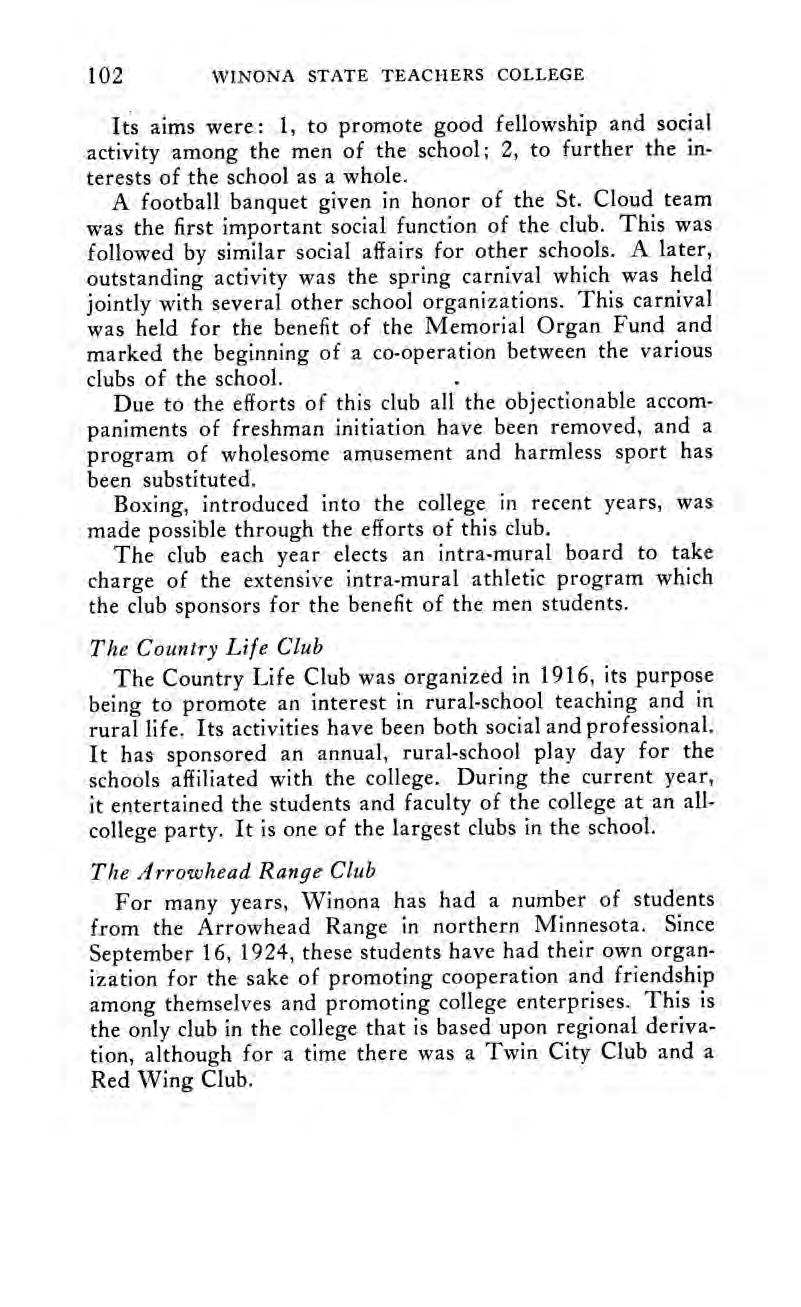
Its aims were: 1, to promote good fellowship and social activity among the men of the school; 2, to further the interests of the school as a whole.
A football banquet given in honor of the St. Cloud team was the first important social function of the club. This was followed by similar social affairs for other schools. A later, outstanding activity was the spring carnival which was held jointly with several other school organizations. This carnival was held for the benefit of the Memorial Organ Fund and marked the beginning of a co-operation between the various clubs of the school.
Due to the efforts of this club all the objectionable accompaniments of freshman initiation have been removed, and a program of wholesome amusement and harmless sport has been substituted.
Boxing, introduced into the college in recent years, was made possible through the efforts of this club.
The club each year elects an intra-mural board to take charge of the extensive intra-mural athletic program which the club sponsors for the benefit of the men students.
The Country Life Club was organized in 1916, its purpose being to promote an interest in rural-school teaching and in rural life. Its activities have been both social and professional. It has sponsored an annual, rural-school play day for the schools affiliated with the college. During the current year, it entertained the students and faculty of the college at an allcollege party. It is one of the largest clubs in the school.
For many years, Winona has had a number of students from the Arrowhead Range in northern Minnesota. Since September 16, 1924, these students have had their own organization for the sake of promoting cooperation and friendship among themselves and promoting college enterprises. This is the only club in the college that is based upon regional dertvation, although for a time there was a Twin City Club and a Red Wing Club.


The Catholic Students’ Club was formed in 1911 “to promote the mental and moral growth of the school.”’ At first its membership was limited to girls, but since 1924 all Catholic students are eligible for membership. About 1930 the organization became known as the Newman Club. The purpose of the Club is three-fold: spiritual, educational, and social—the emphasis being placed equally on these three aims.
Quarterly communion breakfasts provide an opportunity for members to receive communion in a body and then meet at the breakfast and hear an interesting and worth while talk by some local speaker of note. Meetings are held the third Sunday of each month. At some time during the year every club member acts on at least one committee, thus distributing among all the responsibility for the success of the club. Discussions, musical numbers, instructive lectures, social games and refreshments appear on the program of each meeting.
The club furthers its social aim by including among its activities a colorful Christmas party, an annual sleigh ride party, and a spring formal.
For the past three years the club has been a member of the Federated Newman Clubs. The local organization seeks to be of service to the college whenever possible by taking an active part in all school functions.
The Y. W. C. A., with about fifty members, has been functioning continuously for the past twenty-five years. During this entire period the main purpose of the club has been to promote friendliness in the college. As a means to this end, the club has sponsored a Friendship Day, has provided “Big Sisters” for all entering women students, and has promoted social life in the college. For several years a Girl Reserve leadership course has been given at the college by the general secretary of the city Association to give thestudents an insight into leadership of Christian work. At Christmas time gifts are taken by the club to the County Farm. The club seeks to emphasize unselfish service.

With the exception of one frame building now used as a men’s dormitory, the physical plant is all relatively new, architecturally attractive, and in good condition. The building latest to be constructed and at the same time the largest and most important, is, of course, the College Hall, erected in 1923-24 to replace the old main building which was destroyed by fire in 1922. At the very center of this building on the first and second floors is the auditorium, seating approximately 1,000 persons. Ample stage space and facilities are provided. Also on the first and second floors of this building, and behind the auditorium, is a gymnasium, used for physical education and athletic activities. Adjacent to this large gymnasium is a small one for corrective and remedial work in physical education.
The ground floor and first floor of the west wing of College Hall are used by the Phelps Junior High School. On the ground floor, to the east, are to be found the quarters of the industrial arts department, including a print shop, a drafting room, a woodwork shop, an elementary hand work room, a tool room and a lumber room. Home-economics rooms and art rooms are found at the front of the building on the ground floor, and gymnasium dressing-rooms beneath the auditorium. A club room for various informal meetings of students and faculty, located at the southwest corner, completes the facilities of the ground floor.
The administrative offices, an office for the dean of women, and for the director of Phelps School, a reception room, a study hall seating 100, and a large class-room are found on the first or main floor.
On the second floor are thirteen class-rooms, and laboratories for physics, chemistry, and biology. On the third floor,

in the tower, is one large music class-room, with three small studios for the giving of private lessons in music.
To the east of College Hall, and connected to it by means of an under-ground passage, is the library building constructed in 1909. In addition to housing the library on its second floor, this structure provides space for the college kindergaten on the first floor, and for a gymnasium with offices for nurse and physical director on the ground floor.
To the west of College Hall, and connected to it as is the library, is the elementary training school (1915), where practice teaching in the first six grades is carried on. This building is sometimes referred to as the Phelps School, although the name Phelps is officially made to cover not only the first six grades, but the junior high school, now housed in College Hall, as well as the kindergarten, located in the school library building. The elementary school building contains, on its three floors, ample school-room space for 200 children, together with a gymnasium, an industrial-arts shop, and a demonstration room equipped for the showing of slides and motion pictures.
These three buildings are located on the main campus, consisting of two city blocks, within four blocks of the main business section of the city. One block to the west of this main campus is another block of land upon which the three dormitories are located: Morey Hall (1911), accommodating eighty young women; Shepard Hall (1920) with facilities for sixty young women; and West Lodge, a rebuilt private dwelling housing twenty young men.
Three blocks south of the main campus is the athletic field. Although not quite of sufficient length for regulation football games and certain track events, this field is well constructed and equipped and has served many of the needs of the college quite satisfactorily. Besides the football field and the cinder track there are tennis courts and a baseball diamond. Bleachers accommodate 2,000 spectators. Powerful floodlights have made it possible to hold football and other games at night.

Through the generosity of Mr. F. S. Bell and Mr. S. L. Prentiss, the field is to be made of standard size in the near future. It will henceforth be known officially as Maxwell Field. *
Across the street to the east of this field is a smaller auxiliary field recently donated to the college and used mainly for football practice and for women’s sports.
In addition to these plots of land at the heart of the city, the college owns Garvin Heights, a tract of eight acres on the slopes and top of a near-by, easily accessible bluff. This is described and something of its value to the college is reported in the chapter on “Gifts to the College” (Chapter VIIT).
* See page 117.

During the past twenty-five years, alumni and friends have made gifts to the college which enable it, on the one hand, to provide educational opportunity each year to a number of persons of ability and character who would not otherwise be able to maintain themselves in a college and, on the other hand, to provide certain unusual cultural and aesthetic and recreational opportunities for all thestudents of the school. These gifts are, first, the loan and scholarship funds; second, the memorial pipe organ; third, the Watkins art collection; fourth, Garvin Heights; fifth, a play field; and sixth, an addition to “Maxwell Field.”
At the close of the first fifty years of the life of the college, a report was made of a Student Loan Fund (since namedthe Hutchinson Fund in memory of an early student), with a total cash value of $1,215.33.
Today there are four such rotating funds, from which loans are made to students who have been in attendance at least one year, and who have an average scholarship grade of “C”’ or better with a maximum of two hundred dollars to any one student.
The Ione DeLong Tearse non-interest-bearing Fund of $1,500.00 (1924 and 1930) is administered by the dean of women. The management of the other three is entrusted to the committee on loans and awards, composed of the president and four other faculty members.
The present status of these three loan fundsis as follows as shownin a report in February, 1935:
All scholarship funds appear to have been created within the current quarter-century. The first was established in 1913, and all others have been given to the college since 1924. The total scholarship funds now aggregate $48,500.00. These scholarships are as follows:

Of these scholarships three are specifically designated for young women, the remainder being assigned to either men or women. While ten scholarships have been listed, the flexibility of the Seventieth-Year Fund, together with an additional generous gift from one of the scholarship donors, has made it possible to give scholarship grants to twenty students during the year 1934-35.

On December 3, 1922, the old main building was destroyed by fire. With the loss of the building went many other things of great value, among these the class memorials of many years.
At the alumni reunion of the college, held in St. Paul on November 2, 1923, the program centered in the memories and associations of the building which had been destroyed. Plans for the replacement of the class memorials were proposed and the decision was reached to urge all of the classes to sponsor a fund for the purchase of a pipe organ to be installed in the new auditorium, instead of attempting to restore the old memorials.
Committees were then appointed, bulletins issued, and an extensive canvass for funds in and out of Winona was planned and carried out. The response on the part of alumni and friends of the college was enthusiastic and generous. A total of 1,050 pledges was secured, ranging from one dollar to two thousand dollars and approximating altogether $31,000.
“The organ proper was contracted for in April, 1924, through the Aeolian Company of New York City at a cost of
«$28,500. Building adjustments and materials, cost of electri-
cians, tinsmiths, and other workmen, the expense of expert supervision, printing, postage, etc., ran the total cost to $30,500, all of which was fully covered by subscriptions already paid.
The organ was first used in the commencement week program in June, 1925, and was finally completed and accepted in early January, 1926. A dedication program was given February 1, 1926, with Mr. Palmer Christian as organist. Vv
This organ has three manuals, pedals, 46 stops, and a DuoLArt control. It is used regularly in assembly programs and in * various concerts and recitals. Itis a fitting and beautiful symbol of the fine loyalty and generosity of the alumni and friends of the college, and at the same time it provides an important, cumulative, cultural impression upon generations of students as they come and go.

In 1924 and 1925, through the generosity of Mr. and Mrs. Paul Watkins of Winona, the college came into possession of a large and well-selected and valuable art collection. This gift provides an unexcelled basis for study and appreciation in the fields of art, history, and literature.
An important part of the Watkins gift to the College is made up of pieces of Roman statuary, secured in Rome and Florence, Italy, by Mr. and Mrs. Watkins during their travels there. The group includes four heroic busts of Roman emperors: Caesar Augustus, Hadrian, Marcus Aurelius, Septimus Severus, made up in all eight different colored marbles; supported by four fine marble pedestals. There is also a fluted vase, which with pedestal and base stands about eight feet in height. This ovoid fluted vase is of African marble; the column for it is in Verde Antico marble with a base and cap of Giallo Antico marble. A modern figure of Sappho in Carrara marble completes the group. The figure is portrayed by Antonio Garella, one of the best sculptors of monuments in Italy in the last century.
In the college library are six statuettes in terracotta representing the following Greek Muses, goddesses who presided over the nine principal departments of letters:
Calliope, of epic poetry.
Euterpe, of lyric poetry.
Erato, of love poetry.
Terpsichore, of choral song and dance.
Clio, of history.
Urania, of astronomy.
Above the center door leading into the college auditorium is a marble relief carving of Michelangelo Buonnarai.
Hung on the walls of the main corridor of College Hall are five beautiful glazed terracotta plaques. They are in the early and finest style of the Della Robbia terracotta work and are glazed largely in blue and white shiny glaze, with touches of yellow and green in the floral borders which surround the


Madonna plaques. Beside the Madonna plaques, are some of the Bambino relief sculpture, the circular insets by the Della Robbias, across the facade of the Hospital of the Innocents in Florence, Italy.
There are sixteen very fine relief sculpture units from the frieze of the Parthenon which stands on the Acropolis of Athens. The Parthenon sculptures were executed under the direction of Pheidias, the master sculptor in the fifth century,. B.C. Four of the sixteen units in the college collection deal with the gods and goddesses, among whom are Aphrodite and Eros, and magistrates and maidens in a procession in honor of Athena Parthenos; they are from the east frieze of the Parthenon. Twelve of the units are of the horsemen, warriors and their steeds, from the west frieze of the Parthenon.
Nearly 400 pictures were presented to the college by Mr. and Mrs. Watkins. The collection includes oil paintings, pastel drawings, etchings, engravings, lithographs, and photographs of works of art, collected by the donors in European art centers, and framed in a simple and appropriate style. Among the pictures are notably two remarkably fine, very large, col-
ored oil reproductions of Rembrandt’s ‘“‘Syndics of Cloth Hall” and “Elizabeth Bas,” which are hung at opposite ends of the college social room and add richness, dignity, and beauty to the room. Also in the social room are hung two original landscape paintings by Frederic Ede; elsewhere in the halls and stairways of College Hall are originals by Edward Menéghelli, N. Riegen, B. Borione, two small paintings and one large painting byAdolphe Gaussen, and a large marine by R. Pearson.
In the president’s office are seven very fine architectural scenes in chalk by Cecil Aldin. There are some eighty portraits of famous musicians, scientists, authors, poets, and artists; a large collection of engravings, some late eighteenth century, dealing with architectural subjects largely. There is a large group of remarkably fine photographic studies of exteriors and interiors of palaces, temples, cathedrals, and other fine architecture, and of paintings and sculpture of historic

and dramatic scenes as well as many by Michelangelo, Georgione, Raphael, Titian, Leonardo Da Vinci, Velasquez and others of the old masters.
A later addition to the art collection of the college given by Mr. and Mrs. Watkins consists of over 160 large photographic studies of ancient Egyptian, Greek, Roman, and Renaissance architecture, both exterior and interior; sculpture in relief, incised, and in the round; and painting, especially mural painting of the Egyptians as found in their tombs and temples, and some Renaissance painting, particularly Raphael and Michelangelo. There is a remarkably complete set of photographs of the ceiling and wall paintings by Michelangelo in the Sistine Chapel, Vatican, Rome. These photographs have been mounted on large folding stands in the main corridor of College Hall.
In addition to these treasures from Europe and the ancient world, there are two beautiful plaques, distinctly American, presented on January 1, 1925. These are to be found in the main building, on the sides of the main stairway leading to the first floor. One contains an excerpt from Washington’s Farewell Address, the other Lincoln’s Gettysburg Address. On one plaque is a relief of the head of George Washington, and on the other, of Abraham Lincoln. Both bronze plaques are mounted on dark green marble which 1s in turn embedded in the plaster walls.
Garvin Heights Park, a tract of eight acres, located on the highest and most accessible bluff south of the lake fill and overlooking the city of Winona, hasbeen made available and free to the public through the efforts and expenditures of Mr. and Mrs. H. C. Garvin, of Winona. The park, while it lies in the city limits, and is under the oversight of the city police, has by act of the state legislature now come under the Minnesota Forest Service in the sense that the appropriation for maintenance of the park is administered by Mr. G. M. Con-
zent, Director, with Mr. H. Ostergaard in charge of state forests.
Mr. Garvin, in the spring of 1918, secured the title to the land andmade it available to the State of Minnesota for use as a recreation center for the Winona State Teachers College. Then, on April 22, 1922, he deeded the land to the State of Minnesota, the same being accepted for the state by Governor J. A. O. Preus. Up to this time neither the college nor the state government has made expenditures for or within the park. Mr. Garvin, with unusual public spirit and generosity,
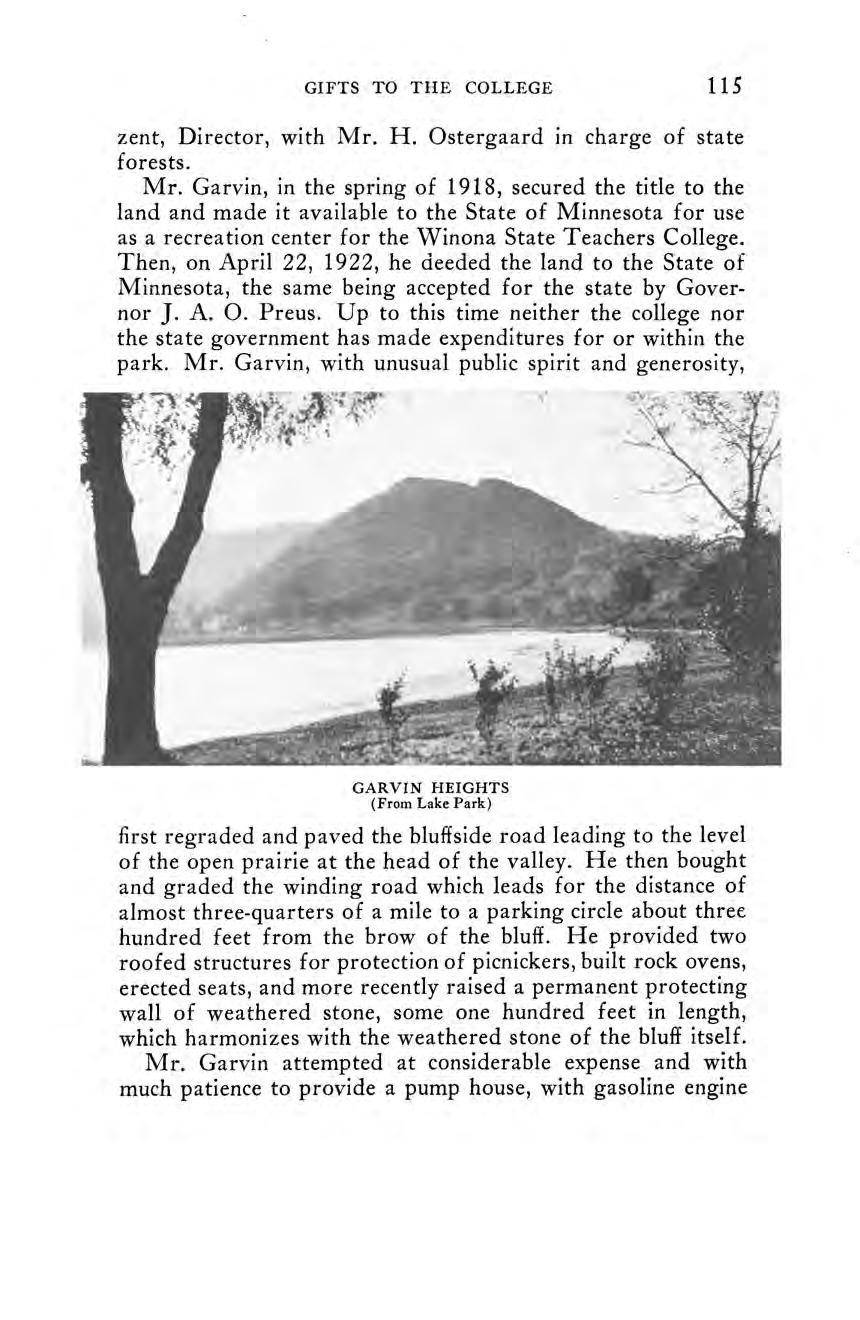
(From Lake Park)
first regraded and paved the bluffside road leading to the level of the open prairie at the head of the valley. He then bought and graded the winding road which leads for the distance of almost three-quarters of a mile to a parking circle about three hundred feet from the brow of the bluff. He provided two roofed structures for protection of picnickers, built rock ovens, erected seats, and more recently raised a permanent protecting wall of weathered stone, some one hundred feet in length, which harmonizes with the weathered stone of the bluff itself.
Mr. Garvin attempted at considerable expense and with much patience to provide a pump house, with gasoline engine

and a large concrete reservoir, whereby to provide water for the accommodation of visitors to the park. Vandals, however, destroyed all this expensive equipment so that the enterprise has been permanently abandoned.
Mr. Garvin has acquired several acres adjacent to the park itself, in order to increase the space for the use of the public. He has madea gift to the city of the tract of land located at the south end of the Huff street fill and east of Woodlawn Cemetery, where the toboggan slide was formerly located. At his request the City Council, in September, 1930, placed both these tracts under supervision of the Board of Park Commissioners for use as park properties. Moreover, the water hole just east of the south end of the Huff street fill has been graded, seeded, and parked, so that this has also become an attractive picnic site.
Itis the plan now for the city and the state to join in an adequate control of this park at all times. A caretaker, Mr. David Janikowski, has been employed and is sworn in as a city oficer. He will afford assistance to visitors, and will protect the park privileges in various ways. Signs for the guidance of strangers are to be erected, including this statement which will appear at the entrance gate at the head of the valley: “GARVIN HEIGHTS PARK, under joint state and city control, is open free to the public. Camping, fires, except in stone ovens, and guns, are forbidden. For information consult caretaker. By order of Chief of Police.”
Persons who have not given attention, will be surprised at the appreciation and use of this park by the citizens of this city. Actual count of visitors for two consecutive days in 1932 revealed an attendance of 581 on May 29, and497 on May 30. With the increase of automobiles and especially with better climbing capacity of these machines, the park will become even more popular. Citizens are especially proud to take strangers to this vantage point from which, on a clear day, one may have a splendid panoramic view of Winona, the Wisconsin hills, Trempealeau mountain, and many miles of the Mississippi River, including under favorable conditions, a view of Lake Pepin, forty miles distant.
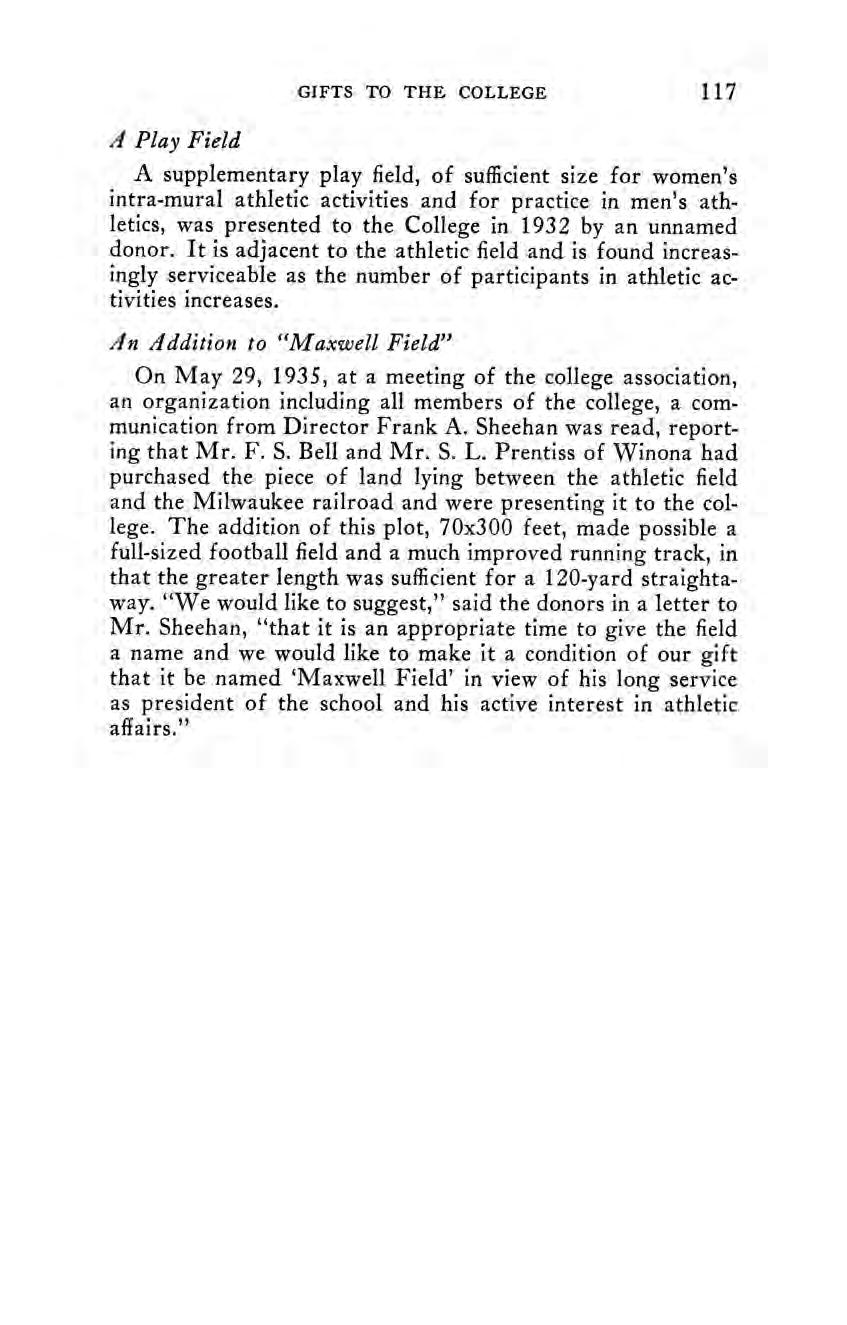
A supplementary play field, of sufficient size for women’s intra-mural athletic activities and for practice in men’s athletics, was presented to the College in 1932 by an unnamed donor. It is adjacent to the athletic field and is found increasingly serviceable as the number of participants in athletic activities increases.
On May 29, 1935, at a meeting of the college association, an organization including all members of the college, a communication fromDirector Frank A. Sheehan was read, reporting that Mr. F. S. Bell and Mr. S. L. Prentiss of Winona had purchased the piece of land lying between the athletic field and the Milwaukee railroad and were presenting it to the college. The addition of this plot, 70x300 feet, made possible a full-sized football field and a much improved running track, in that the greater length was sufficient for a 120-yard straightaway. ‘We would like to suggest,” said the donors in a letter to Mr. Sheehan, “that it is an appropriate time to give the field a name and we would like to make it a condition of our gift that it be named ‘Maxwell Field’ in view of his long service as president of the school and his active interest in athletic affairs.”

When the nation asked for war service, the Winona Normal School responded patriotically. The portrait of President Wilson marked the 1917 annual, ‘““The Wenonah,” and the editorial of that issue began: “‘As this goes to press, we know that our country has actively engaged in war.” A full page, in the flag colors, urged young men to enlist, and concluded with the question ‘Are you patriotic?” Under a wind-swept flag the names of those who had already enlisted were printed: Dr. Oliver M. Dickerson, teacher of history and social science, and eight students: Paul Baumgartner, Henry Muench, Arthur Gallien, Morton Wheeler, Leo Ryan, Walter Nissen, Sidney Page, and Richard Going.
A memorial service was held on the campus at the front entrance of the main building on July 4, 1917. Senator George H. Sullivan made the main address on the theme, ‘Eternal Vigilance is the Price of Liberty.”
On February 22, 1918, at chapel exercises, President Maxwell dedicated a service flag bearing forty-eight stars made by students under the leadership of Miss Esther Cooley and Miss Bertha Speckman, members of the faculty. It hung by a new, large American flag presented by the Alumni of the college. On the front of the main building hung a smaller service flag which all who passed might see.
A War Fund Committee of which Miss Florence L. Richards was chairman, raised funds for meeting special financial calls upon the student body for the support of war enterprises. Through a system of monthly payments the sum of one hundred dollars was given to the War Library Fund, and the same amount to the Y.M.C.A., the Y.W.C.A., the Belgian Milk Fund, and the Winona Chapter of the Red Cross. A set

of tools was sent to Major O. M. Dickerson for use at Camp: Dodge. Four-year-old Jean Cadero of Canivarch, France, was adopted by the college as a war orphan, and was the recipient of $36.50 annually for several years. A war garden near Lake Winona, planted and cared for by the young women students, produced potatoes and other vegetables which were sold to the dormitories.
The committee also planned means to raise money to purchase a one-hundred-dollar Liberty Loan Bond of every issue, the total to be the nucleus of a Liberty Loan Morey Hall Scholarship Fund. Chain teas were organized to raise part of this money. Later Miss Richards induced dormitory boarders to pay ten cents a month toward the fund, which, at the end of ten years had grown to six thousand dollars and was accepted by the Teachers Collegé Board as the ‘“‘World War Memorial Scholarship.”’ Miss Louise Sutherland and the Kindergarten Club started the Kindergarten Scholarship with two Liberty Loan Bonds.
The Morey Hall living room was converted into a Red Cross room once a week from December 15, 1917, through May 25, 1918. Red Crosses for thirty-six hours’ work were conferred upon Mildred Mannesrud, Florence Elson, Helen Rogers, Anna Bloom, Romana Thoeni, Charlotte Miller, and Gail Powell.
The 1918 Wenonah, called the War Annual, carried the following dedication: “To the boys at the front, with gratitude for their service, with appreciation for their sacrifice, and reverence for their cause, we dedicate this 1918 Wenonah.” It listed among the activities at commencement week an ‘‘Alumni-Senior War-Time Supper” at Morey Hall.
Thus the college “carried on” in the war enterprise.
The depression of the early 1920’s had little apparent adverse effect upon the school. Salaries for teachers had lagged behind those in other fields of activity during the war, but by 1921 were relatively satisfactory. Enrollment figures were not only maintained, but by 1922 and 1923, the enrollment was larger than it had been at any time.

The depression beginning in 1929 has struck with much greater severity. Enrollment has fallen off somewhat, probably twenty per cent. More of the students in attendance have earned part of their expenses. Many have rented rooms and have brought food from their homes instead of paying a very moderate fee for board and room at a college dormitory. This arrangement has been so common as to make it difficult to conduct the dormitories satisfactorily. One interesting development, probably related to the depression, is an increase in the number and proportion of men students. Under better economic conditions, it is likely that some of these young men would be employed and still others would be attending a college or university where the costs of attendance are greater. During the year 1934-35 over one-hundred young men and women have been given part-time employment for the college or under its supervision, receiving remuneration from the national and state governments under the Emergency Relief Administration.
Teachers in the college received a 20 per cent reduction in salary for the biennium 1933-35, this reduction being imposed by the state legislature. In the 1935 session the legislature restored one-half the amount of this loss.
The school has suffered three really major calamities. The first was the closing of its doors for two years during the Civil War. The second was the failure of the Legislature to make an appropriation for its support in 1876. The third was the fire of December 3, 1922, which completely destroyed the main building and damaged the library.
The old main building had beenin use since 1868. It was not of fire-proof construction, and the fire quickly spread through it, once it was under way. It occurred early on a Sunday morning when no one was in the building.
Since it was between the fall and winter terms, practically all of the students were at their homes.
The cause of the fire has never been determined, but a deputy state firemarshal who was sent to investigate the matter said that indications pointed to incendiarism.
The loss to the state was estimated to be about $500,000. In addition there were numerous losses upon which it was impossible to place a value: personal and professional belongings of faculty members; collections of birds, minerals and botanical specimens in the museum; pictures and other memorials left by graduating classes. Fortunately the permanent records, affecting thousands of students and graduates, were ina fireproof vault and were unharmed.
College activities were under way in an unbelievably short time after the fire. An all-school assembly was held in the First

THE FIRE (December 3, 1922)
Congregational Church at 9:00 on Monday, December 4, and the college administrative offices were established inthe Main Street M.E. Church. Classes were in session on Tuesday in churches and public buildings. Space for daily assembly and for several classrooms was found in the Masonic Temple. The elementary school building was heated for a time by a steam traction engine. Salvaging of wet books in the library proceeded in freezing temperatures.
The Teachers College Board met on Tuesday and voted to include an item for a new building, to cost from $500,000 to $750,000, in the budget to be submitted to the legislature at its session beginning a month later.

At the general assembly on Tuesday, December 5, resolutions expressing appreciation of the sympathy and support extended by various individuals and organizations were adopted, and renewed loyalty was pledged. The resolutions, prepared by a committee of the faculty, were as follows:
“Since the main building of the Winona State Teachers College and the entire contents were destroyed by fire on Sunday morning; and
“Since the people of Winona and many others elsewhere have shown their loyalty to the college and to the traditions for which it stands, namely, by offers of help; offers of buildings for use as office, recitation rooms, gymnasiums or auditorium; offers to lend material of many kinds or order it at once; the bravery and skill of the men fighting the fire; the thoughtfulness of women of the neighborhood and the girls of the Hall in bringing food for the men at work; the readiness of the Boy Scouts and their leaders in helping to set things in order so school work might not be delayed; the efforts of the men who worked day and night to clear the way for reconstruction; the many expressions of sympathy for those who lost valuable personal property; the full and appreciable accounts in the newspapers; the offersof assistance by our sister colleges in different parts of the state, and all others who helped make it possible to resume the college work without delay;
“Therefore, be it resolved by the members of this faculty and the student members of the college, that we express to all, both here and in all other parts of the state, our thanks and very deep appreciation; that we resolve to take a new pledge of loyalty to this college and its traditions; and that by earnest work and clear thought we endeavor to do our full part to carry on the spirit of service and the ideals for which the college has stood for so many years.”
In due time the legislature appropriated $632,000 for a new building and equipment. The corner stone was laid March 28, 1924, with Chief Justice Samuel B. Wilson of the Minnesota Supreme Court delivering an appropriate address. The new building was occupied on September 2, 1924.
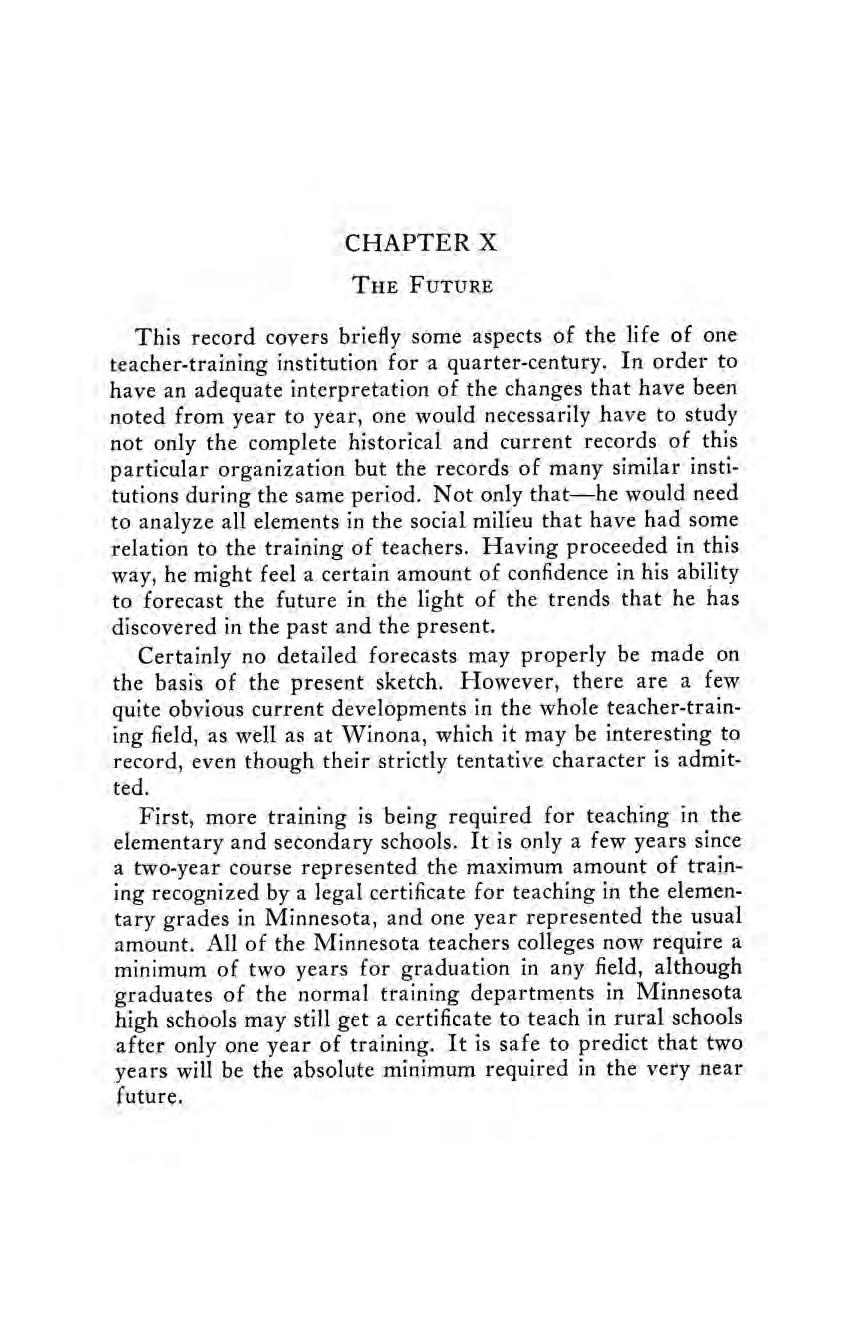
This record covers briefly some aspects of the life of one teacher-training institution for a quarter-century. In order to have an adequate interpretation of the changes that have been noted from year to year, one would necessarily have to study not only the complete historical and current records of this particular organization but the records of many similar institutions during the same period. Not only that—he would need to analyze all elements in the social milieu that have had some relation to the training of teachers. Having proceeded in this way, he might feel a certain amount of confidence in his ability to forecast the future in the light of the trends that he has discovered in the past and the present.
Certainly no detailed forecasts may properly be made on the basis of the present sketch. However, there are a few quite obvious current developments in the whole teacher-training field, as well as at Winona, which it may be interesting to record, even though their strictly tentative character is admitted.
First, more training is being required for teaching in the elementary and secondary schools. It is only a few years since a two-year course represented the maximum amount of training recognized by a legal certificate for teaching in the elementary grades in Minnesota, and one year represented the usual amount. All of the Minnesota teachers colleges now require a minimum of two years for graduation in any field, although graduates of the normal training departments in Minnesota high schools may still get a certificate to teach in rural schools after only one year of training. It is safe to predict that two years will be the absolute minimum required in the very near future.
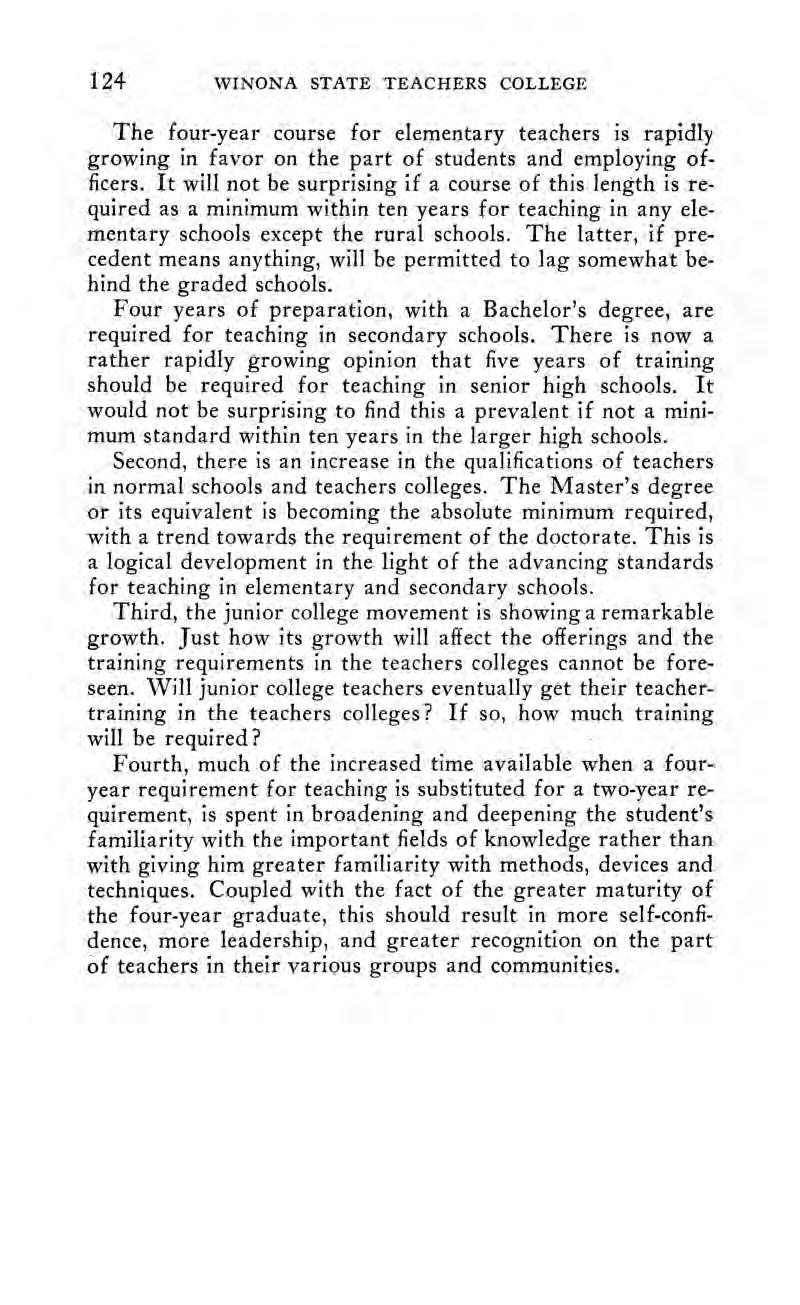
The four-year course for elementary teachers is rapidly growing in favor on the part of students and employing officers. It will not be surprising if a course of this length is required as a minimum within ten years for teaching in any elementary schools except the rural schools. The latter, if precedent means anything, will be permitted to lag somewhat behind the graded schools.
Four years of preparation, with a Bachelor’s degree, are required for teaching in secondary schools. There is now a rather rapidly growing opinion that five years of training should be required for teaching in senior high schools. It would not be surprising to find this a prevalent if not a minimum standard within ten years in the larger high schools.
Second, there is an increase in the qualifications of teachers in normal schools andteachers colleges. The Master’s degree or its equivalent is becoming the absolute minimum required, with a trend towards the requirement of the doctorate. This is a logical development in the light of the advancing standards for teaching in elementary and secondary schools.
Third, the junior college movement is showinga remarkable growth. Just how its growth will affect the offerings and the training requirements in the teachers colleges cannot be foreseen. Will junior college teachers eventually get their teachertraining in the teachers colleges? If so, how much training will be required?
Fourth, much of the increased time available when a fouryear requirement for teaching is substituted for a two-year requirement, is spent in broadening and deepening the student’s familiarity with the important fields of knowledge rather than with giving him greater familiarity with methods, devicesand techniques. Coupled with the fact of the greater maturity of the four-year graduate, this should result in more self-confidence, more leadership, and greater recognition on the part of teachers in their various groups and communities.
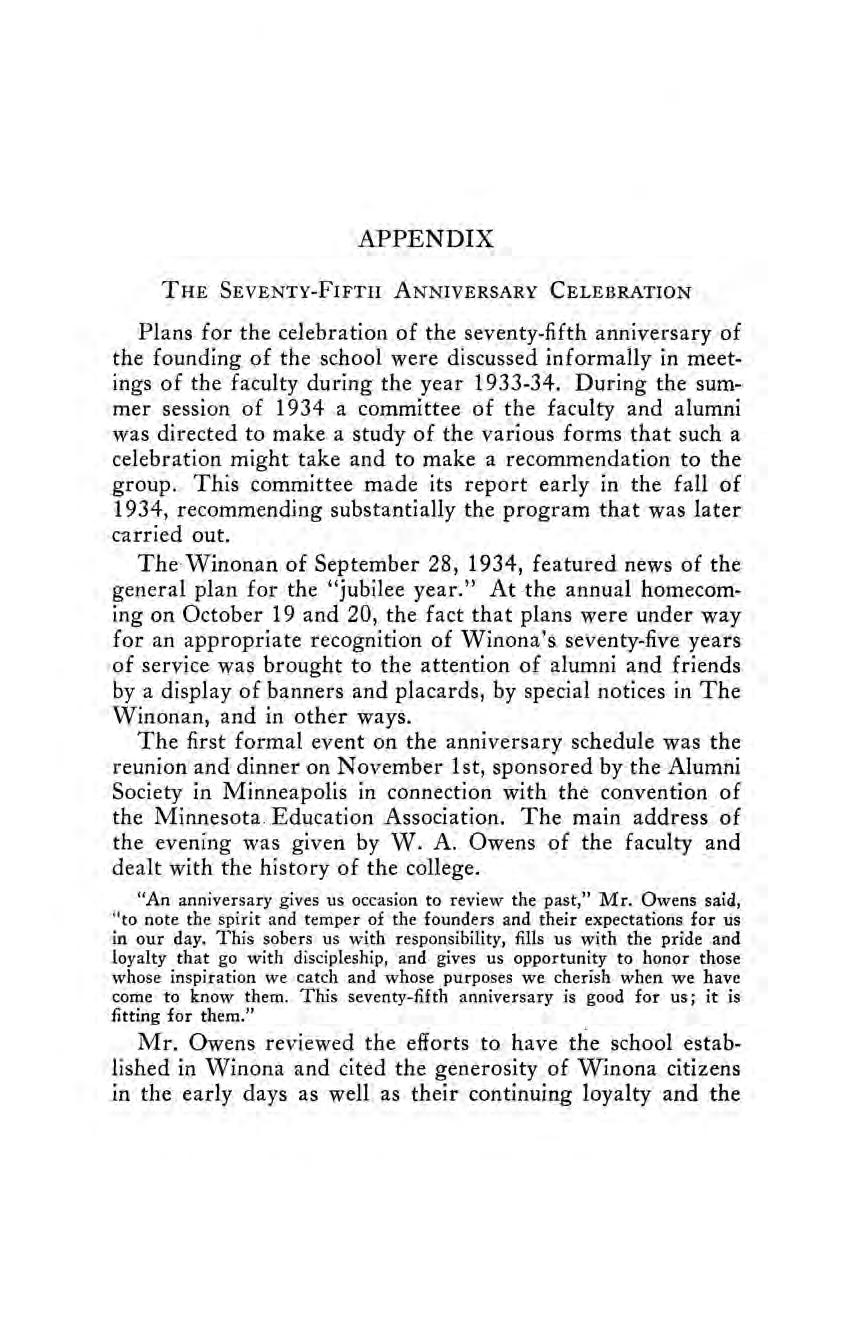
Plans for the celebration of the seventy-fifth anniversary of the founding of the school were discussed informally in meetings of the faculty during the year 1933-34. During the summer session of 1934 a committee of the faculty and alumni was directed to make a study of the various forms that such a celebration might take and to make a recommendation to the group. This committee made its report early in the fall of 1934, recommending substantially the program that was later carried out.
The Winonan of September 28, 1934, featured news of the general plan for the “jubilee year.” At the annual homecoming on October 19 and 20, the fact that plans were under way for an appropriate recognition of Winona’s seventy-five years of service was brought to the attention of alumni and friends by a display of banners and placards, by special notices in The Winonan, and in other ways.
The first formal event on the anniversary schedule was the reunion and dinner on November Ist, sponsored by the Alumni Society in Minneapolis in connection with the convention of the Minnesota. Education Association. The main address of the evening was given by W. A. Owens of the faculty and dealt with the history of the college.
“An anniversary gives us occasion to review the past,” Mr. Owens said, “to note the spirit and temper of the founders and their expectations for us in our day. This sobers us with responsibility, fills us with the pride and loyalty that go with discipleship, and gives us opportunity to honor those whose inspiration we catch and whose purposes we cherish when we have come to know them. This seventy-fifth anniversary is good for us; it is fitting for them.”
Mr. Owens reviewed the efforts to have the school established in Winona and cited the generosity of Winona citizens in the early days as well as their continuing loyalty and the
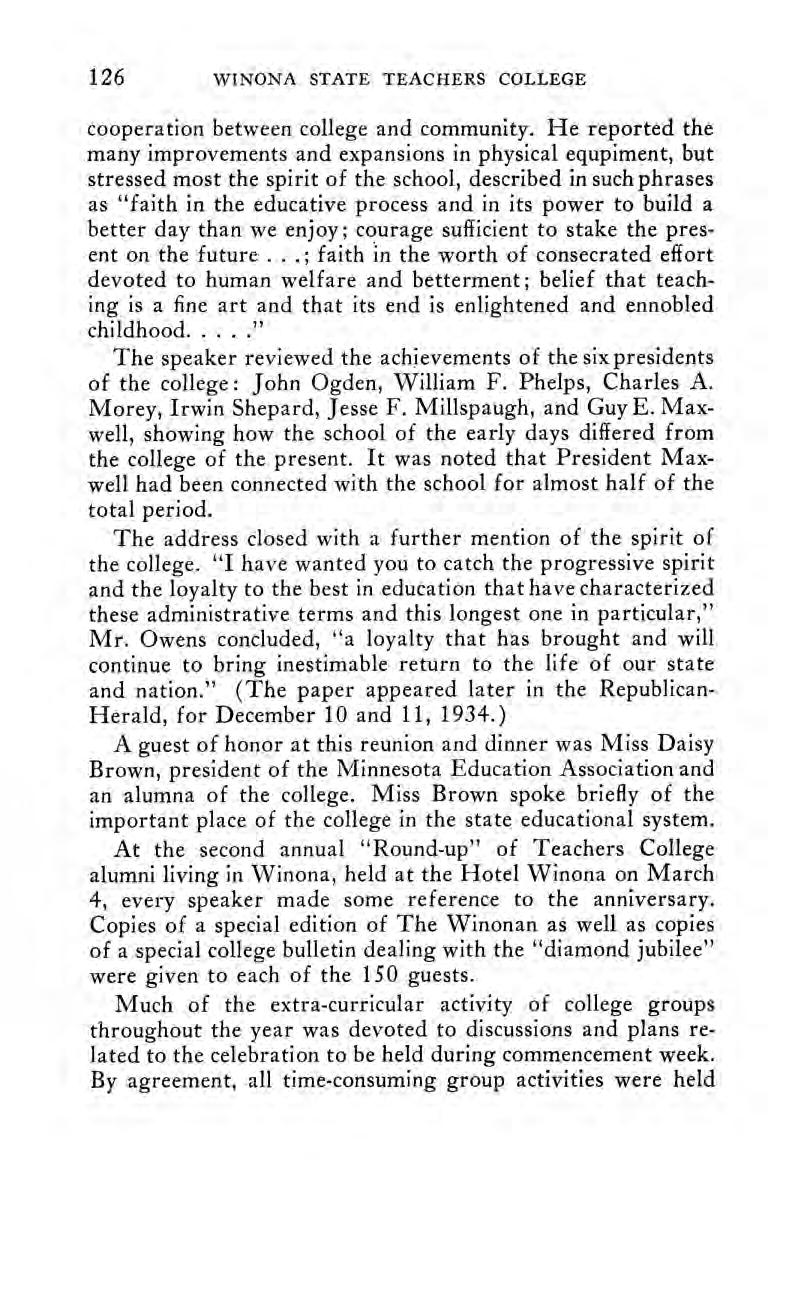
cooperation between college and community. He reported the many improvements and expansions in physical equpiment, but stressed most the spirit of the school, describedin such phrases as ‘‘faith in the educative process and in its power to build a better day than we enjoy; courage sufficient to stake the present on the future ..; faith inthe worth of consecrated effort devoted to human welfare and betterment; belief that teaching is a fine art and that its end is enlightened and ennobled childhood.
The speaker reviewed the achievements of the six presidents of the college: John Ogden, William F. Phelps, Charles A. Morey, Irwin Shepard, Jesse F. Millspaugh, and Guy E. Maxwell, showing how theschool of the early days differed from the college of the present. It was noted that President Maxwell had been connected with the school for almost half of the total period.
The address closed with a further mention of the spirit of the college. “I have wanted you to catch the progressive spirit and the loyalty to the best in education that have characterized these administrative terms and this longest one in particular,”’ Mr. Owens concluded, ‘‘a loyalty that has brought and will continue to bring inestimable return to the life of our state and nation.” (The paper appeared later in the RepublicanHerald, for December 10 and 11, 1934.)
A guest of honor at this reunion and dinner was Miss Daisy Brown, president of the Minnesota Education Association and an alumna of the college. Miss Brown spoke briefly of the important place of the college in the state educational system.
At the second annual ‘‘Round-up” of Teachers College alumni living in Winona, held at the Hotel Winona on March 4, every speaker made some reference to the anniversary. Copies of a special edition of The Winonan as well as copies ofa special college bulletin dealing with the “diamond jubilee” were given to each of the 150 guests.
Much of the extra-curricular activity of college groups throughout the year was devoted to discussions and plans related to the celebration to be held during commencement week. By agreement, all time-consuming group activities were held

at such times during the year as not to conflict with the preparations for the anniversary pageant.
Events which resulted in making faculty and students quite ‘‘anniversary-conscious” occurred frequently. Almost every week, at assembly, an announcement concerning some phase of the celebration was made: committee personnel and function, reports of progress on the part of committees, appeals for volunteers to aid in special preparations, schedules of try-outs for places in the cast, and eventually schedules of rehearsals.
Every issue of the college paper carried news items concerning some of the plans and activities related to the celebration. The staff of The Wenonah, college ‘‘annual,’”’ announced that its theme would be the anniversary.
The general public, as well as alumni and friends of the college, had the celebration called to its attention by news items in local and state newspapers and by the wide distribution of a college bulletin in the spring, containing a detailed announcement of the events planned for the last week of the college year. All of the Minneapolis and St. Paul daily papers carried illustrated feature articles concerning the anniversary, three or four weeks in advance of the scheduled events. The Winona Republican-Herald published a beautiful, 32-page Teachers College supplement on Wednesday, June 5, 1935.
GENERAL PROGRAM
SEVENTY-FIFTH ANNIVERSARY AND COMMENCEMENT WEEK
Fripay, May 31 tHroucH Fripay, JUNE 7, 1935
Friday 8:00 p.m. Phelps School Promotion
Saturday 8:00 p.m. TheAnnual “Prom”
Sunday 3:00 p.m. College Band, Lakeside Park
5:00 p.m. Dinner, Degree Graduates
8:00 p.m. Baccalaureate Sermon
Tuesday 8:15p.m. Memorial Organ Recital
Wednesday 9:00 a.m. College Board Meeting
2:30 p.m. Anniversary Program
8:15p.m. Pageant, Historical
Thursday 10:00a.m. Closing Assembly
5:00 p.m. Alumni Reunion and Dinner
8:15 p.m. Pageant (repeated)
Friday 10:00 a.m. Annual Commencement
2:30 p.m. Annual Meeting, Alumni Society
All Week 3:15 to05:00 Art Exhibit

The first event of commencement week was the junior high school promotion exercise on Friday evening, May 31. On the next evening occurred the annual “prom.” Ordinarily held in the early spring, this formal party was delayed until this time with the thought that it would provide opportunity for sociability on the part of alumni and friends of earlier days as well as for present members of the college.
On Sunday afternoon, June 2, the Teachers College Concert Band gave a ‘“‘diamond jubilee recital” at Lakeside Park, presenting the following program:
A COMPLIMENTARY PROGRAM FOR THE CITIZENS OF WINONA by the TEACHERS COLLEGECONCERT BAND
HaroLp AND Everett Epstrom, Directors Hall of Fame, Grand Marchi.......ccccesssssccssessseseeseseseeseecsassessencseesJ. Olivadoti Light Cavalry. Overture........ccscssssescesscssscesssssessecseesessssecsscssereeassagesF. V. Suppe Peer Gynt Suite... Edward Grieg
1. The Morning
2. Ase’s Death
3. Anitra’s Dance
4, In the Hall of the Mountain King Sounds from the Hudson...........ccccsscessesscesccssceseeseesecseesresseeesHerbert L. Clark Everett Edstrom, Cornet Solo
The Golden Dragon, Overture.......ccccccccsscssscssssscesscsecessessesscsseeseeeesK. L. King Tw Guitars oo.ccccccccsescssecescssssssessesseessseessecseecessseesesseseesseeesseesens Harry Horlick His Honor, Marchiy.....ccccssscsscsssescssssessccsccscenesssssesscesseeeseseeesHenry Fillmore Brass Quartette Numbers .......ccccccsecscssssssessesseseseeessecssteseesenessesaseaacesseass Selected Everett Edstrom, John Blatnik, Loran Jorris, William Bixby Finlandia, Tome Poem .i.ccccccccccccssscssscsscccssccssccsscesssesssecssesssesseeesscesscsaeeses Sibelius Norwegian Rhapsody F. Melius Christianson Winona Roser .......cccsccssccsscsssesssesccssscscessesesssscsecessesssstessnecsessarenees Julian Neville As arranged by Harold Edstrom
A crowd of about a thousand persons attended the concert. According to the Republican-Herald reporter, ‘“‘the band selections were uniformly well presented and the entire program was well balanced and well directed.” It was generally understood that this public, outdoor, commencement concert would be made an annual event.
The annual baccalaureate exercises were held in the college auditorium on Sunday evening, the sermon being preached by

Dr. Otto Baab, an alumnus of the college, professorof Old Testament interpretation in Garrett Biblical Institute, Evanston, Illinois. Dr. Baab spoke on the subject, “Education and the Kingdom of God.”’ The order of service was as follows:
Processional —‘Largo” Handel Miss Agnes Bard, Organist
Hymn —“Holy, Holy, Holy? vc ccsesesesssssesssssssessssesessssessssscresesse DVKes TmvOCation.......cccesccsccssccsscsseesssesssseesescssessecsaeessesseceseenseesesenseeeessRev. Paul Shannon
Chanting of Lord’s Prayer
“O, Give Thanks Unto God”....17th Century Old Ukranian Church Melody
“Hallelujah, Amen” from Judas Maccabaeus........cccsccscssessescseessssesseessHandel College Chorus Walter Grimm, Director
Hymn —“High In the Heavens, Eternal God” Lwoff Sermon by Dr. Baab
Hymn —‘Come Thou Almighty King’... ccesescsessseessesseseesssessees Giardini Benediction........cccsccssccssssessesscsscescnsscsesscesceeesascetcsecsesenestesetenseseeneesDr. S. H. Parish
Organ Postlude —“Fantasia, G Minor” Bach
As played by Joseph Bonnet
~The Winona Republican-Herald of the following day, as part of an extended account of the evening’s exercises, quoted and summarized parts of the sermon, as follows:
“What kind of a world is this?” asked the speaker. “For the first time a universal and social catastrophe faces men and women. There are certain social, international and economic conflicts going on.
“Students of history are quite certain that competitive armament races before 1914 was one of the great causes of the World war. However, today again a great budget is allowed for armaments. This world is facing universal disaster by the same route as in 1913.”
In speaking of the machine age of today, Dr. Baab stated, “This is a mechanical age in which speed makes us morally dizzy as well as physically dizzy. The machine has given to man a means of mechanical perfection, it has made the world incredibly compact. In other words, it has led to a ‘condensation of geography.’ And this ‘compactness of the physical world’ has had its effect on society in many ways.”
In describing the world of today the speaker said that this is a world that has certain unprecedented tendencies. Enlarging upon this idea, he brought out the fact that it is up to education and religion to regenerate and remould society.
“We are emerging from a great expanding period in education,” he continued. “This has occurred through two of the world’s great social catastrophes—the World war and the world depression. The aim of education is the regeneration and reconstructionof society and the individual—not the indoctrination of the “Three R’s.’ No longer can this kind of thing prepare people for this world.
“Religion and education must converge in their pathways. Ideas and the Kingdom of God are inherent in His teaching. Unless a person has social ideas he can not teach the Kingdom of God. Are you as teachers socially intelligent?”
Three necessities, the speaker said, are social intelligence, social imagination (the ability to dream dreams and carry them out), and social passion.
Next in the celebration was a musical program on Tuesday evening, June 4, featuring an organ recital by Mr. Emmett A. Raymond, an alumnus of the college. The program presented was as follows:
Mr. Emmett A. Raymonp, 1915, of St. Paul
Assisted by Miss JANET RotwepeErR, 1929 and the APOLLO AND MENDELSSOHN CLUBS
‘Tuesday Evening, in the Auditorium, at 8:15
Concert Prelude in D minod.....ccccscccsscsessesssessesscsssescsscsesesesA. Walter Kramer
Mr. Raymond
Lullaby wine ccscssesseetsesssssssseesscssecscscsssscssssssscsssseesessssvencecssssscsssessssesensess Brahms
Song in the Night... ccssscsscsscscsssscescsscsssscssssesesscsssescscsseseeeceses Loughborough
Solo by Miss Maizie Ahrens
Mendelssohn Club
Mr. Walter Grimm, Director
Gavotte Guilmant_
Sous les Bois......c.ccssssscssescssssessesssscecscsscssssesscssssessssseeessasssessessesssseseessseceaceasDurand
Mr. Raymond
Che Faro Senza Euridice........cccscsscsscsssssesscessssesssssessesscesestenesssceeesssessessesesGluck Miss Rohweder
The Angelus .......ccscsscccscssscsscssccsccsscesecscesssseessnessevsresaecssesnesseessesceeseeseeens Massenet
Mr. Raymond
Maiden, Such a Magic Lies... ‘Travers-Samuelson
Song of the Hunt (Old Warwickshire).........ccccscssssssssseccsscssesscscsesesenseseesCox Apollo Club
Miss Rohweder, Director
First Sonata for Organ ...c.ccsccccsscscsscsseresscssssessesseesesscssscssssssssssssseeeenss Borowski
Allegro ma non troppo
Andante
Allegro con fuoco
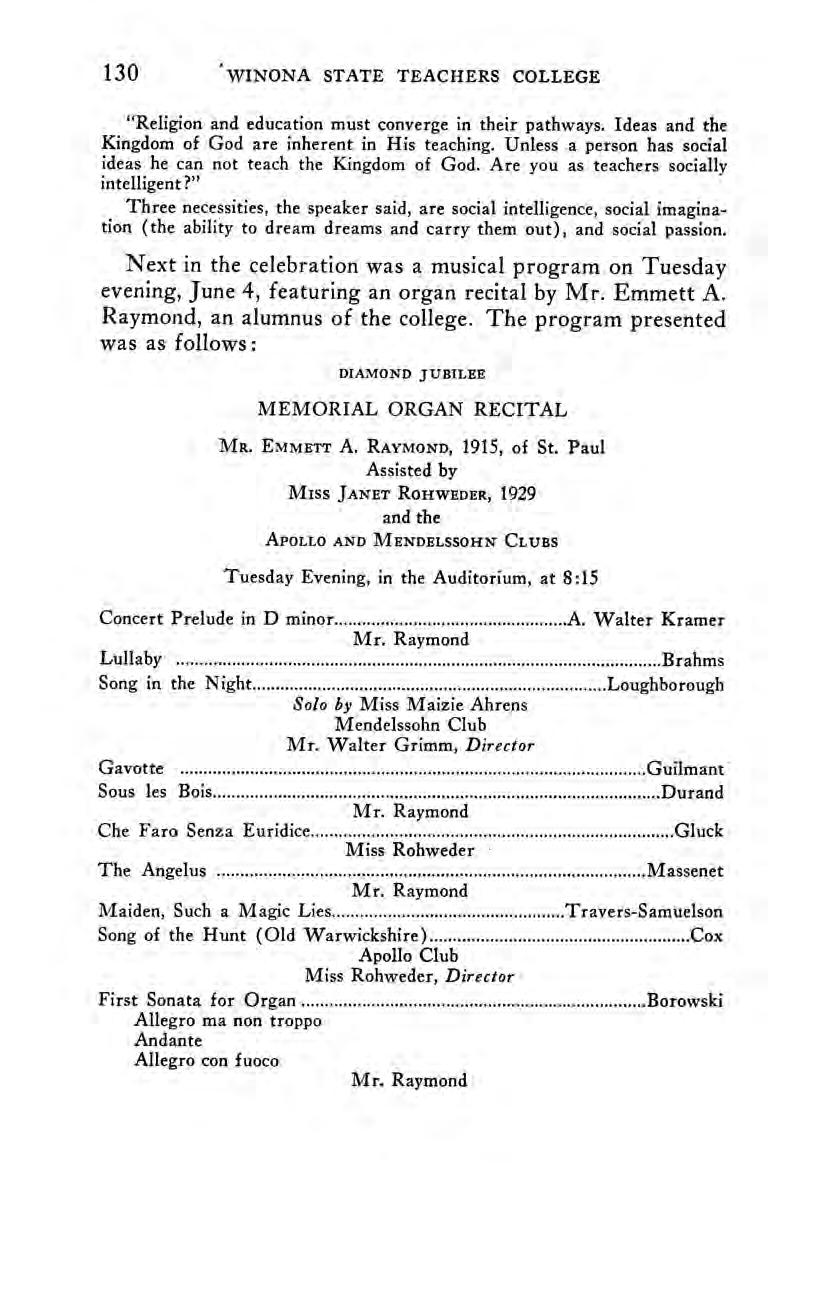
Mr. Raymond

During the forenoon of Wednesday, the State Teachers College Board held its annual meeting in College Hall, taking a recess at the time of assembly exercises in the auditorium. After the presidents and board members had been introduced to the student body by President Maxwell, Mr. H. J. McClearn, president of the board, gave a brief address, as did also President R. B. MacLean of the Moorhead college. Mr. MacLean stressed the possibility of finding the abundant life in simple things at home. He urged association with one’s self, with books, and with teachers.
The official memorial program in honor of the seventy-fifth anniversary was held on Wednesday afternoon, June 5. For the first time in the history of the Winona college an academic procession was formed, faculty members, degree graduates, special guests, and officials appearing in academic costume.
At the auditorium exercises, President Guy E. Maxwell presided. On the stage as guests of honor were the presidents of the other teachers colleges of the state, E. W. Bohannon of Duluth, M. W. Deputy of Bemidji, R. B. MacLean of Moorhead, G. A. Selke of St. Cloud, and F..D. McElroy of Man-. kato; members of the Teachers College Board, Mr. H. J. McClearn, (President of the board), Duluth, Dr. DeWitt Garlock, Bemidji, Dr. G. L. Gosslee, Moorhead, Mr. James J. Quigley, St. Cloud, Dr. F. A. Baker, Mankato, Mr. Frank A. Sheehan, Winona, Mr. Benjamin Drake, Minneapolis, and Dr. John G. Rockwell, state Commissioner of Education, ex officio secretary of the board, and special representative of Governor Floyd B. Olson at the anniversary program. Mr. L. J. Shields of St. Paul was the only absent member of the board.
Also seated on the stage as guests of honor were representatives of other Minnesota schools: Dr. Lotus D. Coffman, president of the University of Minnesota; Dr. Charles N. Pace, president of Hamline University; Brother Lawrence, St. Mary’s College; Dr. E. O. Ellingson, St. Olaf College; Mother M. Leo Tracy, Religious Superior, and Sister Mary Aloysius Molloy, President, College of St. Teresa; and Miss Georgina Lommen, representing the Minnesota teachers college faculties.

Other guests of honor were Bishop Francis M. Kelly, who gave the invocation, Miss Theda Gildemeister, 1935 commencement speaker, State Senator M. J. Galvin of Winona, and State Representative W. Kenneth Nissen of Winona.
Special recognition was also given to the members of the first degree class who were present: Miss Mabel Fifield of Winona, Mrs. Dorothy Rohweder Sorenson of Winona, and Superintendent C. E. Wedge, Murdock, Minnesota. *
The anniversary exercises were carried out as announced in the advance program printed below except that Governor Floyd B. Olson was unable to be present and Dr. J. G. Rockwell spoke for him. President Charles N. Pace spoke on behalfof the liberal arts colleges and incidentally for the church. Miss Georgina Lommen presented greetings on behalf of the Minnesota teachers college faculties. She also read formal congratulations and felicitations drafted and engraved by the Moorhead faculty.
“It is proper” said Dr. Rockwell in his brief address, “for people to meet together and publicly render fealty to the ideals symbolized in their institutions.
“The true worth of man can only be measured by the correct evaluation of his activities, and human activities, although complex, are, nevertheless, measurable in terms of social results. In the lonely, often tragic, and sometimes chaotic, progress of the individual through life certain things stand out clearly in the biography of every person. One simple, but unquestionable truth, in regard to human behavior is that no individual is quite content with either himself or his world. There is always present an eternal striving to change and improve. Life is not accepted as given and man’s natural, inborn, organized traits are not, in practical life, regarded as sufficiently reliable to meet all human needs. As a consequence, with incessant toil man is always busy trying to change his world and make it more agreeable for himself and the unborn generations which he knows will follow.
“Out of such ceaseless effort have been born our art, our science, our knowledge of health and disease, our abhorrence of man’s cruelty to man, typified by our growing horror of war—in fact, all that we prize in our culture. And as a primary instrumentality in this quest for a better set of ideals and correct ethical evaluation of motives, man has evolved the institution which we call education in order that that which he has discovered may not perish and may be preserved to function for his children.
“The wise, throughout time, have known that the ability to learn is a trait of inestimable value to people and that there derives from that source not only the elements of social organization which surround us, but likewise the ideals which, to no small degree, shape and direct our ‘conduct.
* The fourth member of this class, Mr. John Lynch of Lisbon, North Dakota, was unable to be present.
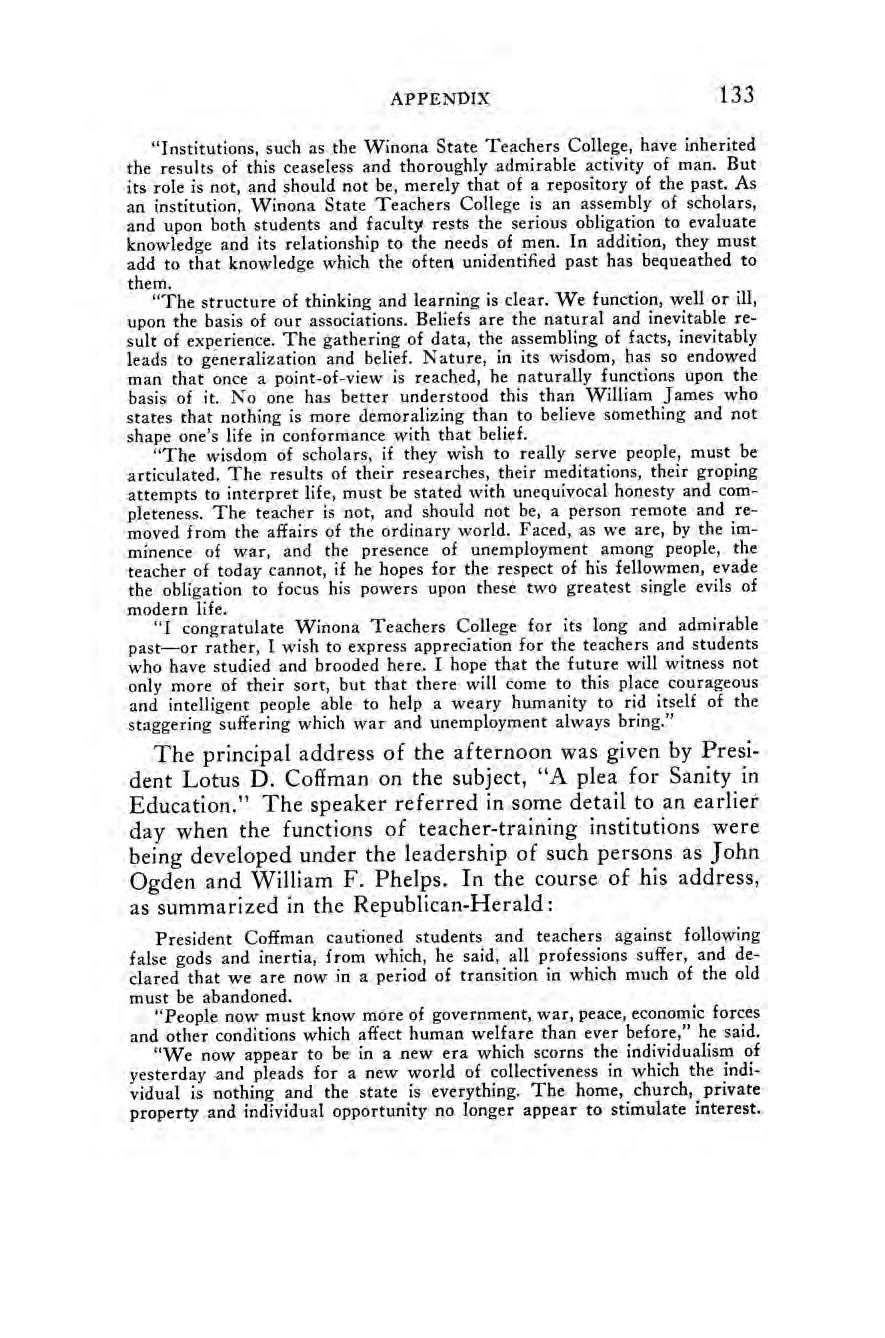
“Institutions, such as the Winona State Teachers College, have inherited the results of this ceaseless and thoroughly admirable activity of man. But its role is not, and should not be, merely that of a repository of the past. As an institution, Winona State Teachers College is an assembly of scholars, and upon both students and faculty rests the serious obligation to evaluate knowledge and its relationship to the needs of men. In addition, they must add to that knowledge which the ofteri unidentified past has bequeathed to them.
“The structure of thinking and learning is clear. We function, well or ill, upon the basis of our associations. Beliefs are the natural and inevitable result of experience. The gathering of data, the assembling of facts, inevitably leads to generalization and belief. Nature, in its wisdom, has so endowed man that once a point-of-view is reached, he naturally functions upon the basis of it. No one has better understood this than William James who states that nothing is more demoralizing than to believe something and not shape one’s life in conformance with that belief.
‘The wisdom of scholars, if they wish to really serve people, must be articulated. The results of their researches, their meditations, their groping attempts to interpret life, must be stated with unequivocal honesty and completeness. The teacher is not, and should not be, a person remote and removed from the affairs of the ordinary world. Faced, as we are, by the imminence of war, and the presence of unemployment among people, the teacher of today cannot, if he hopes for the respect of his fellowmen, evade the obligation to focus his powers upon these two greatest single evils of modern life.
“T congratulate Winona Teachers College for its long and admirable past—or rather, I wish to express appreciation for the teachers and students who have studied and brooded here. I hope that the future will witness not only more of their sort, but that there will come to this place courageous and intelligent people able to help a weary humanity to rid itself of the staggering suffering which war and unemployment always bring.”
The principal address of the afternoon was given by President Lotus D. Coffman on the subject, ‘“‘A plea for Sanity in Education.” The speaker referred in some detail to an earlier day when the functions of teacher-training institutions were being developed under the leadership of such persons as John Ogden and William F. Phelps. In the course of his address, as summarized in the Republican-Herald:
President Coffman cautioned students and teachers against following false gods and inertia, from which, he said, all professions suffer, and declared that we are now in a period of transition in which much of the old must be abandoned.
“People now must know more of government, war, peace, economic forces and other conditions which affect human welfare than ever before,” he said.
“We now appear to be in a new era which scorns the individualism of yesterday and pleads for a new world of collectiveness in which the individual is nothing and the state is everything. The home, church, private property and individual opportunity no longer appear to stimulate interest.

“The exploitation of the people in former years must never happen again but it appears that if people would work more they would have more liberty. There appears to be a willingness on the part of the people to sell their liberty for bread.
“Social progress is like a stream, now broad, now narrow, now fast and now slow, but always flowing.
“Lawyers now have become insurance men, doctors are public officials and teachers have become standard bearers for some new idea and as a result their work suffers. The best way for a professional person to help his fellows is by becoming a better lawyer, a better doctor and a better teacher.
“The administration of government calls for a specialized class. We have been governed too long by amateurs who maintain that anyone is able to fill an office. The people are being fooled now by a Moses from California, an Isaiah from Louisiana and a prophet from Michigan.”
Touching on the past, during which the Winona college was developed, President Coffman declared that foundations were then made with courage, hope and intelligence rather than through the administration of relief and by alphabetic schemes for recovery. The state just began its work, he said, when it established public schools.
Education, said the speaker, is for the purpose of attempting to liberate the human spirit and help it develop itself rather than primarily to make learning economical and easy, or for the teachers themselves or for the solution of social and other problems by others.
honor of THE
Wednesday Afternoon, in the Auditorium at 2:30
Processional, Largo...c..cscsscssssscssesscscsscscessecstscssnssersssesseeesensseessaseseaseessessenensHandel Miss Agnes Bard, Organist
Invocation
His Excellency the Most Reverend Francis M. Kelly, D. D. Bishop of Winona (The Audience Standing)
Introduction of Guests of Honor... cccsescseeeeeeees President G. E. Maxwell
Felicitation and Greetings
For the State.......cccccsscssscssccsesercsseeseesesssesenesseseeensGovernor: Floyd B. Olson
For education, for the church, by others.
The Nightingale ...ccccssesssssssssesscscsccssecssssscreesseesessnsssseeseenssaeeserses Tchaikowsky
The Elder Blossoms.....cccccssssscsscesscssnecssssccseccssseeesesserssssessecessesseesssesseeoessKopylow
The College Chorus
Mr. Walter Grimm, Director
Anniversary Address, “A Plea for Sanity in Education”
President Lotus D. Coffman, Ph. D. The University ofMinnesota
Choral Benediction, Maker of All Things... cesscceeeseetseeneteeeeees Fleming
(The Audience Standing)
Maker of all things, loving
Bless Thou our purpose, all Thy creatures, consecrate our labors; God of all goodness, Keep us still faithful to infinite in mercy, the best and truest; Changeless, eternal, holiest, Guide us, protect us, make and wisest, us not unworthy Hear thou Thy children. Humbly to praise Thee.
Recessional, Coronation March

—WALMSLEY
Meyerbeer Miss Agnes Bard
(The Audience remaining seated until close of recessional)
On Wednesday and Thursday evenings the historical pageant, ‘Seventy-five Years,” was presented. It consisted of a series of interesting and significant episodes, quite realistically reproducing events of importance in the history of the college and the state, from the coming of the Indians to the academic procession of anniversary week. By the use of narrators all episodes were woven together in such fashion as to produce a pleasing, convincing pageant of growth and constructive outlook. The printed outline and synopsis of scenes reproduced here will give some indication of the elaborate and fitting character of the undertaking. A capacity audience was present each evening.
“SEVENTY-FIVE
PRESENTED BY THE STUDENTS AND FACULTY OF THE COLLEGE
Wednesday and Thursday Evenings in the Auditorium at 8:15
Plot and Dialogue
Miss Helen Pendergast and Mr. Willis E. Boots Director
Mr. Henry C. Youngerman of Milwaukee, Wisconsin
PROLOGUE
An Indian Maiden laments the fateof her race, while the Pioneer Woman sees the coming of the white man, bringing education, culture, and prosperity to the valley.
Act I.— The Founding of the Normal School
The settlement of the village and the founding and early years of the Normal School are told in a series ofdramatic scenes brought toa climax by the coming of the Civil War.

Act II.— The Growth of the Normal School
Scenes here trace the early development of the school, the first graduation in 1866, a typical old-time school room, the coming of the second principal, and the laying of the corner stone for the first permanent building. The close of this act is marked by the meeting of the crisis which assured the continuation of the school and the Act of Legislation which promised support for the future. The narrator carries the plot through a long period of growth and development.
INTERLUDE
A Dance Drama which depicts the fire of 1922 and the rebirth of the college.
EPILOGUE
A panorama of history depicted through the presidents of the college, each expressing his ideals and ambitions and the changes which came in terms of curriculum, buildings, and personnel of the college. Typical students of the periods suggest the changing qualifications and preparation for teaching service. A final scene brings the wide field of service, the enriched curriculum and broader advantages of the present day into contrast with the past. An academic procession of faculty and graduating students symbolizes the teachers of the future moving onward to various fields of service, singing praise to Alma Mater.
Throughout the pageant a Narrator tells in detail the history of the school.
ProLoGuE: Foreshadowings.
Part OnE The Foresight of the Pioneers.
Scene 1.— Winona in 1858.
The river front. An afternoon in August.
ScENE 2.— Winona’s Pledge.
Same setting as Scene 1. Evening of the same day.
Part Two The Founding of Winona Normal School.
Scene 1.— The Opening of the School.
A room in the first Normal School building. September 3, 1860.
ScENE 2.— The Call to Arms. Street near the Normal School. 1861.
Intermission of five minutes. Orchestra.
Part THREE— The Realization of Permanency.
Scene 1.— The First Graduation. First Methodist Church. June 29, 1866.
ScENE 2.— The Laying of the Cornerstone. Present site of Teachers College. October 19, 1866.
Intermission of fivé minutes. Orchestra.
Part Four The Expansion of the Normal School.
SceNE 1.— The New View of Science. Classroom of Charles A. Morey. 1872.
ScENE 2.— The Crisis of 1876. A room in the home of Principal William Phelps. Evening.
Scene 3.— The First Kindergarten. Kindergarten Room in Normal School. A morning in September, 1881.
INTERLUDE: Dance of the Flames.
Epitocuge: The New Era.
The annual alumnireunion and dinner were held at Morey Hall on Thursday evening, beginning at five o’clock. An unusually large attendance and fine spirit were noted by all who were present. The following program was given:
Toastmaster....c..ccccccccsssesssscscsssscccesscssccesesssesscsssesecssssesPresident G. E. Maxwell
Welcome to Returning Alumni and the Graduates of 1935 Dr. R. B. LeMay, ’07, President of the Society
ReSPOMSE.........ccscessccsscesesesssceneeesMr. Lloyd Ambrosen, President, Class of ’35 College Songs....c..ccccsccsssccscssecscsestesseesessseseenesDirected by Mr. Walter Grimm
“Why We Remember’’.......cccsesssccecessesecesrsesseeeesssseneesMiss Daisy Brown, ’05 Ex-President of Minnesota Education Association
“Lest We Forget” ......ccccssssccsesscssccsesseesersseesees Miss Emily R. Kneubuhl, ’04
Executive Secretary of the National Business and Professional Women’s Clubs, Inc.
Reunion Song

Composed for one of the earliest class reunions.
From home and school, from far and near
Where e’er our feet may roam
Our Alma Mater calls again
Her scattered children home
What thronging sacred memories
Her ancient walls enshrine
Of friends we loved and joys we knew
In auld lang syne
Shall old acquaintance be forgot
And never brought to mind
Shall old acquaintance be forgot
And days of auld lang syne
For auld lang syne at school
For auld lang syne
We'll keep a thought of kindness yet
For auld lang syne.
And should we miss among the band
Some forms to memory dear They are not lost, we feel and know Their unseen presence near We feel that on this coming home
Some angel eyes may shine
Some eyes that met our own with love
In auld lang syne
Nore: Members of graduating classes are guests of the Society.
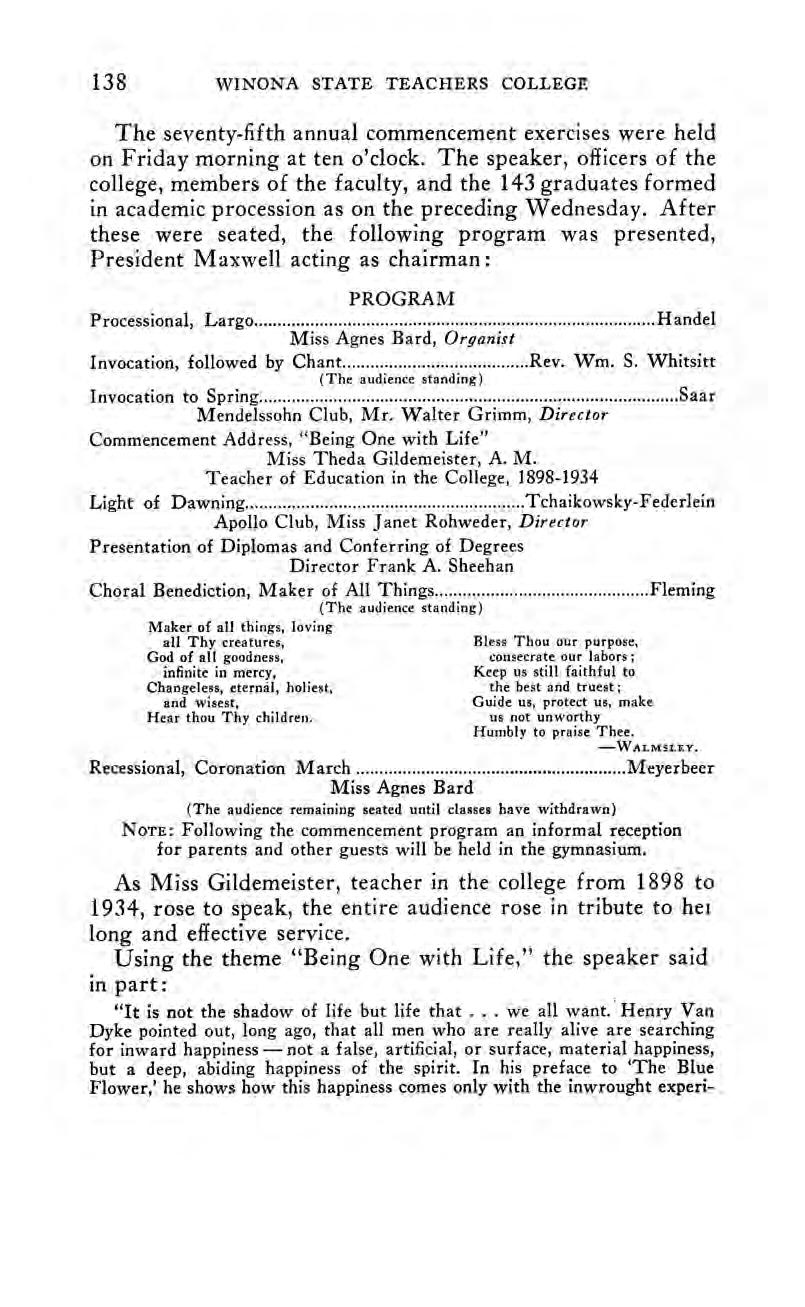
The seventy-fifth annual commencement exercises were held on Friday morning at ten o’clock. The speaker, officers of the college, members of the faculty, and the 143 graduates formed in academic procession as on the preceding Wednesday. After these were seated, the following program was presented, President Maxwell acting as chairman:
Processional, Largo.......scssccscssscesecesscecessseescessessseesesensaecsesssssseessesaessacessennenesHandel Miss Agnes Bard, Organist
Invocation, followed by Chant... ccc csscseseseesseceseees Rev. Wm. S. Whitsitt
(The audience standing)
Invocation to Sprimg....cccccccsscssssececcsececsessesesscesseeesesessesssseeseceseeeseaseacsesessessesenesSaar Mendelssohn Club, Mr. Walter Grimm, Director
Commencement Address, “Being One with Life”
Miss Theda Gildemeister, A. M. Teacher of Education in the College, 1898-1934
Light of Dawning..........ceeesseccssessesssecesesecnsesssessesareneesTchaikowsky-Federlein Apollo Club, Miss Janet Rohweder, Director
Presentation of Diplomas and Conferring of Degrees Director Frank A. Sheehan
Choral Benediction, Maker of All Things... cceccscseeceteeeeeeneeneenees Fleming
(The audience standing)
Maker of all things, loving all Thy creatures,
Bless Thou our purpose, God of all goodness, consecrate our labors; infinite in mercy, Keep us still faithful to Changeless, eternal, holiest, the best and truest; and wisest, Guide us, protect us, make Hear thou Thy children. us not unworthy Humbly to praise Thee. —WALMSLEY.
Recessional, Coronation March ........ccccsssccssssssssesescseetsessossnseeceneeeeses Meyerbeer Miss Agnes Bard
(The audience remaining seated until classes have withdrawn)
Nore: Following the commencement program an informal reception for parents and other guests will be held in the gymnasium.
As Miss Gildemeister, teacher in the college from 1898 to 1934, rose to speak, the entire audience rose in tribute to he1 long and effective service.
Using the theme ‘“‘Being One with Life,” the speaker said in part:
“Tt is not theshadow of life but life that... we all want. Henry Van Dyke pointed out, long ago, that all men who are really alive are searching for inward happiness not a false, artificial, or surface, material happiness, but a deep, abiding happiness of the spirit. In his preface to “The Blue Flower,’ he shows how this happiness comes only with the inwrought experi-

ence of living. Andthat is a thing which one cannot get in haste, neither can it be made to order. Patient waiting belongs to it; and rainy days belong to it; and the best of it sometimes comes in the doing of tasks that seem not to amount to much.
“We need specialists, but specialization must be built on a foundation of general experience. I greatly favor one’s being, first of all, a ‘Jack of all trades.’ The old adage which ends ‘and good at none’ may be true, but one has lots of fun when he can fit himself into numerous situations, get enjoyment from many types of recreation, or participate in novel situations because of his ingenuity (acquired through being a Jack of all trades and arts).
“T once spoke from this platform on ‘Mastering Life.’ Some of you doubtless, heard the talk. The passing years have forced home a changed attitude. While youth thinks most of mastering life, adulthood likes better to be a part of life. In fact, to be ‘one with life’ submission is as vital a trait to cultivate as is mastery. I am reminded here of Bergson’s illustration of the switching train which must go backward if it is to go forward on the new line of rails.
Some persons feel that to be one with life means experiencing everything new that comes along, everything that anyone else has tried or talks about. This means, then, that drinking, gambling, night clubs, must all be participated in if one is really to be one with life. To this attitude I am bitterly opposed—the world holds for its millions of inhabitants thousands of experiences that do not further life as I picture it.-
“Life implies rising from our baser selves, growth, the creative spirit, and these may be cut out of our lives by personal entrance into some of the sins against uplift or life. As one may be injured physically by carelessness of some type (We all have scars, but they do not add to our beauty!), so we may be maimed mentally or morally.
“Hence, if we would rise to our best selves, there are dangers to avoid: we must select the experiences which are life-giving, beautifying to character, enriching, fostering growth and creativeness.
“,.» Whatever you choose, check your choice as to its value by the reason you made it. Go to the bottom of your choices made by others. That is, seek truth above all, and work for disclosure of truth. If the carrying out of your desire leads to a higher self, you have chosen wisely.
“With a background of direct experience, coupled with sensitivity,imagination, and self-giving, one can gain more valuable experiences vicariously than he could ever secure by.personal direct experience alone. Man alone has the divine gift of imagination which lets him put himself in another’s place and thereby learn.
“.. To reap a full harvest, you must give yourself freely to whatever undertaking you select as of value. Unless you give yourself unstintedly to the project, you fail to grow. If you are saving your clothes at a picnic, you miss a lot of fun. If you fear to soil your hands, your garden does not yield all it might. In fact, if you are stingy of materials, of time, of energy, of thought, of self, the result is imperfect.
And now do you ask me what lines may be chosen with assurance that new and real life will result from participation therein? I could enumerate
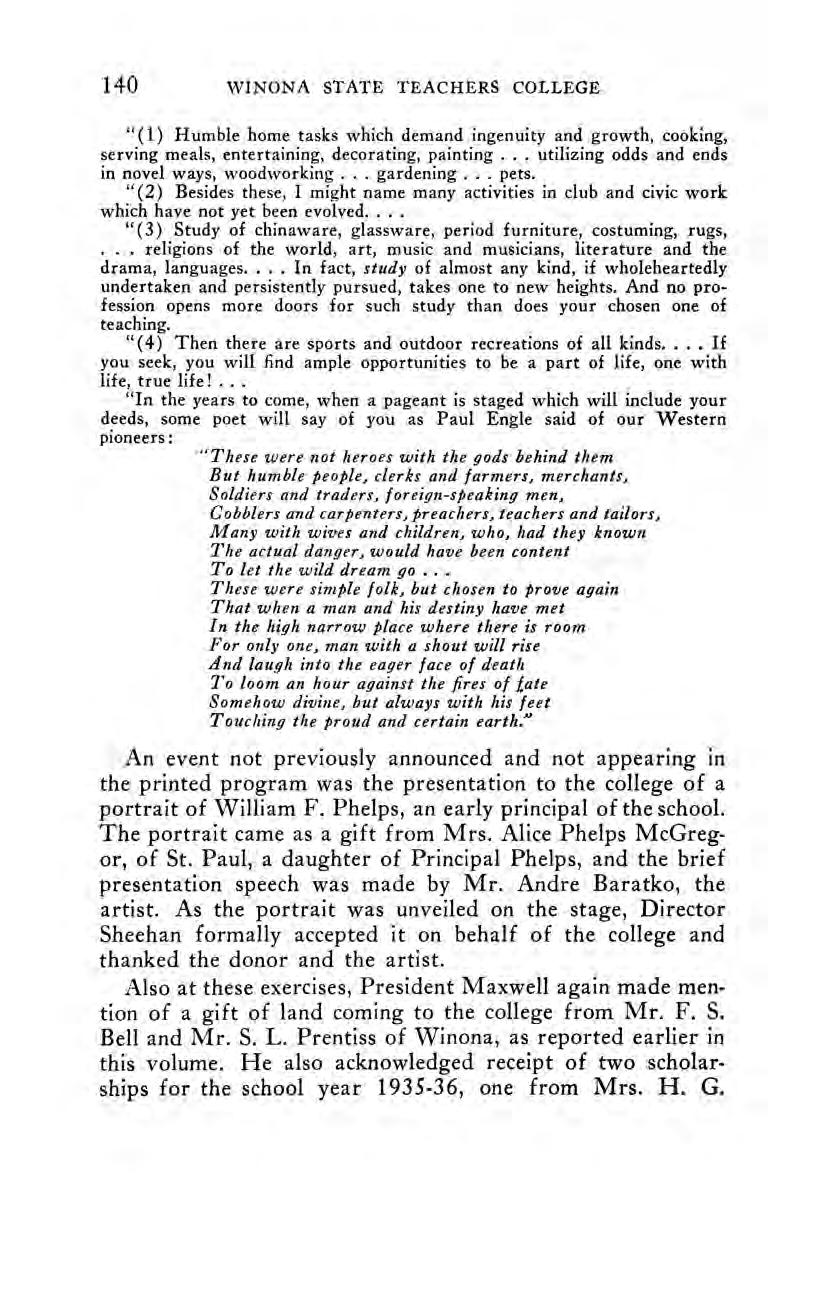
“(1) Humble home tasks which demand ingenuity and growth, cooking, serving meals, entertaining, decorating, painting utilizing odds and ends in novel ways, woodworking gardening. pets.
“(2) Besides these, I might name many activities in club and civic work which have not yet been evolved.
“(3) Study of chinaware, glassware, period furniture, costuming, rugs, religions of the world, art, music and musicians, literature and the drama, languages. In fact, study of almost any kind, if wholeheartedly undertaken and persistently pursued, takes one to new heights. And no profession opens more doors for such study than does your chosen one of teaching.
‘“‘(4) Then there are sports and outdoor recreations of all kinds... If you seek, you will find ample opportunities to be a part of life, one with life, true life!
“In the years to come, when a pageant is staged which will include your deeds, some poet will say of you as Paul Engle said of our Western pioneers:
“These were not heroes with the gods behind them But humble people, clerks and farmers, merchants, Soldiers and traders, foreign-speaking men, Cobblers and carpenters, preachers, teachers and tailors, Many with wives and children, who, had they known The actual danger, would have been content To let the wild dream go These were simple folk, but chosen to prove again That when a man and his destiny have met In the high narrow place where there is room For only one, man with a shout will rise And laugh into the eager face of death To loom an hour against the fires of fate Somehow divine, but always with his feet Touching the proud and certain earth.”
An event not previously announcedand not appearing in the printed program was the presentation to the college of a portrait of William F. Phelps, an early principal of the school. The portrait came as a gift from Mrs. Alice Phelps McGregor, of St. Paul, a daughter of Principal Phelps, and the brief presentation speech was made by Mr. Andre Baratko, the artist. As the portrait was unveiled on the stage, Director Sheehan formally accepted it on behalf of the college and thanked the donor and the artist.
Also at these exercises, President Maxwell again made mention of a gift of land coming to the college from Mr. F. S. Bell and Mr. S. L. Prentiss of Winona, as reported earlier in this volume. He also acknowledged receipt of two scholarships for the school year 1935-36, one from Mrs. H. G.

White, the other from Mrs. D. R. Mead. He announced two additions to the kindergarten scholarship fund. He spoke briefly in appreciation of the loyalty and generosity of the people of Winona throughout the 75-year history of the school.
In awarding the diplomas and degrees, Mr. F. A. Sheehan, resident director, expressed gratification that Miss Gildemeister’s address carried no undertone of fear, discouragement or frustration calculated to give graduates a feeling that they were going out into a world meager in opportunities.
‘You have been enjoying opportunities right up to the present moment,” he told the graduates, ‘‘and you have demonstrated by the very fact that you are graduating that you have the ability to take advantage of opportunities. Surely your common sense will tell you that far greater opportunities lie ahead.”’
Of the 143 graduates, 55 were awarded the degree, Bachelor of Education, and 88 received the two-year diploma.
The meeting of the Alumni Society on Friday afternoon at 2:30 was the last event of the anniversary week’s activities. The society transacted routine business and took action looking toward securing satisfactory storage and display space for historical materials contributed in considerable quantities by alumni and friends of the college. It was reported that one of the most enjoyable features of the anniversary celebration was the display of pictures, programs, diplomas, news clippings, text books, clothing, and other materials of an earlier day, all as arranged by the society in the “conference room,” a room which will probably be called the “alumni room” from thistime on.
A feature that was of interest to many visitors during commencement week was the exhibit of the work done by students in the art department during the year.
Governor Floyd B. Olson was unable to be present at the anniversary exercises. He delegated the state commissioner of education, Dr. John Gunderson Rockwell, to represent him at the formal recognition meeting on Wednesday afternoon of commencement week. In addition, he contributed the following statement for publication in the anniversary number of the Winona Republican-Herald.

By Governor Fioyp B. Oxson
“It is a privilege to greet and to congratulate Winona State Teachers College upon its 75th Anniversary. Minnesota was admitted into the Union as a state in 1858. Winona State Teachers College was opened in 1860. Its term of service therefore spans nearly the whole period of Minnesota’s existence asa commonwealth. It was the first of the state teachers colleges to be established in Minnesota.
“Seventy-five years is not considered old in these days, but in view of the rapidity of modern changes, this length of time is highly significant. During this period Minnesota has passed from Indian territory, dotted with tepees and wigwams, to a highly industrialized state of about three million people. Winona State Teachers College, located in your beautiful and romantic city of Winona, has actively and creatively participated in this great cultural transformation.
“Today as never before, teachers occupy a very strategic and crucial position. We live in what John Dewey, the great educator and philosopher, calls contradictory, paradoxical times. Any one inclined to be logical must be frequently puzzled and bewildered.
“For example, we live in a period when a super-abundance is produced, yet purchasing power is greatly restricted. There are potential great surpluses of products and yet hundreds of men and women are on relief and can hardly get enough to satisfy basic needs. It is a time of huge philanthropies and of colossal greed, of great fortunes and of widespread indigence. Banks are full of money and yet the terms of borrowing are stringent. There is much work crying to be done, and yet millions are idle. This spring graduates will pour out of our colleges and universities by the thousands, and yet many of them will be unable to find employment. In the midstof affluence there is insecurity, want and enforced idleness. Truly, the times are paradoxical.
“Unquestionably, our pioneer period is behind us. In this sense we are at the end of an era. Society is moving in new directions. The pendulum is swinging from extreme individualism toward some form of a more collective life. Powerful forces are operative and critical decisions must be made. New horizons open, and expanded vistas beckon.
“Obviously, teachers cannot be blind to these changes and problems. What can logically and fairly be expected of teachers in these times? It seems to me that they should be aware of the world in which we live. They should know enough of its past to distinguish and discriminate between the fleeting and permanent, the valuable and the shoddy, the excellent and the mediocre, the forward-looking, and the backward-looking.
“Education must ever open the doors of opportunity to the poor as well as to the rich; to the under-privileged as well as to the privileged; to the average person as well as the exceptional and the genius.

“It is equally obvious that our schools can no longer be satisfied with educating merely for individual success or achievement. Their purpose must be social rather than individualistic. Their highest aim is to make good citizens and not merely successful business men, clever specialists, or daring exploiters. In the past, education has shared the individual emphasis of a Pioneer society. Now that the United States has come of age, education needs to be surcharged with the social spirit.
“Tf teachers are really aware of their times, their main concern will be to know the truth and be courageous enough to declare it. In this new day will our teachers be followers or leaders? This is the challenge which now comes to them and it is vastly important that they lead wisely. One may say that the teachers of this country have its future in their hands, and important indeed is a college which trains teachers.
“It is with a deep realization of this responsibility which rests upon our educators that I extend congratulations and every good wish to the Winona State Teachers College.”
Among the many editorial felicitations appearing in the newspapers of Minnesota and the Northwest, none was more appropriate and none more genuine than that appearing in the special anniversary edition of The Winona Republican-Herald on June fifth. Under the heading, ‘“The Diamond Anniversary,’ the editor wrote as follows:
Winona and Minnesota join today in felicitations to an institution whose past of creation, development, rise to and continuation in a position of eminence and unending giving to the lives and welfare of the people is intimately associated with the histories of the community, the state and education.
For 75 years have the Winona State Teachers College, the community of Winona, the larger family of citizens constituting the state, and education moved forward abreast.
Winona was a small center when the idea of establishing its Normal School was conceived and carried to execution. Minnesota had been a state but 93 days when Governor Henry H. Sibley approved an act for establishment of the school “to educate and prepare teachers for teaching in the common schools of this state.”
From these beginnings grew the State Normal School of Winona, first institution west of the Mississippi river dedicated to preparation of teachers. This was a venture which caused the pioneer principal, John Ogden, to declare “She launches forth freighted with the dearest hopes, the earnest prayers, and the highest ambition of the leading minds of the great and free people of the Northwest.”
Winona and the Normal School, known later as the Teachers College, have grown side by side. High standards, able leadership, have expanded the institution’s influence, just as the foresight and devotion of citizens have
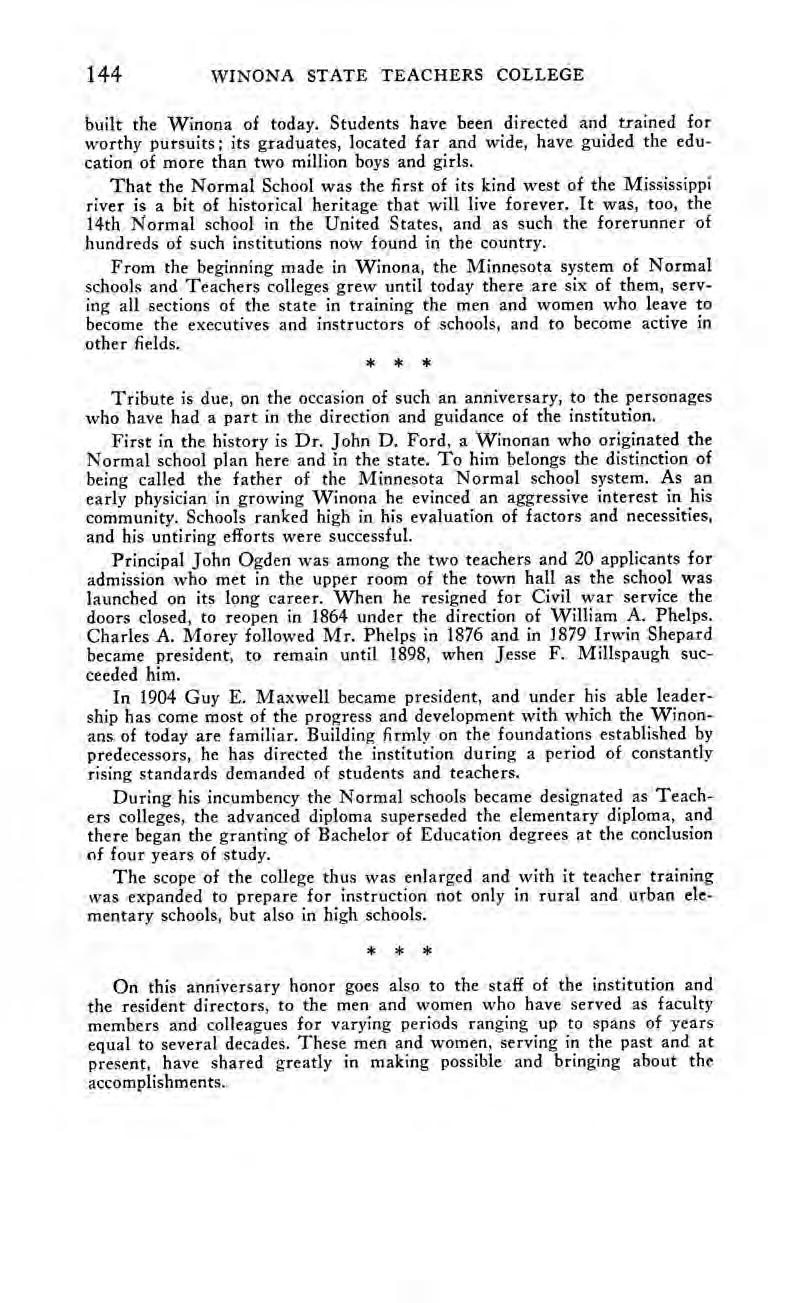
built the Winona of today. Students have been directed and trained for worthy pursuits; its graduates, located far and wide, have guided the education of more than two million boys and girls.
That the Normal School was the first of its kind west of the Mississippi river is a bit of historical heritage that will live forever. It was, too, the 14th Normal school in the United States, and as such the forerunner of hundreds of such institutions now found in the country.
From the beginning made in Winona, the Minnesota system of Normal schools and Teachers colleges grew until today there are six of them, serving all sections of the state in training the men and women who leave to become the executives and instructors of schools, and to become active in other fields.
Tribute is due, on the occasion of such an anniversary, to the personages who have had a part in the direction and guidance of the institution.
First in the history is Dr. John D. Ford, a Winonan who originated the Normal school plan here and in the state. To him belongs the distinction of being called the father of the Minnesota Normal school system. As an early physician in growing Winona he evinced an aggressive interest in his community. Schools ranked high in his evaluation of factors and necessities, and his untiring efforts were successful.
Principal John Ogden was among the two teachers and 20 applicants for admission who met in the upper room of the town hall as the school was launched on its long career. When he resigned for Civil war service the doors closed, to reopen in 1864 under the direction of William A. Phelps. Charles A. Morey followed Mr. Phelps in 1876 and in 1879 Irwin Shepard became president, to remain until 1898, when Jesse F. Millspaugh succeeded him.
In 1904 Guy E. Maxwell became president, and under his able leadership has come most of the progress and development with which the Winonans of today are familiar. Building firmly on the foundations established by predecessors, he has directed the institution during a period of constantly rising standards demanded of students and teachers.
During his incumbency the Normal schools became designated as Teachers colleges, the advanced diploma superseded the elementary diploma, and there began the granting of Bachelor of Education degrees at the conclusion of four years of study.
The scope of the college thus was enlarged and with it teacher training was expanded to prepare for instruction not only in rural and urban elementary schools, but also in high schools. * ok*
On this anniversary honor goes also to the staffof the institution and the resident directors, to the men and women who have served as faculty members and colleagues for varying periods ranging up to spans of years equal to several decades. These men and women, serving in the past and at present, have shared greatly in making possible and bringing about the accomplishments.
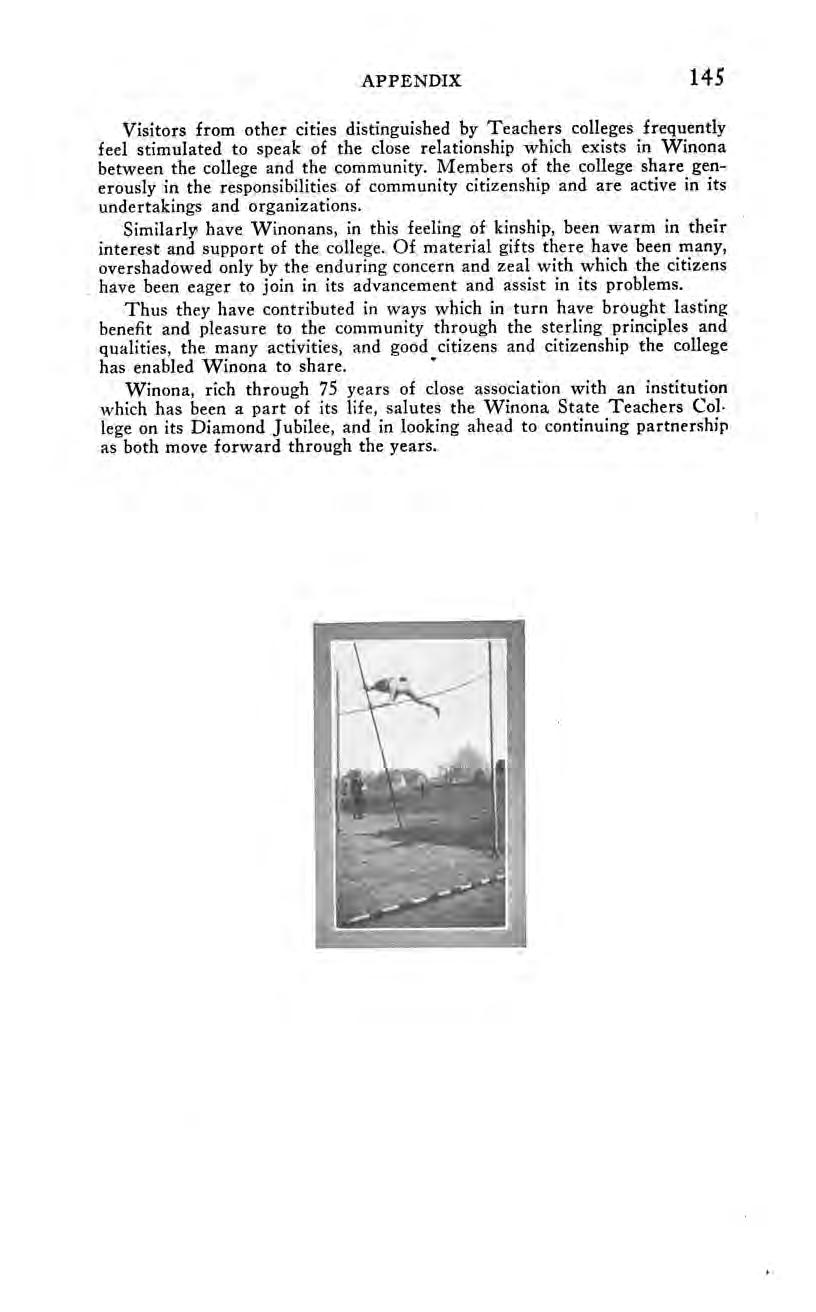
Visitors from other cities distinguished by Teachers colleges frequently feel stimulated to speak of the close relationship which exists in Winona between the college and the community. Members of the college share generously in the responsibilities of community citizenship and are active in its undertakings and organizations.
Similarly have Winonans, in this feeling of kinship, been warm in their interest and support of the college. Of material gifts there have been many, overshadowed only by the enduring concern and zeal with which the citizens have been eager to join in its advancement and assist in its problems.
Thus they have contributed in ways which in turn have brought lasting benefit and pleasure to the community through the sterling principles and qualities, the many activities, and good citizens and citizenship the college has enabled Winona to share.
Winona, rich through 75 years of close association with an institution which has been a part of its life, salutes the Winona State Teachers College on its Diamond Jubilee, and in looking ahead to continuing partnership as both move forward through the years.
1910
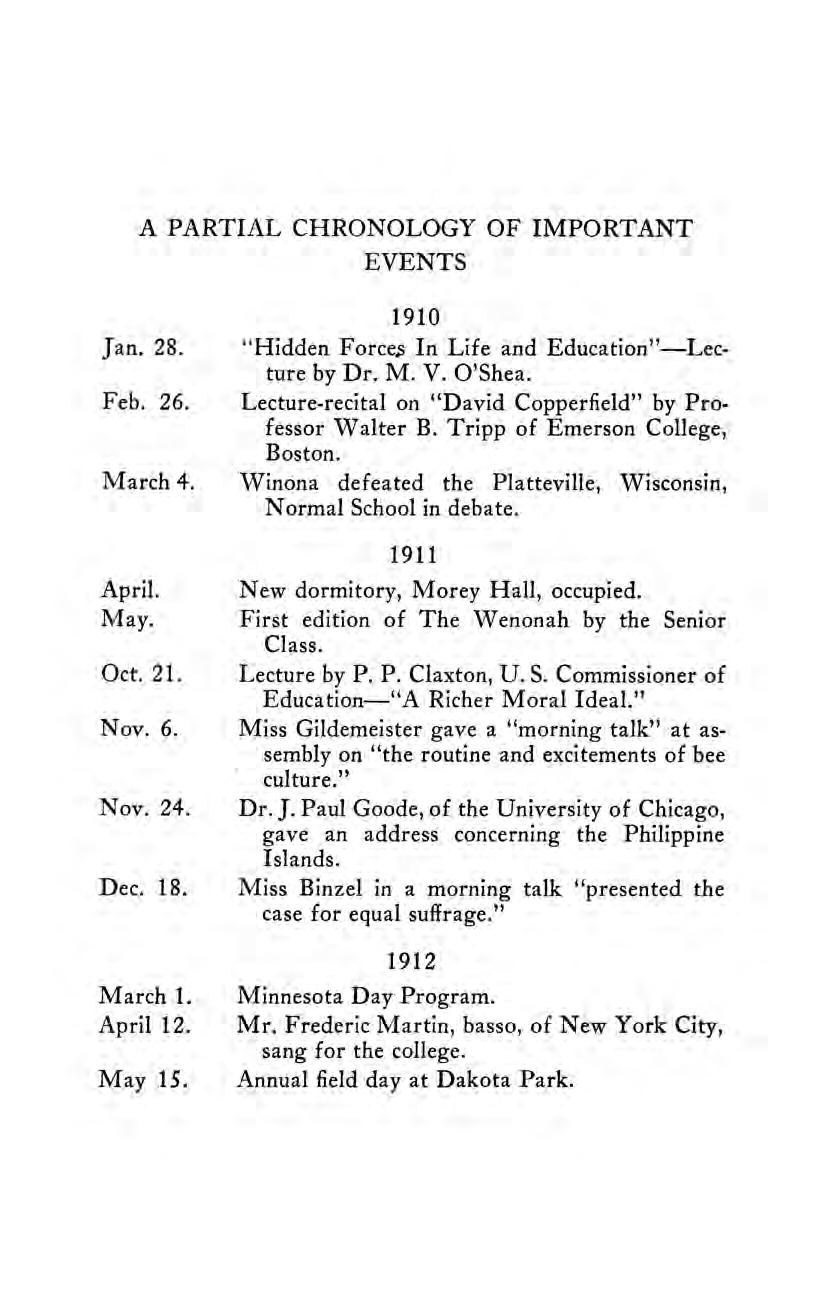
Jan. 28.
Feb. 26.
March 4.
“Hidden Forces In Life and Education” —Lecture by Dr. M. V. O’Shea.
Lecture-recital on “David Copperfield” by Professor Walter B. Tripp of Emerson College, Boston.
Winona defeated the Platteville, Wisconsin, Normal School in debate.
1911
April.
May.
Oct. 21.
Nov. 6.
Nov. 24.
New dormitory, Morey Hall, occupied. First edition of The Wenonah by the Senior Class.
Lecture by P. P. Claxton, U.S. Commissioner of Education—“A Richer Moral Ideal.”
Miss Gildemeister gave a ‘“‘morning talk” at assembly on “‘the routine and excitements of bee culture.”
Dr. J. Paul Goode, of the University of Chicago, gave an address concerning the Philippine Islands.
Dec. 18.
March 1.
April 12.
May 15.
Miss Binzel in a morning talk “presented the case for equal suffrage.”
1912
Minnesota Day Program.
Mr. Frederic Martin, basso, of New York City, sang for the college.
Annual field day at Dakota Park.
May 20.
May 24.
June 7.
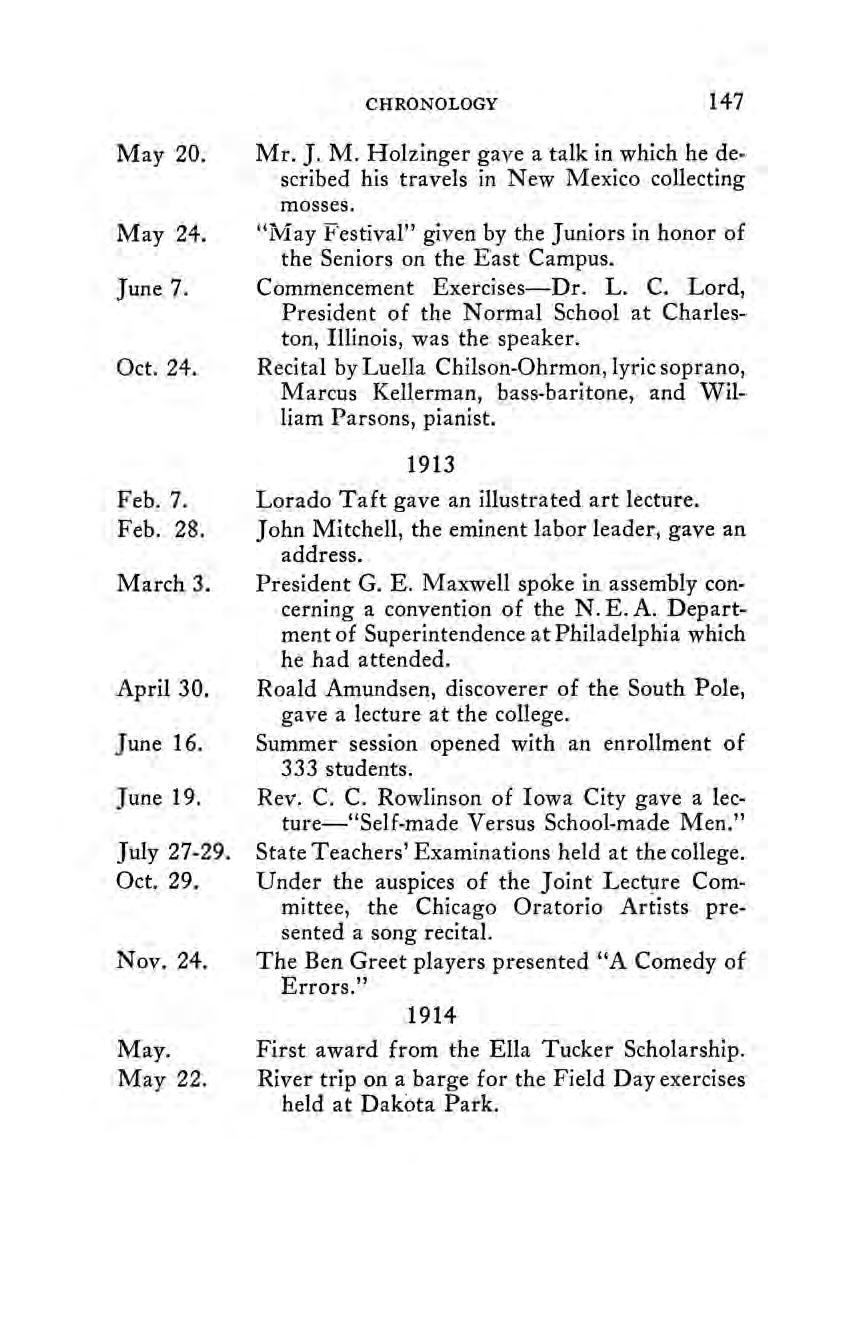
Oct. 24.
Mr. J. M. Holzinger gave a talk in which he described his travels in New Mexico collecting mosses.
“May Festival” given by the Juniors in honor of the Seniors on the East Campus. Commencement Exercises—Dr. L. C. Lord, President of the Normal School at Charleston, Illinois, was the speaker. Recital by Luella Chilson-Ohrmon, lyric soprano, Marcus Kellerman, bass-baritone, and William Parsons, pianist.
Feb. 7.
Feb. 28.
March 3.
April 30.
June 16.
June 19.
July 27-29. Oct. 29.
Lorado Taft gave an illustrated art lecture. John Mitchell, the eminent labor leader, gave an address.
President G. E. Maxwell spoke in assembly concerning a convention of the N.E. A. Department of Superintendence at Philadelphia which he had attended.
Roald Amundsen, discoverer of the South Pole, gave a lecture at the college. Summer session opened with an enrollment of 333 students.
Rey. C. C. Rowlinson of Iowa City gave a lecture—‘‘Self-made Versus School-made Men.” State Teachers’ Examinations held at the college. Under the auspices of the Joint Lecture Committee, the Chicago Oratorio Artists presented a song recital.
Nov. 24.
May. May 22.
The Ben Greet players presented ““A Comedy of Errors.”
1914
First award from the Ella Tucker Scholarship. River trip on a barge for the Field Day exercises held at Dakota Park.
June 2.
June 3.
Dec. 2.
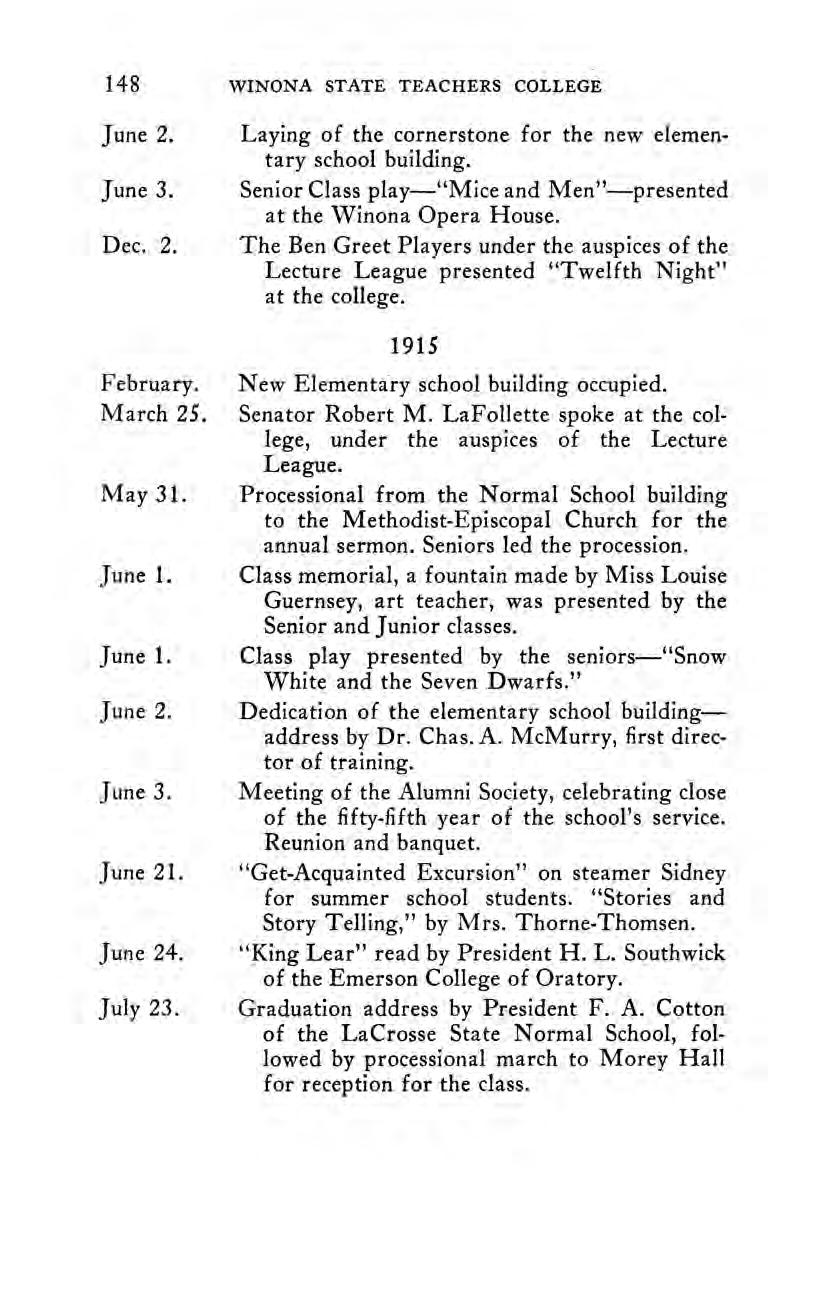
February.
March 25.
Laying of the cornerstone for the new elementary school building.
Senior Class play—‘“Mice and Men’’—presented at the Winona Opera House.
The Ben Greet Players under the auspices of the Lecture League presented ‘Twelfth Night” at the college.
New Elementary school building occupied.
Senator Robert M. LaFollette spoke at the college, under the auspices of the Lecture League.
May 31.
June 1.
June 1.
June 2.
June 3.
June 21.
June 24.
July 23.
Processional from the Normal School building to the Methodist-Episcopal Church for the annual sermon. Seniors led the procession.
Class memorial, a fountain made by Miss Louise Guernsey, art teacher, was presented by the Senior and Junior classes.
Class play presented by the seniors—‘Snow White and the Seven Dwarfs.”
Dedication of the elementary school building— address by Dr. Chas. A.McMurry, first director of training.
Meeting of the Alumni Society, celebrating close of the fifty-fifth year of the school’s service. Reunion and banquet.
‘‘Get-Acquainted Excursion’”’ on steamer Sidney for summer schoolstudents. ‘Stories and Story Telling,” by Mrs. Thorne-Thomsen.
“King Lear’ read by President H. L. Southwick of the Emerson College of Oratory.
Graduation address by PresidentF. A. Cotton of the LaCrosse State Normal School, followed by processional march to Morey Hall for reception for the class.
Nov. 22.
Dec. 3.

Jan. 4
March 31.
May 5.
May 30.
June 7.
June 9.
June 27.
July 4.
September
Oct. 1.
Oct. 27.
Oct. 29.
November.
Dec. 12.
April 25.
Dr. Wilfred T. Grenfell gave a lecture. Professor O’Neil of the University of Wisconsin gave a talk at chapel.
1916
Lecture by Alfred Noyes.
Address by President David Starr Jordan of Leland Stanford University.
Song recital by Frederic Martin.
Memorial services in honor of the late President Irwin Shepard.
Annual class play—Shakespeare’s ‘‘“A Midsummer Night’s Dream.”
Commencement address given by Dr. Richard Burton of the University of Minnesota. The Ben Greet Players presented ‘Romeo and Juliet.”
Patriotic program on the Campus, Honorable J. W. Murdock, orator.
Ninth grade added to the training school.
Illustrated lecture by Mr. Robert R. Reed— ‘Wonders of New York City.”
Winona State Normal School defeated Red Wing High School in football with a score of 74-0.
Walter Bradley Tripp of Boston read ‘The Taming of the Shrew.”
President F. A. Weld of Moorhead State Normal School lectured on “The Man from the Other Side.”
Lecture by Judge Marcus A. Kavanagh.
1917
Lecture by Dr. E. A. Steiner. (Lectures and recitals largely abandoned in favor of war activities. )
Feb. 17.

March 1.
March 15.
June.
June 25.
September.
1918
The “Messiah” of Handel was given bya student quartet supported by a chorus of two hundred student voices.
Winona Normal School defeated St. Cloud in basketball, thereby winning the state title.
Second Annual Elementary School Conference.
General assembly—lectures given on food conservation and related war problems.
Excursion for summer school students on the steamer Sidney.
Lecture and recital series, which had been temporarily abandoned because of wartime activities, resumed.
1919
June 4.
June 6.
June 17.
Oct. 29.
Oct. 31.
October.
Nov. 3.
Nov. 26.
Dec. 5.
Annual class play presented Maeterlinck’s “Bluebird.”
Graduation exercises at the Opera House. Address by Charles W. Burns, D. D., of Minneapolis.
Winona Normal School marched in a body to meet students of the LaCrosse Normal School who came to Winona on their annual excursion.
“A Doll’s House” presented by Mme. Borgn Hammer.
Roosevelt program in chapel, given in honor of the Roosevelt Memorial Drive.
The “Pow-Wow,” a weekly periodical of the school, first published.
Miss Kate L. Sprague told of her recent trip to India.
Men’s Glee Club organized with Carlton Neville as first president.
Hearst Pictorial Weekly shown in chapel.
Dec. 12.
Dec. 14.
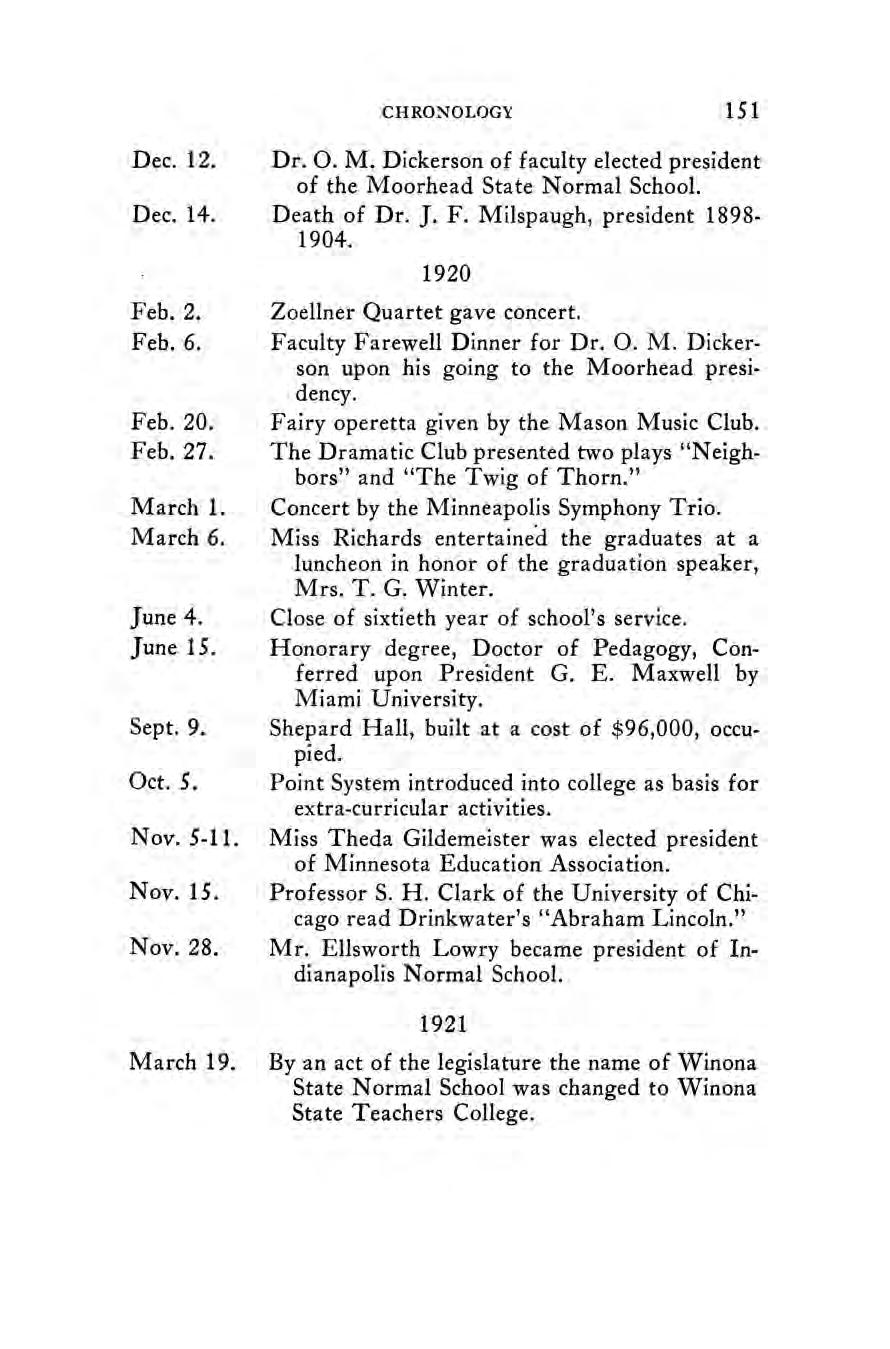
Feb. 2.
Feb. 6.
Feb. 20.
Feb. 27.
March 1.
March 6.
June 4.
June 15.
Sept. 9.
Oct. 5.
Nov. 5-11.
Nov. 15.
Nov. 28.
Dr. O. M. Dickerson of faculty elected president of the Moorhead State Normal School.
Death of Dr. J. F. Milspaugh, president 18981904.
Zoellner Quartet gave concert.
Faculty Farewell Dinner for Dr. O. M. Dickerson upon his going to the Moorhead presidency.
Fairy operetta given by the Mason Music Club.
The Dramatic Club presented two plays “‘Neighbors” and “The Twig of Thorn.”
Concert by the Minneapolis Symphony Trio.
Miss Richards entertained the graduates at a luncheon in honor of the graduation speaker, Mrs. T. G. Winter.
Close of sixtieth year of school’s service.
Honorary degree, Doctor of Pedagogy, Conferred upon President G. E. Maxwell by Miami University.
Shepard Hall, built at a cost of $96,000, occupied.
Point System introduced into college as basis for extra-curricular activities.
Miss Theda Gildemeister was elected president of Minnesota Education Association.
Professor S. H. Clark of the University of Chicago read Drinkwater’s “Abraham Lincoln.”
Mr. Ellsworth Lowry became president of Indianapolis Normal School.
1921
March 19,
By an act of the legislature the name of Winona State Normal School was changed to Winona State Teachers College.
April 14.

April 14.
April 21.
June 9.
Association of Minnesota State Normal Teachers was organized for the purpose of furthering normal school education in Minnesota.
School’s first outdoor track team organized.
G. S. Gaylord, on W.S.T.C. faculty since 1898, elected to a post in theschool of speech at "Northwestern University.
Dr. E. J. Starbuck delivered the commencement address.
March 3.
March 3.
April 22.
Sept. 29.
Nov. 11.
Dec. 3.
Professor Leroy Arnold of Hamline University spoke.
The Winona outline for the teaching of psychology was awarded third placein a national competition conducted by the National Council of Teachers Colleges, thirty schools participating.
Garvin Heights deeded to State by Mr. and Mrs. H. C. Garvin for use of college.
The school paper appeared under the name, ‘The Winonan.”
First homecoming.
The main building was destroyed by fire; library damaged.
March 23.
March 23.
March 29.
May 4.
June 6.
Governor J. A. O. Preus reappointed S. H. Somsen as resident director, Mr. Somsen having served since 1909,
Library building re-occupied after the fire.
A new state athletic conference for Junior Colleges was formed including Winona.
W. H. Burton, director of training school, resigned to study at the University of Chicago. Seniors presented ‘‘Yellow Jacket.”
June 7. June. July.
Oct. 16.
Oct. 19.
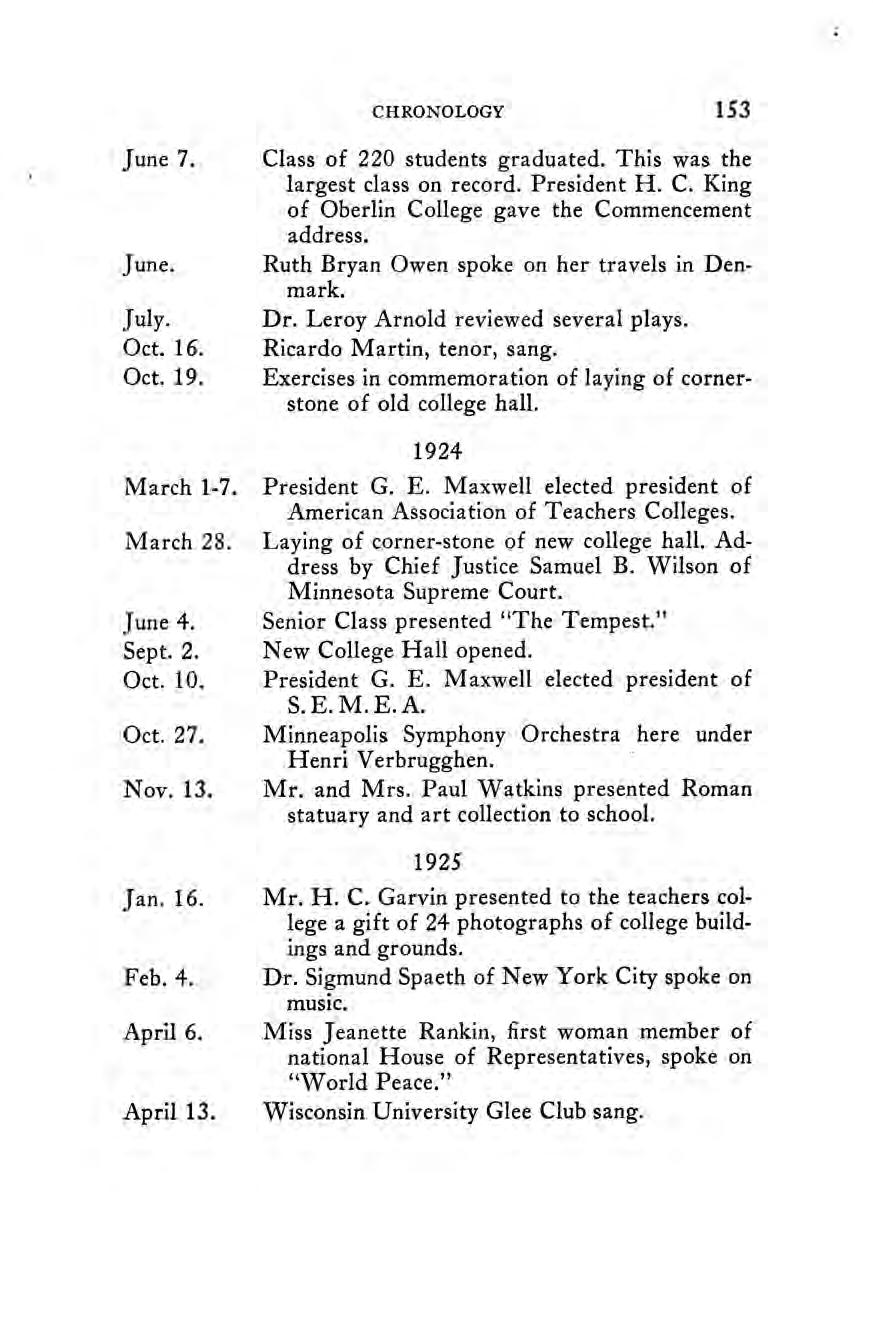
March 1-7.
March 28.
June 4.
Sept. 2.
Oct. 10.
Oct. 27.
Nov. 13.
Class of 220 students graduated. This was the largest class on record. President H. C. King of Oberlin College gave the Commencement address.
Ruth Bryan Owen spoke on her travels in Denmark,
Dr. Leroy Arnold reviewed several plays.
Ricardo Martin, tenor, sang.
Exercises in commemoration of laying of cornerstone of old college hall.
President G. E. Maxwell elected president of American Association of Teachers Colleges.
Laying of corner-stone of new college hall. Address by Chief Justice Samuel B. Wilson of Minnesota Supreme Court.
Senior Class presented “The Tempest.”
New College Hall opened.
President G. E. Maxwell elected president of
Minneapolis Symphony Orchestra here under Henri Verbrugghen.
Mr. and Mrs. Paul Watkins presented Roman statuary and art collection to school.
Jan. 16.
Feb. 4.
April 6. April 13.
Mr. H. C. Garvin presented to the teachers college a gift of 24 photographs of college buildings and grounds.
Dr. Sigmund Spaeth of New York City spoke on music.
Miss Jeanette Rankin, first woman member of national House of Representatives, spoke on ‘World Peace.”
Wisconsin University Glee Club sang.
April 24.
July 22.
Sept. 25.

Feb. 1.
Feb. 10.
April 16.
April 30.
May 11.
July 7.
Oct. 27.
Art collection of Mr. and Mrs. Paul Watkins formally accepted by the college. “Art Day.”
Miss Mary Grant, librarian since 1900, resigned.
All attendance records broken, with 600 enrolled.
1926
Dedication of Memorial Organ.
Tony Sarg’s marionettes delighted a large audience.
Miss Florence Richards attended convention of Minnesota Association of Women Deans, of which she is president.
Student-faculty adviser plan adopted.
Dr. A. E. Winship of Boston gave an address.
Dr. A. M. Harding of Department of Astronomy of the University of Arkansas gave an illustrated lecture. Band organized by Mr. Walter Grimm.
1927
Feb. 24.
March 2.
June 1.
June 1.
Nov. 9.
Jan. 14.
March 26.
W. W. Norton gave college $10,000 to be used as a scholarship fund.
College received $4,000 from Mrs. Emma B. Norton, to be known as Beulah Norton scholarship.
The constitution of the representative council was accepted by students.
Graduating classes presented “The Taming of the Shrew.”
Edwin Markham gave a lecture-recital to students of college and Phelps School.
1928
Henry L. Southwick, president of Emerson College of Oratory, spoke at assembly.
Russian Cossack Chorus gave concert.
April 27.

April 30.
Dec. 10.
Feb. 22.
April 8.
June 11.
Oct. 26.
Jan. 17.
April 15.
June 5.
July 18.
Nov. 7.
Nov. 25.
Jan. 30.
Feb. 26. Feb. 27.
President G. E. Maxwell announced the acceptance of two new scholarships, the World War Memorial Scholarship and the Kindergarten Scholarship.
Barrere’s Little Symphony Orchestra appeared in concert.
Swiss Bell Ringers here.
1929
Mr. and Mrs. Paul Watkins presented beautiful friezes of Greek Parthenon to the college.
President G. E. Maxwell was honored for his 25 years as president of the college.
Hamline University awarded an honorary doctorate to President G. E. Maxwell.
Drive started for 70th Year Scholarship Fund.
1930
The 1929. Wenonah received an All-American recognition from the National Scholastic Press Association.
David W. Anderson, novelist, gave a lecture at assembly.
College observed the 70th anniversary of its founding.
70th Year Scholarship fund reached nearly $14,000.
Alumni reorganized and incorporated under the laws of the state.
Wenonah Players presented “Disraeli.”
1931
W.S.T.C. presented its first Tuesday night broadcast over WKBH.
Welch Imperial Singers appeared in concert.
W.S.T.C. accredited as Class A School in American Association of Teachers Colleges.

March 27.
June 4.
Sept. 25.
Oct. 28.
Nov. 24.
Dec 3.
Dec. 27-31.
Four students enrolled from Philippine Islands.
Dr. Charles W. Gilkey, Dean of Chapel at University of Chicago, gave commencement address.
W.S.T.C. cooperative organization formed.
Laurence M. Brings of the Northwestern College of Speech Arts, Minneapolis, read ‘Broken Dishes.”
Wenonah Players presented ‘“‘Gold in the Hills.”
Cherniavsky Trio in recital.
The college sent a delegate to National Student Federation of America, meeting in Toledo.
1932
Feb. 4.
Feb. 4.
Feb. 18.
Mar. 20-25.
April 15-25.
Oct. 7.
Nov. 2.
Nov. 4.
Nov. 18.
Jan. 19.
Feb. 8.
Mantoux Test given faculty and students.
Apollo and Mendelssohn Clubs present Gilbert and Sullivan’s ““The Mikado.”
Mr. J. H. Sandt, industrial arts instructor since 1906, died. -
Alumni conducted an educational tour through Washington and New York.
Apollo Club on second annual tour.
J. M. McConnell, Commissioner of Education, spoke at assembly.
Miss Elizabeth Steen of the University of Callifornia, gave a lecture on Indian tribes in Brazil.
Miss Daisy Brown, class of 1905, elected president of M.E.A.
Miss Bertha Speckman, art teacher at Phelps School, concluded her service in the college. Her service on the staff began in 1892.
1933
Toscha Seidel, Russian violinist, in recital.
Dr. Wu spoke on “China Through Chinese Eyes.”
Feb.20.
May 10.
August 28.
Oct. 4.
Nov. 27.
Nov. 29.
Dec. 7.

Jan. 31.
Feb. 10.
March 21.
New York String Quartet in recital. The one-year rural program was discontinued by vote of the Teachers College Board.
“The Winonan” won first-class honor rating from National Scholastic Press Association.
Alonzo W. Pond, explorer, in lecture.
Hall Johnson Negro Choir in concert.
Debate team met debaters from Cambridge University, England.
Wenonah Players presented “Mr. Pim Passes By.”
1934
Eunice Norton gave a piano recital.
Gamma Tau chapter of Kappa Delta Pi installed by Dr. T. C. McCracken.
The will of the late L. L. Brown, it was announced, bequeathed $3,000 to the college as a scholarship fund.
April 20.
May 11.
May 11.
June 6.
Oct. 19.
Nov. 10.
Dec. 3.
Miss Theda Gildemeister announced forthcoming resignation after 36 years of service, 1898-1934.
Mendelssohn Club gave 34th annual concert with Johannes Fossum as guest violinist.
‘‘Winonan”’ received second-class rating by Columbia Scholastic Press Association.
Dr. D. J. Cowling, president of Carleton College, gave commencement address.
Homecoming opened Diamond Jubilee celebration.
Bohumir Kryl’s Symphony Band gave concert. Vera Brittain, author, in lecture.

Jan. 10. Vienna Boys Choir in concert, first under the Community Concert Service for the year.
March 3. Carola Goya in dance recital.
March 22. Dalies Frantz appeared in piano recital.
April 16. Barrere, Salzedo and Britt trio in recital.
May 29. Messrs. F. S. Bell and S. L. Prentiss completed by gift the north portion of the athletic field, proposing for the future the name, ‘Maxwell Field.”
June 5. Faculty appeared in academic procession and in academic costume for first time.


etettgen Ts stassctegsssert Petacetsteceseasian barpeweerieree Use was tswetees socectet ateregeeseeesesenttr be tisaskenecsnseie sh rae ererse pee +h alalabsccrsterevereroreans 7 bteriseiemeestecesisestiese: ta os eae ereryte tet yy tA tee ese St ereeetetetetet